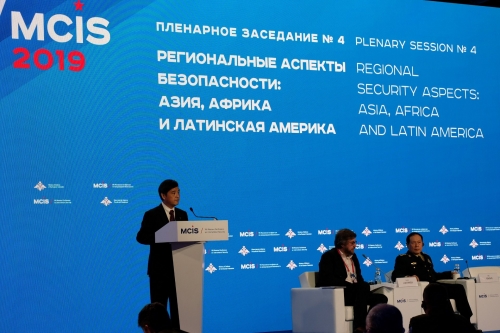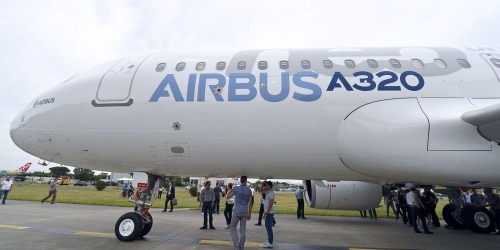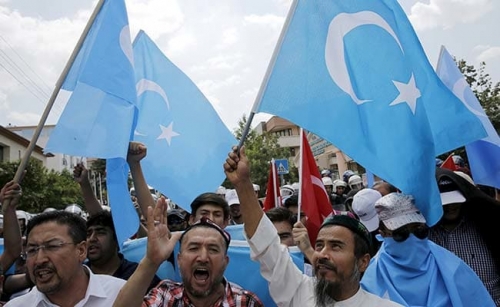samedi, 25 mai 2019
Les routes de la soie au prisme du néo-eurasisme de Douguine : retour de Béhémoth ou triomphe du Léviathan ?

Les routes de la soie au prisme du néo-eurasisme de Douguine : retour de Béhémoth ou triomphe du Léviathan ?
« La Grande Eurasie n’est pas un arrangement géopolitique abstrait, mais, sans exagération, un projet à l’échelle civilisationnelle, tourné vers l’avenir.»
Vladimir Poutine, mai 2017
« L’histoire mondiale est l’histoire de la lutte des puissances maritimes contre les puissances continentales et des puissances continentales contre les puissances maritimes »
Carl Schmitt, 1942
Au cœur de la stratégie politique et commerciale internationale de la Chine depuis 2013, le système multi-vectoriel de projets des nouvelles routes de la soie (appelé officiellement Belt and Road Initiative, BRI1 depuis mai 2017), qui souhaite connecter les économies chinoises, européennes, africaines et centre-asiatiques par une densification des réseaux d’infrastructures de transports et de communication, se concrétise chaque jour un peu plus sérieusement. Avec ses différents volets (construction d’infrastructures terrestres et maritimes, coopération économique, énergétique et sociétale), c’est sans doute l’entreprise la plus ambitieuse au monde et, au vu du potentiel de développement économique et des implications géopolitiques qu’elle comporte2, elle suscite de plus en plus de partenariats.
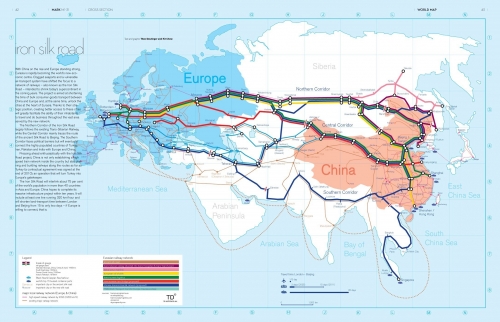
Le 9 avril dernier s’est ainsi tenu à Bruxelles le 21ème sommet Chine-Union Européenne, occasion pour l’UE de déterminer une position commune vis-à-vis de la BRI et de discuter des synergies possibles avec son plan européen de connectivité Europe-Asie4, alors que, l’une après l’autre, les nations européennes signent bilatéralement des engagements dans le projet5.
Bien plus que les timides rapprochements des Européens, c’est la perspective de l’édification d’un axe Moscou-Pékin autour de cette initiative qui soulève les analyses géopolitiques les plus audacieuses : Ressurgirait la vieille menace, préfigurée par Mackinder en 1904 dans les propos concluants son « Pivot géographique de l’histoire »6, d’une Chine qui offrirait aux ressources immenses du continent une large façade océanique (ce qui caractérisait pour lui le véritable « péril jaune » menaçant la liberté du monde). En somme un « empire terrien eurasiatique » dominant le Heartland pourrait émerger et reléguer les puissances maritimes occidentales au second rang dans la rivalité générale pour la domination mondiale.Un tel traitement nous ramènerait aux fondamentaux de la discipline par une réappropriation de la dialectique Terre-Mer pour analyser le phénomène routes de la soie. Elle fascine toujours autant de par sa dimension symbolique et son caractère quelque peu réducteur, la rendant accessible au plus grand nombre.
Cela dit, il est vrai que depuis 2014 Russie et Chine ont opéré un rapprochement bilatéral notable7 et coopèrent de plus en plus activement au travers de la BRI : ainsi en mai 2015 fut-il décidé que l’initiative d’intégration continentale portée par la Russie, l’Union économique eurasiatique (UEE), y soit raccordée8 et en novembre 2017 la « route maritime du Nord » est devenue un des corridors de la BRI9. On relève aussi l’imbrication de l’initiative avec le développement de la coopération sino-russe au sein de l’Organisation de Coopération de Shanghai (OCS)10.
De facto, une certaine unification continentale dans l’espace eurasiatique semble donc s’esquisser11. Ceci pourrait alors confirmer la portée heuristique persistante de la clé de lecture Terre-Mer. Mais c’est surtout lorsque l’on entre dans une géopolitique des perceptions que cette dialectique conserve sa pertinence : Il existe en effet un paradigme géopolitique affirmant explicitement la nécessité pour la Russie de briser l’hégémonie des puissances maritimes et de reconstituer une unité politique sur la masse continentale eurasiatique, notamment en développant un partenariat stratégique avec la Chine. Cette vision est portée par les auteurs constituant le mouvement d’idée du néo-eurasisme12. C’est une doctrine très en vue en Russie mais aussi dans d’autres États d’Asie Centrale, notamment au Kazakhstan où l’(ex-)président Nursultan Nazarbaev la soutient explicitement13.
Parmi les différents faisceaux composant le mouvement néo-eurasiste, un auteur se distingue : Alexandre Douguine14. Sa pensée, bien que plus marginale aujourd’hui, a connu ses heures de gloire et continue d’inspirer une partie des élites dirigeantes russes, tout en nourrissant bien des fantasmes chez les commentateurs étrangers15. S’il est issu de la pensée eurasiste classique, il y adjoint des filiations intellectuelles peu habituelles qui singularisent ses propositions, les amenant dans un registre métapolitique, métahistorique et culturaliste : Le monde des phénomènes n’est pour lui que le reflet des puissances archétypales qui le meuvent depuis l’invisible et sa pensée s’inscrit dans la bataille gramscienne16 pour l’« hégémonie culturelle »17.

Les analyses ne manquent pas pour venir questionner les convergences et les limites des projets russes et chinois au-regard des ambitions géopolitiques eurasistes, mais elles s’inscrivent généralement sur des plans stratégique, économique, financier, juridique. Dans cette étude, nous souhaiterions sortir de l’empire des faits pour plonger plus profondément dans le monde des idées. Nous proposerons une lecture du phénomène nouvelles routes de la soie à travers le prisme de la doctrine géopolitique d’Alexandre Douguine, en essayant de nous approprier son discours original, structurant la vision-du-monde de certains acteurs impliqués dans le complexe de la BRI.
Nous nous demanderons donc si la Belt and Road Initiative participe de la constitution d’un bloc continental eurasien face à la thalassocratie atlantiste compatible avec les fondamentaux proposés par Alexandre Douguine pour la politique étrangère russe.
Nous exposerons synthétiquement les contenus de la doctrine géopolitique douguinienne et nous verrons que si les projets de la BRI s’inscrivent bien dans un renversement de la hiérarchie des puissances à l’échelle globale marqué par une revalorisation de l’« île mondiale » – donc à un balancement au profit de la Terre –, l’initiative pourrait constituer, sur un plan plus culturaliste, une submersion du continent par la Mer.
Les fondamentaux de la géopolitique d’Alexandre Douguine : la dialectique Terre-Mer revisitée par la « pensée de la Tradition »
Alexandre Douguine s’inscrit dans une filiation géopolitique a priori classique, à la suite de Ratzel (1882, 1900), Mahan (1892), Castex (1935), Mackinder (1904), Spykman (1944), puisqu’il reprend la récurrente opposition Terre-Mer : « La civilisation thalassique, anglo-saxonne […] serait irréductiblement opposée à la civilisation continentale, russe-eurasienne »19, et le cœur de leur affrontement serait le contrôle du Rimland20. Il a surtout hérité des conceptions allemandes, adoptant un prisme foncièrement culturaliste21 : Il associe comme intrinsèques à la civilisation thalassique les attributs de « protestante, d’esprit capitaliste » tandis que la civilisation continentale serait « orthodoxe et musulmane, d’esprit socialiste ». Il figure parmi les tenants d’une approche plutôt déterministe de cette dichotomie, prise non seulement comme clé de compréhension de la politique au niveau global mais aussi comme véritable « explication de l’histoire ». C’est là toute l’originalité de notre auteur, puisqu’il établit un parallélisme entre cette dichotomie, devenue classique en géopolitique, et la dialectique Tradition-Modernité.
Ce second couple conceptuel n’est pas appréhendé selon ses présentations dans la littérature anthropologique ou sociologique, mais entendu selon l’acception originale portée par une école parfois qualifiée de « pensée de la Tradition »22 qui présente des catégories de pensée très éloignées de celles que l’on rencontre habituellement dans le monde académique contemporain et déployée à la suite de l’œuvre du Français René Guénon. La Tradition renvoie chez ces auteurs « traditionistes »23 à une « Sagesse Éternelle » (Sophia Perennis), une connaissance sacrée, immuable et transcendante transmise aux hommes depuis l’origine de l’humanité. Cette Tradition connaîtrait cependant nécessairement un processus d’obscurcissement à travers les âges (afin que toutes les possibilités de l’Être se manifestent, même les plus inférieures), l’avènement du monde moderne correspondant selon eux à la dernière étape de cette dégradation, une ère chaotique précédent la résorption du monde dans l’incréé – ce que l’on retrouve dans les traditions spirituelles comme étant la « fin des temps ». Pour de tels auteurs, la politique ou l’histoire n’ont de sens qu’en tant qu’elles révèlent l’incarnation de principes métaphysiques – ou archétypes – c’est pourquoi nous évoquions en introduction les termes de métapolitique24 et de métahistoire.
Douguine reprend ces conceptions et s’inscrit parmi ces auteurs traditionistes : Chez lui, la puissance maritime « atlantiste » représenterait les forces de dissolution entraînant le monde moderne vers le chaos, tandis que l’Eurasie aurait pour vocation d’être le bastion de la Tradition, le katechon paulinien25 résistant à la venue des Temps. Ainsi dans son œuvre « l’eschatologie se mêle à la géopolitique », puisqu’il la déploie à partir de postulats visant à se positionner politiquement en fonction des fins dernières de l’homme et des entités politiques. Ce prisme métaphysique l’amène à étudier la politique, l’histoire ou la géographie seulement à travers les principes supérieurs qu’elles incarnent. La Russie et les puissances eurasiatiques deviennent l’incarnation de l’archétype structurant « Terre » (Béhémoth), représentant la Tradition, tandis que les stratégies des États-Unis et de leurs alliés sont lues comme faisant le jeu de l’archétype dissolvant « Mer » (Léviathan), associé aux idéologies modernes. Depuis ces postulats, Douguine propose de « constituer un grand bloc continental eurasien » (versant géopolitique) qui se veut « une force intégratrice, un esprit de renaissance »26 (versant eschatologique) en vue d’édifier un modèle multipolaire pour le système international.
Afin de réaliser cette ambition il propose dès les années 1990, en tant qu’« impératif stratégique majeur » pour la Russie, d’intégrer les pays de la CEI dans une Union Eurasienne fédéraliste : « une seule formation stratégique, unie par une seule volonté et par un seul but de civilisation commune »27. À partir de cette base, il appelle cette entité eurasienne à se rapprocher de ses « partenaires naturels » car en situation de « complémentarité symétrique » avec la Russie : UE, Japon, Iran, Inde. Ceux-ci pourraient devenir de véritable « sujets » des Relations internationales et de la mondialisation s’ils participaient à la sortie du système uni-polaire américano-centré (dans lequel ils n’en seraient que des « objets ») pour construire ensemble la multipolarité. Leur partenariat avec la Russie serait pour Douguine gagnant-gagnant, un renforcement mutuel, étant donné qu’ils ont chacun des éléments vitaux à échanger. D’autres formations géopolitiques intéressées par la multipolarité seraient ensuite encouragées à appuyer ce projet de ré-agencement du système international : Chine, Pakistan, pays arabes… alors que le Tiers-Monde serait plutôt partagé en zones d’influence pour des champions régionaux (le Pacifique constituerait la zone d’influence nippone, l’ Afrique la zone d’influence européenne… ici aussi on retrouve l’influence de l’école géopolitique allemande et des pan-ideen de Haushofer). La thalassocratie étasunienne serait quant à elle refoulée dans l’espace américain (sa zone d’influence naturelle). Ainsi aurait-on des entités géopolitiques puissantes avec leurs zones d’influences propres et un certain équilibre entre les pôles. Cet équilibre multipolaire permettrait alors à la puissance tellurique de laisser se redéployer la Tradition.
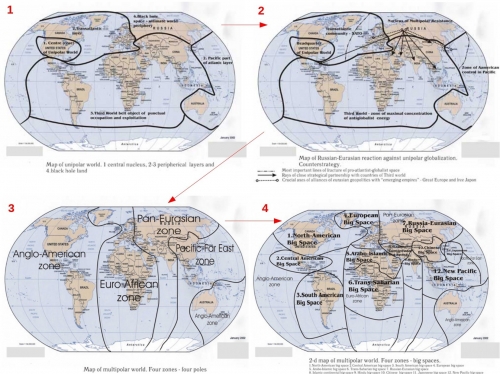
La question que nous poursuivons ici est de savoir si la BRI serait pour Douguine un vecteur potentiel pour ses propositions. Participe-t-elle de l’élan vers la « multipolarité traditionnelle » qu’il appelle de ses vœux ? Voyons alors quels élément dans les projets des nouvelles routes de la soie peuvent être décryptés comme participants des ambitions telluriques néo-eurasistes de réagencement du système international dont nous connaissons maintenant les fondamentaux.
La BRI, facteur d’intégration eurasiatique dans le cadre d’une redistribution globale des cartes de la puissance : quelle compatibilité avec le projet multipolaire néo-eurasiste ?
Vers la multi-polarisation
De prime abord, on peut considérer la BRI comme s’inscrivant dans une stratégie d’émancipation de l’uni-polarité américano-centrée. Comme évoqué en introduction, la BRI vise à développer des lignes de communication routières, ferroviaires et maritimes pour relier la Chine à l’Europe et à l’Afrique orientale, via l’Asie Centrale, le Caucase, la Russie, l’Iran, la Turquie… Couplée avec les initiatives menées dans l’OCS et l’UEE, l’initiative s’imbrique donc dans une stratégie générale d’intégration du Rimland avec la masse eurasiatique29, passant outre les instances multilatérales et les canaux de communications ouverts et normés par les États-Unis.
Ces ambitions pourraient donc bien conduire à la définition de normes non-américaines ou non-occidentales30. On le voit par exemple dans le système d’institutions financières élaboré pour financer les projets de la BRI : Banque asiatique d’investissements pour les infrastructures, Fonds Routes de la soie, Nouvelle banque de développement des BRICS, associés à un appel aux fonds souverains des États impliqués dans le projet et aux banques commerciales, les projets se financeraient hors de l’orbite de la Banque mondiale (présidée depuis 1944 par un Américain) et du Fonds monétaire international, symboles de la domination internationale des normes américaines.
Vers la re-continentalisation
L’économie mondiale est à l’heure actuelle essentiellement dépendante des flux maritimes. Cette maritimisation des flux a conduit à une littoralisation des activités de production et donc de la démographie mondiale. En effet, puisqu’il faut exporter via les ports, les entreprises se sont rapprochées des côtes, entraînant alors des mouvements de population à la recherche d’emplois. La BRI, en faisant la part belle aux tracés terrestres, pourrait participer d’une re-continentalisation des supports logistiques de l’économie mondiale et, ce faisant, d’une re-continentalisation de ses pôles de productions.
C’est notamment le vecteur ferroviaire qui semble le plus porteur, grâce à une capacité d’emport supérieure et un coût inférieur de 80 % au transport aérien, pour des échanges deux fois plus rapide que par voie maritime31. Si 7500 conteneurs ont transité sur des trains intercontinentaux en 2012, l’objectif est de porter ce nombre à 7.500.000 pour 2020. Pour profiter de ces flux logistiques, de grandes entreprises telles Hewlett Packard ou Ford se sont déjà délocalisées depuis les côtes chinoises vers l’intérieur des terres pour se positionner sur ces lignes de trains prometteuses32.
Compatibilité de la BRI avec le projet néo-eurasiste : Multipolarité et continentalité ne suffisent pas, l’aspect culturel demeure le plus important
Ces dimensions, « terrestre » et multipolaire, semblent faire entrer la BRI en résonance avec les ambitions du projet néo-eurasiste d’Alexandre Douguine. À l’occasion du Belt and Road Forum de mai 2017, Vladimir Poutine a pu adopter la rhétorique néo-eurasiste en affirmant que grâce à des «formats d’intégration tels que la CEEA, l’OBOR, l’OCS et l’ASEAN, nous pouvons bâtir les bases d’un partenariat eurasien plus vaste» offrant une «occasion unique de créer un cadre de coopération commun qui va de l’Atlantique jusqu’au Pacifique, pour la première fois dans l’histoire». Il ajoute «La Grande Eurasie n’est pas un arrangement géopolitique abstrait, mais, sans exagération, un projet à l’échelle civilisationnelle, tourné vers l’avenir.»33.
Pour autant, même si la BRI renforçait l’organisation multipolaire du système international, et à supposer que la Chine laissera une place à la Russie dans ce nouvel ordre malgré l’asymétrie de leur relation, cela ne toucherait pas l’essence du projet néo-eurasiste. Car, au vu de ce que nous avons esquissé plus haut concernant la pensée traditionnelle, dans la philosophie archétypale douguinienne ce n’est pas la forme qui importe mais le fond, l’esprit. Aussi sa critique de l’uni-polarité thalassocratique ne concerne pas tant la maritimisation de l’économie mondiale que l’esprit maritime qui uniformiserait le monde. C’est pourquoi même si on assistait au reflux de la thalassocratie américaine par la multi-polarisation du système international et à une re-continentalisation de l’économie et de la démographie, une maritimisation culturelle du continent pourrait avoir lieu (un changement du « morphotype » sans modification du « psychotype »).
Cet esprit maritime est caractérisé par Carl Schmitt, l’une des racines intellectuelles d’Alexandre Douguine, qui veut montrer (selon Alain de Benoist, préfaçant la dernière édition de Terre et Mer de Schmitt) la relation logique entre la vie maritime et le libre-échangisme, le capitalisme, le libéralisme, l’individualisme, le parlementarisme, le droit-de-l’hommisme, le constitutionnalisme34… De plus, la « société liquide » (Bauman, 2000) trans-nationaliste créée par la civilisation océanique marchande amènerait peu à peu au délitement du politique, à l’enfoncement dans le fluctuant, le mouvant, le nomade, le réticulaire, le transitoire, à la fragmentation des identités et des sociétés dans l’homogénéité des flots35. Ce sont ces caractéristiques qui sont accolées chez Douguine à la thalassocratie et à la modernité. Le combat eurasiste ne serait donc pas gagné si cette mentalité continuait de s’imposer aux esprits. La multipolarité sans le souffle de la Tradition et la verticalité de la Terre ne serait pas plus souhaitable pour le néo-eurasiste que le système actuel.
Or la BRI est imprégnée à un certain niveau par cette mentalité moderniste : esprit marchand, capitalistique, libre-échangiste et faisant une large place aux marchés financiers ; réticulation de l’espace eurasien, recherche de la vitesse, du mouvement transfrontalier plutôt que de l’ancrage (les marchandises, les capitaux, les travailleurs seront amenés à migrer) ; le tout étant porté par une Chine maoïste, et donc héritière des idées révolutionnaires de 1789, athée, technocratique, pragmatique.
Bien évidemment, les dimensions libérales et constitutionnalistes qui termineraient de caractériser l’esprit maritime sont absentes. Nous sommes essentiellement face dans l’espace eurasien à des puissances (semi-)autoritaires, des démocratures (Max Liniger-Goumaz, 1992) pour qui la souveraineté, le politique, l’Ordre et l’identité (caractéristiques telluriques) sont encore des valeurs importantes (c’est pourquoi Douguine accorde une certaine dimension « traditionnelle » à l’idéologie socialiste, pourtant moderne36). Néanmoins, si l’on suit les auteurs de tendance contre-révolutionnaire, l’esprit moderne-maritime s’est imposé en Occident parce qu’une caste marchande transnationale a pu se constituer et se renforcer jusqu’à s’imposer politiquement pour ensuite dissoudre peu à peu cet ordre politique. Aussi la BRI pourrait-elle donc être l’ouverture nécessaire à la constitution d’une telle caste dans l’espace eurasiatique qui viendrait à terme renverser les valeurs telluriques prônés par Douguine.
Conclusion
Nous avons eu pour but dans cette étude de caractériser le projet des nouvelles routes de la soie au regard de la dialectique Terre-Mer « pérennialiste » d’Alexandre Douguine, qui peut être prise comme un croisement des pensées de Carl Schmitt et de René Guénon. La question était donc de savoir si ces projets constituaient une opportunité pour l’acheminement vers un système international multipolaire accompagné d’une réaffirmation des principes telluriques traditionnels dans l’ordre international – une « domination culturelle » de Béhémoth – ou au contraire s’ils favorisaient l’ouverture vers une diffusion de la mentalité thalassique et moderniste à tout l’espace eurasiatique – le « triomphe » de Léviathan.
Nous avons vu que la coopération stratégique sino-russe autour de la BRI, dans l’hypothèse où la Chine maintiendrait un partenariat équitable envers la Russie, pourrait conduire à une multi-polarisation du système international, avec un continent eurasiatique autonome vis-à-vis de la thalassocratie étasunienne, ce qui constitue le premier versant (géopolitique) du projet néo-eurasiste d’Alexandre Douguine. Cependant, si l’on considère les choses en profondeur et d’un point de vue culturel, l’initiative pourrait porter les germes de l’esprit moderne-maritime qu’il pourfend, le versant eschatologique de son projet serait alors condamné. En vue de constituer ce front de la Tradition37 qu’il appelle de ses vœux, son combat pour l’hégémonie culturelle ne s’arrêterait pas là, il lui faudra encore proposer un modèle permettant d’intégrer les tendances marchandes modernes dans un ordre tellurique politique traditionnel à l’échelle continentale et de maintenir les ancrages identitaires des peuples eurasiatiques.
Ainsi, au regard des fondamentaux de la vision douguinienne, nous pensons que les projets de la BRI pourraient caractériser une véritable croisée des chemins pour les Relations internationales : En effet, l’initiative porte en elle l’opportunité de voir se réaffirmer un ordre du monde basé sur des principes différents de ceux de la mentalité moderne occidentale, tout en comportant le risque de voir cette mentalité se diffuser rapidement au sein du « cœur du monde ». Au-delà même de la perspective eschatologique supportée par Douguine, nous pouvons y voir un réel enjeu en matière de diversité culturelle mondiale : la tension entre différentialisme et uniformisation, représentée chez Schmitt ou Douguine par le combat entre Béhémoth et le Léviathan (la Terre et la Mer au plan non plus géographique mais presque purement mental), est bien réelle !
***
Au delà de cette étude particulière, l’influence de Douguine sur la politique mérite selon nous d’être questionnée et étudiée, cet auteur connaissant une visibilité certaine tant en Russie que dans certaines mouvances idéologiques ouest-européennes. Cependant, si son discours géopolitique rencontre un certain écho et peut emporter l’adhésion parmi les élites russes, l’aspect « gnostique » de ses théories reste bien plus marginal (car estimé irrationnel, idéaliste, hors des critères de la pensée moderne, ou incompris, de par sa difficulté d’accès pour le grand public). Aussi est-il probable que si en apparence le néo-eurasisme et la politique étrangère russe convergent, le dessein recherché soit tout autre : D’un côté nous aurions une politique étrangère réaliste, somme toute moderne bien que conservatrice mais utilisant par opportunité la rhétorique néo-eurasiste, de l’autre une vision traditionnelle métaphysique dont les ambitions ne sont portées que par une minorité restreinte. Nous pensons toutefois que des études politologiques sur l’influence de sa pensée dans le champ des idées et des mouvements politiques serait pertinentes.
Sur un plan plus théorique, une étude conceptuelle sérieuse du couple Tradition-Modernité, confronté avec la réalité empirique, pourrait également offrir selon nous une clé herméneutique intéressante pour la discipline géopolitique, cette dialectique entendue dans son sens guénonien renvoyant à des double-mouvements (différenciation-uniformisation, conservatisme-progressisme, ancrage-nomadisme…) que l’on peut retrouver au cœur de la plupart des rivalités de puissance dans l’espace mondial.
Notes:
1 En chinois, le programme s’intitule Yidai yilu, « Une ceinture, une route » (« One Belt One Road », OBOR). En anglais, l’expression officiellement utilisée par Pékin est toutefois Belt and Road Initiative (BRI).
2 Pour une présentation synthétique du projet, voir notamment : LASSERRE Frédéric et MOTTET Eric, « L’initiative Belt and Road, stratégie chinoise du Grand Jeu ? », Diplomatie, numéro 90, 2018/1, pp. 36-40.
3 Visible sur : « First Chinese Train Arrives in Tehran to Revive Silk Road », Strategic Demands Online, 15 février 2016. URL: https://strategicdemands.com/eurasia-newsilkroad/
4 Voir « 21e sommet Chine Union Européenne: vers plus de connectivité ! », OBOReurope, 11 avril 2019.
URL: https://www.oboreurope.com/fr/21e-sommet-chine-union-euro...,consulté le 11 avril 2019.
5 Ont déjà été signés des memorandums ou accords d’intégration entre la RPC et le Luxembourg, l’Italie, la Grèce, le Portugal, mais aussi la Lettonie, la Croatie, la Bulgarie ou Monaco. La Deutsche Bahn s’implique aussi financièrement, notamment par des investissement sur la principale ligne ferroviaire Pologne-Chine Voir « Qu’est que l’accord entre la Chine et l’Italie ? », OBOReurope, 24 mars 2019 (URL : https://www.oboreurope.com/fr/accord-chine-italie/, consulté le 11 avril 2019) et CLAIRET Sophie, « Pourquoi l’Europe risque de se perdre sur les nouvelles routes de la soie ? », GeoSophie, 6 janvier 2017 (URL : https://geosophie.eu/2017/02/05/pourquoi-leurope-risque-d..., consulté le 8 avril 2019).
6 MACKINDER Halford, « The Geographical Pivot of History », The Geographical Journal, vol. 23, 1904/4, pp. 421-437, p. 437 pour ces propos.
7 Voir BOULEGUE Mathieu, « La « lune de miel » sino-russe face à l’(incompatible) interaction entre l’Union Economique Eurasienne et la Belt & Road Initiative », Diploweb, 15 octobre 2017.
URL : https://www.diploweb.com/La-lune-de-miel-sino-russe-face-... consulté le 9 avril 2019.
8 Voir ALEXEEVA Olga, « Le partenariat stratégique Chine-Russie : une alliance durable ? », Areion 24 news, 25 janvier 2019.
URL : https://www.areion24.news/2019/01/25/le-partenariat-strat... consulté le 9 avril 2019.
9 Voir « La route polaire et l’initiative Belt and Road », OBOReurope, 7 novembre 2017 (URL: https://www.oboreurope.com/fr/route-polaire/, consulté le 10 avril 2019). Voir aussi BRUNEAU Michel, L’Eurasie. Continent, empire, idéologie ou projet, Paris, CNRS éditions, 2018, pp. 294-295.
10 Laquelle a une réalité géopolitique conséquente : elle vise à faire coopérer politiquement des pays représentants 2.758.000.000 d’habitants, 38% des approvisionnements en gaz naturel, 20% du pétrole, 40% du charbon et 50% de l’uranium disponibles sur la planète. Voir DUPUY Emmanuel, « Les nouvelles Routes de la Soie et l’Asie Centrale : l’Organisation de Coopération de Shanghai (OCS) en première ligne… », La Vigie, 16 novembre 2017 (URL : https://www.lettrevigie.com/blog/2017/11/16/les-nouvelles..., consulté le 4 avril 2019)
11 BOUCHARD Renaud et PORFIRYEV Boris, « L’économie russe et le basculement géostratégique », conférence donné dans le cadre du séminaire Franco-Russe « L’intégration eurasiatique en perspective / Евразийская интеграция в перспективе », Paris, EHESS, 14 septembre 2016 – 16 septembre 2016. URL : http://renaudbouchard.canalblog.com/archives/2016/09/22/3..., consulté le 6 avril 2019.
12 L’expression néo-eurasisme distingue ces auteurs du mouvement d’idées qualifié d’eurasisme classique, héritier du mouvement slavophile du XIXème siècle et qui finira par se rapprocher de la « révolution conservatrice » allemande. Pour l’histoire intellectuelle de ces mouvements, voir notamment : MEAUX (de) Lorraine, La Russie et la tentation de l’Orient, Paris, Fayard, 2010, 436 pages ; DRESSLER Wanda (dir.), Eurasie : espace mythique ou réalité en construction ?, Bruxelles, 2009, Bruylant, 410 pages (particulièrement pp. 49-68 et 95-106) ; SEDGWICK Mark, Contre le Monde Moderne. Le traditionalisme et l’histoire intellectuelle secrète du XXème siècle, Paris, Dervy, 2008, 380 pages (particulièrement pp/ 287 et ss.).
13 LARUELLE Marlène, « Le néo-eurasisme russe. L’empire après l’empire ? », Cahiers du monde russe [En ligne], 42/1, 2001, mis en ligne le 01 janvier 2007, pp. 71-94.URL: https://journals.openedition.org/monderusse/8437#bodyftn2, consulté le 5 avril 2019.
14 Philosophe, géopoliticien, écrivain et militant politique, né le 7 janvier 1962 à Moscou.
15 Par ses théories et son apparence physique, Alexandre Douguine est régulièrement qualifié de « Raspoutine », de « conseiller occulte du Kremlin », nourrissant des analyses assez éloignées de la réalité de son influence et parfois teintées d’un esprit « complotiste ».
16 Le concept d’hégémonie culturelle a été pensé par Antonio Gramsci, qui a décrit comment une classe dominante faisait aussi reposer son pouvoir sur une domination culturelle, à travers des outils tels que l’école ou les médias. Il s’agit alors pour les forces d’opposition de conquérir les esprits en diffusant au maximum leurs idéologies avant de pouvoir renverser le rapport de domination (préalable sans lequel le nouveau pouvoir ne saurait être accepté par la population), d’où la formule utilisée de « bataille gramscienne ».
17 MOHAMMEDI Adlène, « Le « néo-eurasisme » d’Alexandre Douguine : une revanche de la géographie sur l’histoire ? », Philitt, 4 juillet 2016. URL : https://philitt.fr/2016/07/04/le-neo-eurasisme-dalexandre... , consulté le 4 avril 2019.
18 Photographie publiée en ligne sur le site Geopolitica.ru. URL : https://www.geopolitica.ru
19 Le Prophète de l’Eurasisme. Alexandre Douguine, Paris, Avatar Éditions, 2006, pp. 16.
20 Définit par Spykman comme « une région intermédiaire située […] entre le Heartland (cœur du monde) et les mers périphériques […] vaste zone tampon de conflits entre la puissance maritime et la puissance terrestre. Orientée des deux côtés, elle doit fonctionner de manière amphibie et se défendre aussi bien sur terre qu’en mer », car « Celui qui domine le Rimland domine l’Eurasie ; celui qui domine l’Eurasie tient le destin du monde entre ses mains ». Voir SPYKMAN Nicolas, The Geography of the Peace, New York, Harcourt, Brace and Co, 1944, p. 43.
21 La dialectique Terre-Mer est appréhendée dans la littérature géopolitique de façon plus ou moins pragmatique – conception surtout présente chez les Anglo-saxons – ou plus ou moins culturaliste – appréhension plutôt rencontrée chez les auteurs Allemands.
22 Formulation retenue par Christophe Boutin, voir BOUTIN Christophe, Politique et tradition. Julius Evola dans le siècle (1898-1974), Paris, Éditions Kimé, 1992, 513 pages ; Id., « Tradition et réaction : la figure de Julius Evola », In., « Les pensées réactionnaires », Mil neuf cent, n°9, 1991, pp. 81-97.
23 Néologisme proposé par le philosophe Pierre Riffard pour éviter les confusions avec le terme de « traditionalistes », utilisé aussi pour parler de courants politiques ou religieux réactionnaires. Voir : RIFFARD Pierre, L’Ésotérisme, Paris, Robert Laffont, 2003 (1990), 1032 pages. On rencontre parfois le terme « pérennialistes », bien qu’il vise plutôt la frange du mouvement développée sur le continent nord-américain. Voir HOUMAN Setareh, De la Philosophia Perennis au pérennialisme américain, Milan, Archè, 2010, 622 pages.
24 Le mot métapolitique est « à celui de politique ce que le mot métaphysique est à celui de physique […] la métaphysique de la politique » (MAISTRE Joseph (de), Considérations sur la France suivi de l’Essai sur le principe générateur des constitutions, Bruxelles, 2006 (1797), Éditions Complexe, p. 227), et vise à donner à une philosophie politique un fondement d’universalité par la référence à une vérité transcendante, le but étant d’orienter l’être et la société vers cette sphère, de traduire cette transcendance dans la réalité sociale en réfléchissant à l’organisation idéale de la Cité. Sous cette acception, le concept est à distinguer tant de la théologie politique (qui est le transfert de concepts théologiques dans le processus de construction de l’État) que du conservatisme (car il ne se réfère pas au passé mais à la métaphysique immuable, éternelle, supra-temporelle) ou de l’intégrisme (car il ne se réfère pas à une tradition spirituelle particularisée, mais à une Vérité absolue devant être supérieure à ces traditions). Voir BISSON David, René Guénon. Une politique de l’esprit, Paris, Pierre Guillaume de Roux, 2013, 527 pages, pp. 130 et s., qui utilise le triptyque infra-politique, politique, méta-politique comme clé méthodologique pour analyser l’impact de l’œuvre de Guénon.
25 Entité évoqué par l’apôtre saint Paul, le katechon est un être dont la nature n’est pas précisée et qui a pour vocation d’empêcher la venue de l’Antéchrist. Ce dernier ne peut se manifester pleinement tant que cette entité est dans le monde Voir dans la Bible les versets : 2 Thes. 2, 6-7.
26 Le Prophète de l’Eurasisme, op. cit, p. 19.
27 Ibid., p. 29.
28 Visible sur le site du mouvement EVRAZIA : http://evrazia.org/modules.php?name=News&file=article.... La carte 1 représente le monde unipolaire actuelle, la 2 la contre-stratégie que doit déployer la Russie pour briser l’uni-polarité, la 3 révèle les futures grandes zones d’influence souhaitées par le projet néo-eurasiste et la 4 les « grands espaces » géopolitiques au sein de ces zones.
29 STRUYE DE SWIELANDE Tanguy, « La Chine et ses objectifs géopolitiques à l’aube de 2049 », in « Regards géopolitiques », Bulletin du Conseil québécois d’études géopolitiques, volume 2, n°1, printemps 2016, pp. 24-28.
30 GARCIN Thierry, « Le chantier – très géopolitique – des Routes de la soie », Diploweb, 18 février 2018.
URL : https://www.diploweb.com/Le-chantier-tres-geopolitique-de..., consulté le 10 avril 2019.
31 LASSERRE Frédéric et MOTTET Eric, « L’initiative Belt and Road, stratégie chinoise du Grand Jeu ? », op. cit.
32 FRANKOPAN Peter, Les Routes de la Soie. L’histoire du cœur du monde, Bruxelles, Éditions Nevicata, 2017, p. 622.
33 ESCOBAR Pepe, « Vladimir Poutine s’aligne avec Xi Jinping pour élaborer un nouvel ordre mondial (commercial) », RTFrance, 17 mai 2017.
URL : https://francais.rt.com/opinions/38470-vladimir-poutine-a..., consulté le 9 avril 2019.
34 Voir SCHMITT Carl, Terre et Mer (1942), Paris, Pierre Guillaume de Roux, 2017, p. 63.
35 Ibid., p. 66-67.
36 De toute manière, selon les postulats métaphysiques retenus par les auteurs comme Douguine, il n’existe aucun étant « pur » : tout ce qui est manifesté est constitué d’un dosage entre les différentes polarités. Concrètement, il ne peut exister d’entité entièrement tellurique ou entièrement thalassique.
37 En référence à l’ouvrage : DOUGUINE Alexandre, Pour le Front de la Tradition, Nantes, Ars Magna, 2017.
BIBLIOGRAPHIE
Ouvrages
––, Le Prophète de l’Eurasisme. Alexandre Douguine, Paris, Avatar Éditions, 2006, 349 p.
BISSON David, René Guénon. Une politique de l’esprit, Paris, Pierre Guillaume de Roux, 2013, 527 pages
BRUNEAU Michel, L’Eurasie. Continent, empire, idéologie ou projet, Paris, CNRS éditions, 2018, 352 pages.
BOUTIN Christophe, Politique et tradition. Julius Evola dans le siècle (1898-1974), Paris, Éditions Kimé, 1992, 513 pages
DRESSLER Wanda (dir.), Eurasie : espace mythique ou réalité en construction ?, Bruxelles, 2009, Bruylant, 410 pages.
FRANKOPAN Peter, Les Routes de la Soie. L’histoire du cœur du monde, Bruxelles, Éditions Nevicata, 2017, 732 pages.
HOUMAN Setareh, De la Philosophia Perennis au pérennialisme américain, Milan, Archè, 2010, 622 pages.
MAISTRE Joseph (de), Considérations sur la France suivi de l’Essai sur le principe générateur des constitutions, 2006 (1797), Éditions Complexe
MEAUX (de) Lorraine, La Russie et la tentation de l’Orient, Paris, Fayard, 2010, 436 pages.
RIFFARD Pierre, L’Ésotérisme, Paris, Robert Laffont, 2003 (1990), 1032 pages.
SCHMITT Carl, Terre et Mer (1942), Paris, Pierre Guillaume de Roux, 2017, 240 pages.
SEDGWICK Mark, Contre le Monde Moderne. Le traditionalisme et l’histoire intellectuelle secrète du XXème siècle, Paris, Dervy, 2008, 380 pages.
SPYKMAN Nicolas, The Geography of the Peace, New York, Harcourt, Brace and Co, 1944, 66 pages.
Articles
BOUTIN Christophe, « Tradition et réaction : la figure de Julius Evola », in., « Les pensées réactionnaires », Mil neuf cent, n°9, 1991, pp. 81-97.
LASSERRE Frédéric et MOTTET Eric, « L’initiative Belt and Road, stratégie chinoise du Grand Jeu ? », Diplomatie, numéro 90, 2018/1, pp. 36-40.
MACKINDER Halford, « The Geographical Pivot of History », The Geographical Journal, vol. 23, 1904/4, pp. 421-437.
STRUYE DE SWIELANDE Tanguy, « La Chine et ses objectifs géopolitiques à l’aube de 2049 », in « Regards géopolitiques », Bulletin du Conseil québécois d’études géopolitiques, volume 2, n°1, printemps 2016, pp. 24-28.
Articles en ligne
ALEXEEVA Olga, « Le partenariat stratégique Chine-Russie : une alliance durable ? », Areion 24 news, 25 janvier 2019.URL : https://www.areion24.news/2019/01/25/le-partenariat-strat...
BOUCHARD Renaud et PORFIRYEV Boris, « L’économie russe et le basculement géostratégique », conférence donné dans le cadre du séminaire Franco-Russe « L’intégration eurasiatique en perspective / Евразийская интеграция в перспективе », Paris, EHESS, 14 septembre 2016 – 16 septembre 2016. http://renaudbouchard.canalblog.com/archives/2016/09/22/3...
BOULEGUE Mathieu, « La « lune de miel » sino-russe face à l’(incompatible) interaction entre l’Union Economique Eurasienne et la Belt & Road Initiative », Diploweb, 15 octobre 2017 https://www.diploweb.com/La-lune-de-miel-sino-russe-face-...
CLAIRET Sophie, « Pourquoi l’Europe risque de se perdre sur les nouvelles routes de la soie ? », GeoSophie, 6 janvier 2017.URL : https://geosophie.eu/2017/02/05/pourquoi-leurope-risque-d...
DUPUY Emmanuel, « Les nouvelles Routes de la Soie et l’Asie Centrale : l’Organisation de Coopération de Shanghai (OCS) en première ligne… », La Vigie, 16 novembre 2017 URL : https://www.lettrevigie.com/blog/2017/11/16/les-nouvelles...
ESCOBAR Pepe, « Vladimir Poutine s’aligne avec Xi Jinping pour élaborer un nouvel ordre mondial (commercial) », RTFrance, 17 mai 2017.URL : https://francais.rt.com/opinions/38470-vladimir-poutine-a...
GARCIN Thierry, « Le chantier – très géopolitique – des Routes de la soie », Diploweb, 18 février 2018. URL : https://www.diploweb.com/Le-chantier-tres-geopolitique-de...
LARUELLE Marlène, « Le néo-eurasisme russe. L’empire après l’empire ? », Cahiers du monde russe [En ligne], 42/1, 2001, mis en ligne le 01 janvier 2007, pp. 71-94. https://journals.openedition.org/monderusse/8437#bodyftn2
MOHAMMEDI Adlène, « Le « néo-eurasisme » d’Alexandre Douguine : une revanche de la géographie sur l’histoire ? », Philitt, 4 juillet 2016.https://philitt.fr/2016/07/04/le-neo-eurasisme-dalexandre...
« 21e sommet Chine Union Européenne: vers plus de connectivité ! », OBOReurope, 11 avril 2019.
URL: https://www.oboreurope.com/fr/21e-sommet-chine-union-euro...
« La route polaire et l’initiative Belt and Road », OBOReurope, 7 novembre 2017.URL: https://www.oboreurope.com/fr/route-polaire/
« Qu’est que l’accord entre la Chine et l’Italie ? », OBOReurope, 24 mars 2019 https://www.oboreurope.com/fr/accord-chine-italie/
Cartes
BOUCHARD Renaud et PORFIRYEV Boris, « L’économie russe et le basculement géostratégique », conférence donné dans le cadre du séminaire Franco-Russe « L’intégration eurasiatique en perspective / Евразийская интеграция в перспективе », Paris, EHESS, 14 septembre 2016 – 16 septembre 2016.http://renaudbouchard.canalblog.com/archives/2016/09/22/3...
« First Chinese Train Arrives in Tehran to Revive Silk Road », Strategic Demands Online, 15 février 2016 URL: https://strategicdemands.com/eurasia-newsilkroad/
« Les nouvelles routes de la soie : le cauchemar de Brzezinski passe par l’Asie centrale », Investig’action, 10 octobre 2018.
URL : https://www.investigaction.net/fr/les-nouvelles-routes-de...
Sitographie
Site Geopolitica.ru. URL : https://www.geopolitica.ru
Site du mouvement EVRAZIA : http://evrazia.org/modules.php?name=News&file=article....
00:50 Publié dans Actualité, Affaires européennes, Eurasisme, Géopolitique, Nouvelle Droite | Lien permanent | Commentaires (0) | Tags : nouvelle droite, alexandre douguine, nouvelle droite russe, routes de la soie, eurasisme, eurasie, europe, affaires européennes, asie, affaires asiatiques, politique internationale, géopolitique |  |
|  del.icio.us |
del.icio.us |  |
|  Digg |
Digg | ![]() Facebook
Facebook
vendredi, 24 mai 2019
La coopération stratégique et scientifique entre la Russie et la Chine se précise
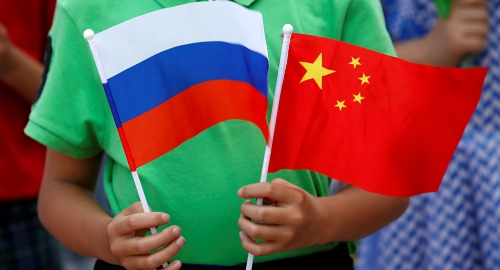
La coopération stratégique et scientifique entre la Russie et la Chine se précise
par Jean-Paul Baquiast
Ex: http://www.europesolidaire.eu
Une question restait posée : la Russie s'associerait-elle à cette démarche ou, à l'inverse, y verrait-elle une concurrence dangereuse pour les relations qu'elle a depuis longtemps établies avec ses voisins du sud au sein de l'Union économique eurasiatique.
La réponse vient d'être donnée à la seconde Conférence de la BRI qui vient de se tenir à Pékin. Elle rassemblait 37 chefs d'Etat, dont Vladimir Poutine en personne. Celui-ci vient d'annoncer son intention d'associer la Route Polaire Maritime russe à la BRI. Cette route est de plus en plus fréquentée pendant la période de fonte des glaces, période qui ne cesse de s'allonger avec le réchauffement climatique. Ceci devrait faire de l'Arctique une zone de coopération où pourraient se retrouver de nombreux intérêts refoulés vers le nord par ces changements de température. La Chine voit déjà dans la Route polaire un élément majeur de son ouverture au reste du monde.
C'est d'abord la diminution des temps de transport maritime qui l'intéresse. La route du port chinois de Dalian à Rotterdam sera raccourcie de 10 jours par rapport au passage par le détroit de Malacca et le canal de Suez. Par ailleurs, un accès aux ressources de l'Arctique sera précieuse pour un pays surpeuplé et sans grandes ressources propres tel que la Chine.
Quelques jours auparavant, dans le cadre de l'International Arctic Forum qui se tenait à St Petersbourg début Avril, la Russie avait mis l'accent sur l'importance de ce qui est nommé un Grand Partenariat Euroasiatique non seulement pour la coopération économique mais pour celle en matière scientifique. Lors de cette conférence, Chine et Russie ont signé un accord de coopération scientifique pour l'Arctique créant un China-Russia Arctic Research Center.
Dans un premier temps, il s'agira de réaliser des constructions durables sur des plateformes flottant sur la glace et des brise-glaces plus performants. Sans attendre on y étudiera des méthodes permettant de préserver les milieux naturels fragiles de cette partie du monde.
Sur ce plan, beaucoup de scientifiques resteront dubitatifs. On peut craindre que les objectifs économiques l'emportent sur les préoccupations de préservation. D'autant plus qu'à plus long terme des dizaines de millions de personne chassées de chez elles par le réchauffement et la désertification chercheront à se reconvertir non seulement dans le nord de la Sibérie mais dans l'Arctique.
Celle-ci est sans doute trop loin de l'Europe pour qu'elle s'intéresse, hormis quelque peu les pays scandinaves (et Total). Ce sera dommage pour elle.
00:35 Publié dans Actualité, Eurasisme, Géopolitique | Lien permanent | Commentaires (0) | Tags : russie, chine, actualité, politique internationale, europe, affaires européennes, asie, affaires asiatiques, eurasie, eurasisme |  |
|  del.icio.us |
del.icio.us |  |
|  Digg |
Digg | ![]() Facebook
Facebook
mardi, 21 mai 2019
Japan’s Political Ambitions could be Jeopardized by its Energy Dependence
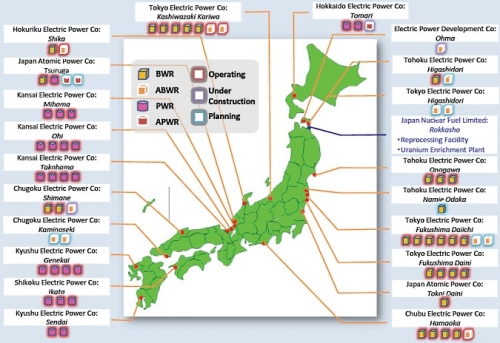
Japan’s Political Ambitions could be Jeopardized by its Energy Dependence
There has been much talk of Japan recently, which has significantly intensified its foreign policy: Japan is working together with the United States to promote the Indo-Pacific strategy with multilateral support within the framework of the US-Japan-India-Australia quadrilateral security dialogue (QUAD), which involves strengthening the Japan Self-Defense Forces and intensive peace treaty negotiations with Russia.
It is a well-known fact that one of the aims of a country’s foreign policy is to ensure the state experiences progressive internal social and economic development. For Japan’s high-tech and industrialized economy, which does not have enough of its own national energy resources to satisfy all its energy needs, one of the most important preconditions for economic growth is to secure an uninterrupted imported energy supply. However, to succeed in solving this problem, it is necessary to highlight two key factors here: a sufficient supply and a competitive price. Let’s try to gain an insight into what the Japanese economy needs in terms of energy resources and where the supply comes from.
Although Japan’s total area exceeds 370 thousand square kilometers; today, the county does not have enough natural resources to meet its own energy needs. This is largely linked to the aggressive exploitation of natural resources which took place in the past, which you can get a good sense of by looking at a map of all the mining enterprises which used to operate in Japan, along with all the oil and gas fields.
Japan is the world’s third largest oil consumer, second only to the US and China. The Japanese consume about two billion barrels of oil a year, 99.7 percent of which is imported. Tokyo weighs in heavy on imports in world rankings, bypassing Beijing to take second place. A significant risk factor threatening Japan’s oil supply is the conflict in the Middle East — violent, simmering flare-ups which could boil over — as Japan sources more than 86 percent of all its imported oil from the region (Saudi Arabia – 31.1%, UAE – 25.4%, Qatar – 10.2%, Iran – 11.5%, Kuwait – 8.2%).
Therefore, it is no wonder that the Japanese authorities are anxiously monitoring the situation in the Asia Pacific gas market. China is the leading buyer of liquefied natural gas (LNG) from the Asia Pacific, whose demands for “blue fuel” are only set to grow.
Not too long ago, Japan even made an attempt to strengthen its position in this market by importing gas from Russia. Japanese companies have developed a project to build a gas pipeline from Sakhalin, with a capacity of 20 billion cubic meters per year. Taking Japan’s current gas consumption of 123 billion cubic meters, if this gas pipeline was constructed, Tokyo would be able to meet a sixth of the national demand for this type of fuel. In 2014 however, Japan imposed sanctions against Russia “for Crimea,” and abandoned the project, even though it could significantly improve the island state’s vulnerable situation as an energy importer.
As a result, Tokyo now has no other choice but to compete with other Asia Pacific countries to secure its LNG supply, which increases the cost of energy and leaves the Japanese with no guarantee of a sufficient supply.
Although Japan does have some of its own coal reserves, it is the world’s top LNG importer. In 2017, Japan spent $ 23 billion to purchase 209 million tons of natural gas About 18 percent of the world’s coal supply goes to Japan. Along with imports of metallurgical coal for the steel industry, Japan is increasing its thermal coal imports. This is due to an electricity shortage caused by the nuclear power plants being shutdown, which had still been operating up until that point. Against this backdrop, the outlook for the next few decades is that the Japanese will be using coal, primarily for electricity production at dozens of new thermal power plants.
The given data on Japan’s oil, gas and coal imports highlights Tokyo’s almost total dependence on imported energy supplies. The availability of this imported energy supply is largely determined by the stability / instability in the region where it is produced, primarily in the Middle East, as well as in the regions along the pipeline routes, where China’s influence is growing. Energy prices today are among the highest they have ever been, as the growing Asia Pacific market consumes more and more energy each year.
Under the given circumstances, one of the most cost-effective ways to strengthen Japan’s energy security in economic terms is greater cooperation with Russia, which possesses and is capable of exporting the full spectrum of energy resources which Tokyo needs. The shared border between Russia and Japan also guarantees that the energy supply will not be severed along the way.
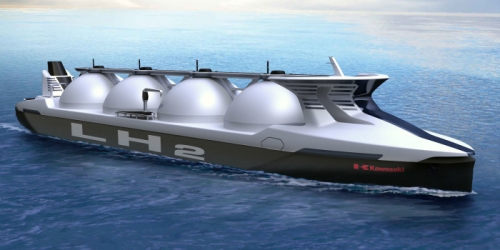
The conclusion this article would give is that Japan’s over-dependence on Washington, as well as the absence of a peace treaty with Moscow act as barriers which frustrate efforts to increase cooperation between Japan and Russia in the area of energy supply (direct supply and transit through other states). The influence of the first factor, Japan’s over-dependence on the US, is apparent in the support Japan expresses for the US policy of levying sanctions against Russia, even in cases and circumstances when this contradicts Japanese interests by not only frustrating bilateral cooperation between Japan and Russia, but also by going against the basic interests of Japan’s national security. The second factor is the peace treaty. Japanese Prime Minister Shinzo Abe’s government is busily working to try and find a solution, but the approach they are taking is not geared towards a win-win treaty.
It is clear that Japan’s ambitions to make a return to the big geopolitical game are suppressed by Tokyo’s dependence on energy imports. As it happens, Germany makes a good example of a state in a similar situation as one of Europe’s most powerful economies and major energy consumer and importer. Berlin is aware of how critically important it is to ensure a cost-effective supply of natural gas to fuel the “locomotive of the European economy”, and is currently implementing its Nord Stream 2 project to lay a gas pipeline along the bottom of the Baltic Sea, despite strong opposition from Washington.
Therefore, we cannot rule out the possibility that Tokyo will look at the experience Berlin has had and follow suit in the near future, and that without walking around Washington on eggshells any longer, Japan will begin to look after its own interests and develop bilateral relations with Russia which are beneficial for both countries.
Valery Matveev, economic observer, exclusively for the online magazine “New Eastern Outlook.”
https://journal-neo.org/2019/04/29/japan-s-political-ambi...
11:21 Publié dans Actualité, Géopolitique | Lien permanent | Commentaires (0) | Tags : actualité, géopolitique, japon, asie, affaires asiatiques, océan pacifique, énergie, sources d'énergie, dépendance énergétique |  |
|  del.icio.us |
del.icio.us |  |
|  Digg |
Digg | ![]() Facebook
Facebook
mercredi, 15 mai 2019
Un nouvel ordre multipolaire fondé sur la régulation
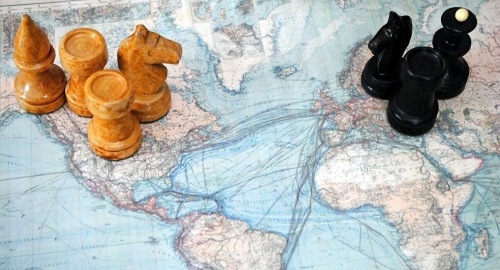
Un nouvel ordre multipolaire fondé sur la régulation
Ligne Droite cliquez ici
& http://synthesenationale.hautetfort.com
Le concept de communauté internationale, qui revient de façon récurrente dans le discours des diplomates occidentaux, n’est qu’un artifice destiné à légitimer la politique étrangère des États-Unis. Or celle-ci, porteuse de l’idéologie mondialiste, est contraire aux intérêts de la France et de l’Europe. Aussi notre pays devrait-il, selon Ligne droite, contester l’organisation actuelle des relations internationales et nourrir la grande ambition d’œuvrer à l’avènement d’un « nouvel ordre multipolaire » ancré dans la réalité du monde d’aujourd’hui et axé sur la régulation des échanges.
La notion de communauté internationale, un instrument de l’imperium américain
La notion de « communauté internationale », qui reprend sous un angle un peu différent celui de nouvel ordre mondial très en vogue à la fin du XXe siècle, est en effet une formule des plus ambiguë. Ceux qui s’en réclament laissent entendre qu’ils parlent pour l’ensemble des nations du monde, alors qu’il ne s’agit le plus souvent que des États-Unis et de leurs « alliés ». Cette référence à la communauté internationale est dès lors quasi systématiquement utilisée pour des actions ou des prises de position qui servent les États-Unis et leur vue du monde.
Autant dire, dans ces conditions, que cette notion s’inscrit dans un cadre très politiquement correct. Elle repose sur l’idée que le modèle américain fondé sur le libéralisme et la démocratie va s’étendre au monde entier et s’appuie sur l’idéologie mondialiste qui conduit à supprimer les frontières, à réduire le pouvoir des États et à œuvrer à la globalisation de la planète. En effet, la communauté internationale en question ne se préoccupe pas des identités et considère avec méfiance les États qui y demeurent attachés comme la Russie et tous les pays de l’Est de l’Europe.
Une conception politiquement correcte inadaptée au monde multipolaire d’aujourd’hui
Ligne droite estime en conséquence que les notions de nouvel ordre mondial et de communauté internationale doivent être rejetées car elles véhiculent le mondialisme, le libre-échangisme intégral, l’immigrationnisme et l’atlantisme. À ce titre, elles vont à l’encontre de ce qui est souhaitable pour le France et l’Europe, aussi notre pays doit-il les contester tout en proposant une autre vision.
Cette démarche se révèle d’autant plus légitime que le concept de communauté internationale ne correspond en rien à la réalité du monde d’aujourd’hui. La planète est en effet loin de converger autour du pôle américain, lequel perd d’ailleurs de son influence. Notre époque apparaît au contraire marquée par l’émergence de nouvelles puissances qui structurent la scène mondiale selon un schéma multipolaire. Un schéma qui n’est pas compatible avec la notion de communauté internationale puisqu’aucun des nouveaux pôles émergents comme la Chine, l’Inde ou le monde musulman, pas plus d’ailleurs que la Russie, le Brésil ou l’Afrique, ne sont prêts à s’aligner sur les États-Unis.
Il faut lui substituer le concept de nouvel ordre multipolaire
Ligne droite considère donc que la France devrait se faire le champion d’une autre conception des relations internationales. Une conception qu’elle devrait populariser sous le nom de « nouvel ordre multipolaire » et qui devrait reposer sur deux grands principes : prendre en compte la réalité multipolaire du monde d’aujourd’hui et substituer à l’ultralibéralisme international le principe de la régulation générale de tous les échanges.
Le nouvel ordre multipolaire pour une régulation des échanges
Contrairement au nouvel ordre mondial qui organisait le laisser-faire laissez-passer général tant pour les biens et services que pour les mouvements migratoires, le nouvel ordre multipolaire proposé par la droite nouvelle devrait s’appuyer sur le principe simple selon lequel les échanges ne sont admis que s’ils sont bénéfiques pour les deux parties concernées et doivent donc être régulés en conséquence.
Dans ce cadre, l’organisation du commerce mondial devrait être entièrement revue et de nouvelles négociations devraient être ouvertes en son sein pour mettre en place des écluses douanières entre les grands ensembles économiquement homogènes.
De même, s’agissant de l’immigration, la maîtrise des flux devrait s’imposer comme la règle commune. Aucun mouvement migratoire ne pourrait être organisé sans l’accord des deux pays concernés. Quant aux déplacements clandestins, ils devraient être combattus par les pays d’émigration comme par ceux d’immigration et, dans la mesure où ils sont organisés par des filières mafieuses, traités comme tels par les services compétents.
Le nouvel ordre multipolaire pour la stabilité du monde
Par ailleurs, le nouvel ordre multipolaire devrait prendre en compte la réalité du monde et reconnaître son caractère multipolaire. Pourrait en effet être constitué un G9 d’un nouveau genre regroupant les principaux pôles de puissance: Chine, Japon, Inde, Brésil, États-Unis, Russie et Europe, auxquels devraient être adjoints deux autres États, l’un représentant le monde musulman et l’autre l’Afrique (au besoin selon une formule de tourniquet). Une telle instance même informelle qui représenterait avec neuf partenaires la presque totalité de la population mondiale pourrait être le lieu le plus pertinent où débattre des conflits et des problèmes du monde. Une configuration qui serait capable d’apporter une plus grande stabilité internationale, car fondée, non plus sur une puissance unique qui cherche à s’imposer, mais sur l’équilibre des principaux pôles de puissance de la planète.
Le nouvel ordre multipolaire, un projet susceptible de s’imposer
Pour mettre en œuvre un tel projet, très différent des pratiques actuelles, la droite nouvelle, une fois au pouvoir, devrait commencer par faire de la France le champion de cette idée, à charge pour elle de l’expliquer et d’en assurer la promotion. Si, ensuite, l’Europe confédérale, telle que préconisée par Ligne droite, reprenait ce projet à son compte, gageons que tout deviendrait alors possible. L’idée d’un nouvel ordre multipolaire pourrait en effet intéresser les BRICS. Le Brésil, la Russie, la Chine, l’Inde et l’Afrique du Sud cherchent en effet à réduire l’influence des États-Unis dans le monde. Ils ne pourraient dès lors que soutenir un projet visant à institutionnaliser la réalité multipolaire qu’ils incarnent et, forte de ce soutien, l’Europe serait en mesure de faire prévaloir ce changement radical de l’organisation des relations internationales.
En tout état de cause, la France, dirigée par la droite nouvelle, aurait tout intérêt à porter l’idée d’une rénovation profonde des relations internationales. En dehors des bénéfices qu’elle et les autres pays européens pourraient en retirer si le projet se concrétisait, le seul fait de s’en faire l’artisan permettrait à la France de gagner en stature et d’offrir aux Français des perspectives ainsi qu’une ambition collective qui leur rendrait espoir et fierté.
00:49 Publié dans Actualité, Affaires européennes, Géopolitique | Lien permanent | Commentaires (0) | Tags : europe, affaires européennes, asie, affaires asiatiques, multipolarité, monde multipolaire, politique internationale, diplomatie, géopolitique |  |
|  del.icio.us |
del.icio.us |  |
|  Digg |
Digg | ![]() Facebook
Facebook
dimanche, 12 mai 2019
DYNAMIQUES MULTIPOLAIRES - ENTRE ÉQUILIBRE GÉNÉRAL DES FORCES ET ÉQUILIBRES RÉGIONAUX DE SÉCURITÉ

DYNAMIQUES MULTIPOLAIRES
ENTRE ÉQUILIBRE GÉNÉRAL DES FORCES ET ÉQUILIBRES RÉGIONAUX DE SÉCURITÉ
VIII MOSCOW CONFERENCE ON INTERNATIONAL SECURITY 2019
par Irnerio SEMINATORE
Texte rédigé en vue de la présentation à la VIIIème Conférence Internationale sur la Sécurité de Moscou des 23-25 avril 2019, organisée par le Ministère de la Défense de la Fédération de Russie.
TABLE DES MATIÈRES
Système et conjoncture
Dissuasion et forces conventionnelles
Les dynamiques et les inconnues du système de la multipolarité
La Chine et la conception chinoise de la mondialisation
La Russie et l'enjeu multipolaire
La stratégie de sécurité de la Russie.
La Russie et le retour des grandes stratégies
La stratégie des États-Unis et les tendances générales du système
L'indispensable dialogue stratégique entre l'Europe et la Russie
États-Unis et Chine. Sur le syndrome de la puissance dominante. Préservation du "statu quo" ou inversion de prééminence?
Un faux retour aux simplifications stratégiques de la bipolarité
Rivalités, desseins stratégiques et montée des tensions
Système et conjoncture
La conjoncture historique actuelle est caractérisée par la transformation du cadre stratégique général( le système international) et par la montée de déséquilibres régionaux (sous-systèmes) en leurs interactions multiples (linkages).
L'environnement stratégique en est affecté, car les équilibres de pouvoir entre acteurs majeurs du système multipolaire résultent de leurs régimes politiques et de leurs alliances globales et visent à contre-balancer les coalitions adverses et à assurer la stabilité du système (ou son bouleversement).
A cet égard la triple dynamique de la conjoncture actuelle, de fragmentation, de polarisation et de confrontation, se traduit en une reconfiguration des alliances militaires et des équilibres mondiaux, face aux risques de conflits entre Chine- Etats-Unis et Russie.
La triade Chine-Etats-Unis-Russie instaure ainsi, une politique ambivalente, de rivalité-partenariat-antagonisme, qui a pour enjeu le contrôle de la masse eurasienne et de l'espace océanique indo-pacifique, articulant les deux stratégies complémentaires du Heartland et du Rimland.
Ainsi et au niveau local, l'issue des conflits ne dépend pas des rapports balistico-nucléaires entre les leaders des pôles ,mais de alliances tissées par la diplomatie globale.
Dissuasion et forces conventionnelles
Dans cette perspective, le facteur nucléaire,qui avait été relégué au second plan , après l'effondrement de la bipolarité, redevient aujourd'hui la principale indication des tensions politiques entre les pôles et la coopération de sécurité apparaît comme l'indication la plus évidente de l'orientation stratégique des parties, en compétition ou en conflit pour les ressources. Cependant le chantage des armes nucléaires entre Grands, servant à anéantir l'intention positive de l'agresseur,joue un rôle plus grand,quand la menace anti-force est plus crédible.
Les rivalités, qui secouent aujourd'hui plusieurs régions du monde, (les Pays baltes et l'Europe de l'Est (Ukraine), le Caucase (Géorgie), le Maghreb et l'Afrique sub-saharienne, le Proche et Moyen Orient( Syrie, Liban, Israël, Iran, Turquie), le Golfe (Arabie Saoudite, Yemen, Quarar, sunnisme et chiisme), l'Amérique du Sud et du Nord, la mer de Chine méridionale et l'extrême Orient), ont forcé l'Est et l'Ouest à reconfigurer leurs alliances militaires.
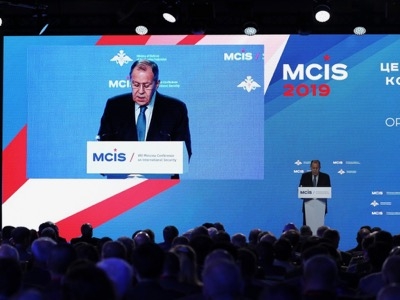
Le but en est de fixer des "lignes rouges" entre les intérêts des pôles et les enjeux régionaux, pour empêcher des escalades non maîtrisables, éviter un affrontement direct entre les acteurs majeurs du système et limiter la décentralisation de la violence au niveau régional.
Les dynamiques et les inconnues du système de la multipolarité
D'une manière générale les dynamiques du système de la multipolarité, par rapport au système bipolaire sont constituées :
- par la permanence du jeu inter-étatique, stabilisateur ou perturbateur
- par une transformation des règles du jeu (alliances) et des partenariats stratégiques, fragilisés par la rupture d'accords devenus obsolètes (Salt, INF )
- par un accroissement du nombre des acteurs essentiels (leaders de bloc) et une redistribution asymétrique de la puissance
- par le retour du révisionnisme territorial (rectification des frontières )
- par une modification de la nature de la guerre et par le croisement du conventionnel,du nucléaire et du virtuel, ou encore par l'irruption des espaces cybernétiques et satellitaires, dans les domaines de la géopolitique et de la stratégie.
- par une multiplications des tensions et des conflits décentralisés, influant sur l'équilibre général des forces.
Ainsi, toute tentative de redéfinir un ordre régional quelconque ne peut être conçue aujourd'hui , que dans la perspective d'un ordre planétaire global et à la recherche de formes d' équilibre et de stabilité à caractère planétaire. C'est par référence à la triangulation géopolitique et militaire de la Russie, des États-Unis et de la Chine et, en subordre, de l'Europe, de l'inde et du Japon,que doit être comprise la liberté relative des puissances régionales du Moyen Orient et du Golfe, et c'est là que se situe une des clés de la stratégie générale de la triade.
La Chine et la mondialisation à la chinoise
Dans ce cadre, la Chine, poursuivant une quête régionale et mondiale d’indépendance stratégique et d'autosuffisance énergétique étend sa présence et sa projection de puissance vers le Sud-Est du Pacifique, l’Océan Indien, le Golfe et l'Afrique, afin de contrer les goulots d’étranglement de Malacca et échapper aux conditionnements extérieures maritimes, sous contrôle américain.
Elle procède par les lignes internes, par la mise en place d'un corridor économique et par une route énergétique Chine-Pakistan-Golfe Persique, reliant le Port de Gwaidar, au pivot stratégique de Xinjiang.
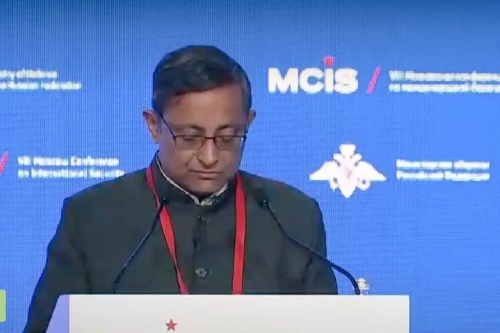
Béijin adopte la gestion géopolitique des théâtres extérieures, selon la doctrine Kissingerienne du "Linkage horizontal" et resserre ses liens continentaux avec la Russie.
L'influence chinoise est complétée par la construction d'une gigantesque "Route de la Soie", reliant le nord de la Chine à l'Europe, via le Tadjikistan, le Kazakhstan et le Turkménistan et opposant les routes terrestres aux routes maritimes.
La Russie et l'enjeu multipolaire
La Fédération de Russie a pris conscience de la mutation profonde de la perspective historique et a adopté le principe du retour à une stratégie générale défensive, qui n'interdit nullement l'initiative et s'exprime par la manœuvre, la percée et l'action.
Le partenariat stratégique entre la Russie et la Chine au plan geopolitique, a eu pour but de jouer un rôle d’équilibrage et de contre-poids, au cœur de la masse continentale eurasienne et de repartir les zones d'influence entre les deux puissances dominantes, dans le cadre de la multipolarité.
Cette double poussée, virtuellement antinomique, est corrélée à l'Organisation de Coopération de Shanghai (OCS), qui fait fonction de stabilisateur régional.
Stratégie de sécurité de la Russie
La lecture de la position russe dans le monde peut être résumée de la manière simplifiée suivante.
Face à la tendance systémique, marquée par l’émergence de pôles de puissance en compétition ou en rivalité , ainsi que par le potentiel de polarisation dû aux alignements mouvants en Asie, la Russie se doit de:
- freiner les élargissements politiques et militaires de l'OTAN en divisant ses adversaires à l'Ouest, en Europe Centrale et au Sud-Est
- stopper le processus de désagrégation au Proche, Moyen Orient et Golfe, en promouvant des nouveaux équilibres de pouvoir autour de l'axe Moscou - Damas - Téhéran et en isolant la Turquie et l'Arabie Saoudite dans la redéfinition des pouvoirs régionaux
- rapprocher les anciens satellites dans la zone de "l’étranger proche" par différents moyens (Union Euro-Asiatique)
- renforcer l'unité continentale au cœur de l'Eurasie par établissement d'une coopération plus étroite avec la Chine
La Russie et le retour des grandes stratégies
Les trois théâtres à travers lesquels la culture stratégique russe pense sa sécurité, occidental (de la Mer Baltique aux chaînes des Carpates), méridional (du Danube à l'Iran), oriental (de la Volga aux monts AltaÏ), placent au cœur de cette culture deux notions-clés: la souveraineté territoriale et la profondeur stratégique.On y ajoutera que la projection des forces sur un théâtre extérieur est placée sous la couverture des capacités nucléaires, ce qui permet de dominer militairement ses zones d'influence. Or, si au plan mondial la relation russo-américaine est fondée sur la stabilité stratégique, au plan régional la liberté de manoeuvre de la Fédération russe se déploie sur les deux théâtres, de la Méditerranée et de la Mer Noire.
La stratégie des États-Unis et les tendances générales du système
Le Secrétaire à la Défense de l'Administration Trump,l'ancien Général des Marine's James Mattis, a dévoilé en février 2018, à l'Université John Hopkins une nouvelle stratégie de défense nationale, d'où l'on déduit qu'un changement historique est intervenu depuis deux décennies dans la politique extérieure américaine.
Le principal objectif des États-Unis est désormais la concurrence entre les grandes puissances et non le terrorisme. "La Chine est un concurrent stratégique, qui utilise une politique économique prédatrice pour intimider ses voisins, tout en militarisant des zones de la mer de Chine méridionale".
"La Russie a violé les frontières des pays voisins et exerce un droit de veto sur les décisions économiques, diplomatiques et sécuritaires de ses voisins".
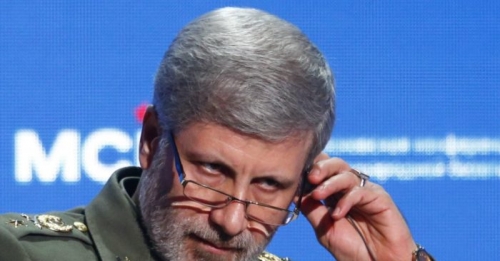
Par ailleurs, "la Chine recherche" l'hégémonie dans la région indo-pacifique à court terme et le remplacement des États-Unis, pour atteindre la prééminence mondiale dans l'avenir".
"La Russie, pour sa part, tente de briser l'Organisation de l'Atlantique Nord (OTAN) et de changer les structures économiques et sécuritaires européénnes et du Moyen-Orient"
Ainsi,pour les Etats-Unis,une conclusion est certaine : "la menace croissante des puissances révisionnistes aussi différentes que la Chine et la Russie.....cherche à créer un monde cohérent avec leurs modèles autoritaires".
Trois régions clés sont indiquées comme objets d'une préparation au conflit: l'Indo-pacifique, l'Europe et le Moyen-Orient.
Dès lors, face au déclin de l'ordre international,fondé sur des règles acquises de longue date et à une concurrence stratégique entre États, le but de l'Amérique est de rester la puissance militaire prééminente dans le monde et d’œuvrer pour que l'équilibre des forces reste en sa faveur. Elle doit faire en sorte que "l'ordre international reste plus favorable à sa sécurité et à sa prospérité, en préservant l'accès aux marchés".
La rivalité entre grandes puissances et la lutte pour la prééminence se traduisent ainsi en une compétition stratégique accrue.
L'indispensable dialogue stratégique entre l'Europe et la Russie
Quant à l'Europe de l'Ouest, la globalisation des enjeux de sécurité, impose une analyse des tendances générales du système mutipolaire et suggère l'établissement d'un dialogue stratégique entre l'Europe et la Russie
Le fondement de ce dialogue repose sur l'exigence d'allègement des tensions et des défis , portés à la stabilité régionale et mondiale.
Il a été observé que des similitudes existent entre deux types de défis, le changement du "statu quo" territorial, en Europe et en mer de Chine méridionale, bref ,en Ukraïne et dans les iles Paracels, Spratley, récif de Mischief et, plus au nord, dans les îles Senkaku (Siaoyu).
Toutefois, dans l' Europe du sud-est, il s'agirait d'un changement de paradigme, concernant l'intégrité territoriale des États; dans l'autre, de "l'internationalisation d'un conflit en mer de Chine" méridionale et orientale, qui cumule une pluralité de revendications de pays frontaliers.
États-Unis et Chine
Sur le syndrome de la puissance dominante
Préservation du "statu quo ou inversion de prééminence?
Les États-Unis seront ils disposés à renoncer à leur prééminence en Europe et en Asie, autrement dit ,dans l'ensemble du système international, ou se montreront capables de trouver des arrangements et des formes de coexistence, qui les détournent d'une fatalité apocalyptique?
En cas de doute, seront ils poussés, par la préservation du"statu quo" et de la prééminence stratégique, ainsi que par une perception antagoniste des faiblesses internes de la puissance rivale, à prendre des risques inconsidérés, par une action de dissuasion préventive?( coup de Copenhague de 1885/UK, Port-Arthur de 1905 et Pearl-Harbor de 1941/ J, Corée du Nord en 1950/URSS)
Au niveau de la conjoncture historique et de la fenêtre d'opportunités, consenties à la Chine,la question est de savoir si l'Empire du milieu a le désir et les moyens de changer le "statu-quo" et d'accéder au rang dominant du système?
Un faux retour aux simplifications stratégiques de la bipolarité
Le cœur du système international de la multipolarité tient certes au triangle stratégique États-Unis, Chine et Russie, mais corrélé à une pluralité de sous- systèmes régionaux, en compétition globale. Ces sous-systèmes sont soumis à des sphères d'influence disputées et souvent exclusives et sont doués d'inégale importance politique et militaire.
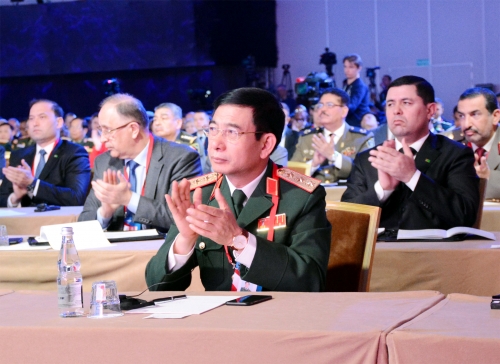
Face à un Occident fragmenté,le but de l'Europe réformée (et post- Brexit ) sera-t-il de revenir à un jeu de puissance d'équilibre entre les Etats- Unis et la Russie, bref à la stratégie gaullienne de troisième force, que l'U.E ne peut pratiquer?
Rivalités, desseins stratégiques et montée des tensions
Deux grands mouvements stratégiques rivaux s'esquissent à présent, au niveaux planétaire, internes et extérieurs à l'Eurasie:
- l'alliance sino-russe, assurant l'autonomie stratégique du Hearthland , en cas de conflit et promouvant, en temps de paix, la coopération intercontinentale en matière de grandes infrastructures, (projet OBOR (One Belt, One Road), avec la participation d'environ 70 pays )
- la stratégie du "containement" des puissances continentales par les puissances maritimes du "Rimland" (Amérique, Japon, Australie , Inde, Europe etc), comme ceinture péninsulaire extérieure
Les deux camps sont en rivalité déclarée et leurs buts stratégiques opposés.
En effet, le couple sino-russe est défini "concurrent stratégique", ou "concurrent systémique"(notamment par l'UE vis à vis de la Chine) et refuse de se soumettre à l'ordre international issu de la deuxième guerre mondiale et dessiné par les Etats- Unis .
Dans ce contexte,la défense de l'ordre, de la stabilité et du "statu quo" est assurée par la seule puissance globale du moment, l'Amérique et ses alliés. car,
en termes de politique multipolaire, Chine et Russie soutiennent le principe des zones d'influence exclusives, dites de "l'étranger proche", (Ukraine et Géorgie pour la Fédération russe et Mer de Chine méridionale pour Béijin)
En termes prospectifs et sur le plan des équilibres régionaux à long terme, les interventions des États-Unis,depuis la guerre du Golfe, ont altérés les rapports politiques et diplomatiques antérieurs entre Iran, Arabie Saoudite et pays de la région.
Dans cette même zone l'appui militaire de la Russie à la Syrie a influé sur la desoccidentalisation des affaires régionales et mondiales et, localement, sur la défaite de l'extrémisme islamique , au profit des intérêts russes du flanc sud (du Danube à la Perse et en Asie Centrale).
En termes de modernisation politique, au Proche et Moyen Orient, les idéologies importées de l'Occident, libéralisme, socialisme, laïcité, ont fait faillite et les seules formes de régimes politiques adoptées, ont été les dictatures militaires et les totalitarismes religieux, en conflit permanent.
La révision doctrinale des États-Unis en matière de sécurité s'inscrit aujourd'hui dans le gel progressif des accords sur le contrôle des armements nucléaires
Du point de vue stratégique, le retrait américano-russe des accords START et INF, et celui des accords nucléaires avec l'Iran ont sapé la confiance diplomatique entre puissances occidentales et ont mis en crise les relations des USA avec l'Europe
Par ailleurs une bataille idéologique majeure fonde le rapprochement russo-chinois sur le refus des critères occidentaux de légitimations du pouvoir et sur le mode d'exercice de l'autorité, la démocratie libérale pour les uns, l'autocratie souveraine pour les autres.
Les héritages historiques ne résistent pas toujours aux changements et le déplacement du centre de gravité des tensions vers l'Asie Pacifique, motivant la "politique de pivot" d'Obama,comme "ultime épreuve de force destinée à maintenir la Chine à un rang subalterne" (H.Kissinger), privent, en Europe, l'Alliance atlantique de sa raison d'être et risquent de ne pas la faire survivre aux finalités qui l'avaient fait naitre, celle d'un monde bipolaire.
Au même temps, l'émergence de la question nationale, identitaire et de souveraineté, se répercute en une forme de crise de cohésion des institutions européennes et assume le visage sécessionniste de remise en cause du pacte national entre Barcelone et Madrid et entre Londres, Edinbourg et Dublin à propos du Brexit, dans un processus de désagrégation interne des unités étatiques, réalisées au cours des XIX et XXèmes siècles
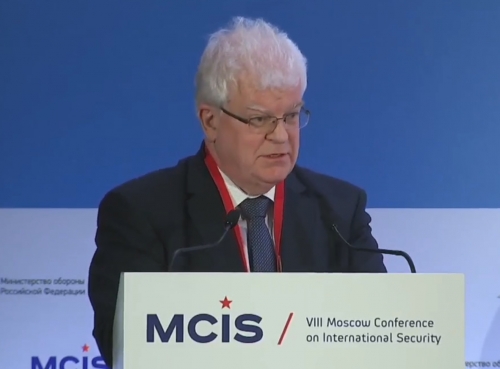
Ainsi, la politique de l'équilibre des forces en Asie orientale ne permet pas de considérer les États-Unis comme un balancier , mais comme partie intégrante de l'équiliblibre régional, car l'exercice de l'hégémonie mondiale fait de l'Amérique une puissance globale et, au même temps le centre de gravité stratégique du système.
Dès lors, une montée des tensions apparaît comme une perspective probable, au sein du système planétaire, où les principaux acteurs ne sont pas d'accord, ni sur une conception commune de l'ordre mondial, ni sur les règles de conduite pour les atteindre.
VIII MOSCOW CONFERENCE ON INTERNATIONAL SECURITY 2019
System and situation
The current historical situation is characterized by the transformation of the general strategic framework (the international system) and by the rise of regional imbalances (subsystems) in their multiple interactions (linkages).
All this affects the strategic environment, because the balances of power between major players in the multi-polar system result from their global alliances, aimed at counterbalancing adverse coalitions and ensuring the stability of the system (or its transformation).
In this respect, the triple dynamic of the current situation – fragmentation, polarization and confrontation – is reflected in a reconfiguration of the military alliances and global strategic balances, in the face of the risks of conflicts between China, the United States and Russia.
In this way the China-USA-Russia triad is establishing an ambivalent policy of rivalry-partnership-antagonism. At stake is the control of the Eurasian mass and the Indian-Pacific ocean space, expressed in the two complementary strategies of Heartland and Rimland.
In this way and at local level, the outcome of the conflicts does not depend on the nuclear-ballistic relations between the leaders of the poles, but on alliances woven by global diplomacy.
Regional rivalries
The rivalries that are shaking several parts of the world today (the Baltic countries and Eastern Europe (Ukraine), the Caucasus (Georgia), the Maghreb and sub-Saharan Africa, the Near and Middle East (Syria, Lebanon, Israel, Iran, Turkey), the Gulf (Saudi Arabia, Yemen, Qatar, Sunni and Shiite), South and North America, the South China Sea and the Far East), have forced both East and West to reconfigure their military alliances.
The aim is to set "red lines" between the interests of the poles and regional issues, so as to prevent uncontrollable escalations, to avoid any direct confrontation between the major players in the system, and to limit the decentralization of violence at regional level.
Dynamics and unknowns of the multi-polar system
In general, the dynamics of the multi-polar system, compared with the bipolar system, consist of:
- the permanence of the inter-state game, with either stabilizing or disruptive effects
- a change in the rules of the game (alliances) and of strategic partnerships, weakened by the breakdown of agreements that have become obsolete (SALT, INF)
- an increase in the number of key players (block leaders) and an asymmetrical redistribution of power
- the return of territorial revisionism (rectification of borders)
- a change in the nature of war and the mixing of conventional, nuclear and virtual warfare, and also the sudden and rapid inclusion of cybernetic and satellite spaces as geopolitical and strategy fields.
- a multiplication of tensions and decentralized conflicts, influencing the overall balance of forces.
Thus, any attempt to redefine any one regional order can be conceived today only in the perspective of a global planetary order and of the search for forms of planetary equilibrium and stability. It is by reference to the geopolitical and military triangulation of Russia, the United States and China and, at subordinate level, of Europe, India and Japan, that the relative freedom of the regional powers must be understood. It is there that one of the keys to the hoped-for success of the triad's general strategy lies.
The indispensable strategic dialogue between Europe and Russia
When it comes to Western Europe, the globalization of security issues requires an analysis of the general trends of the multi-polar system and suggests the need to establish a strategic dialogue between Europe and Russia.
The basis of this dialogue is the need to alleviate tensions and challenges to regional and global stability
A false return to the strategic simplifications of bipolarity
The heart of the international multi-polarity system correlates with a plurality of regional subsystems, in global competition with one another. These subsystems are subject to disputed and often exclusive spheres of influence and are of unequal political and military significance.
Faced with a fragmented West, will the goal of reformed (and post-Brexit) Europe be to return to a power play of equilibrium between the United States and Russia, in short to the Gaullist third force strategy that the EU is unable to practice? In prospective terms and on the level of long-term regional balances, US interventions since the Gulf War have altered the previous political and diplomatic relations between Iran, Saudi Arabia, and other countries of the region.
In terms of political modernization, in the Near and Middle East, ideologies imported from the West – liberalism, socialism, secularism – have failed and the only forms of political regimes adopted have been military dictatorships and religious totalitarianism, in permanent conflict.
The United States's revision of its security doctrine is expressed today in the progressive freeze on nuclear arms control agreements.
From a strategic point of view, the US-Russian withdrawal from the START and INF agreements, and from the nuclear agreements with Iran have undermined the diplomatic trust between Western powers and produced a crisis in the United States' relations with Europe.
Elsewhere the balance-of-forces policy in East Asia does not allow us to consider the United States as a balancing pole, but as an integral part of the regional equilibrium, since the exercise of world hegemony makes America a global power and at the same time the strategic centre of gravity of the system. For this reason an increase in tensions appears as a likely prospect within the planetary system, where the main actors do not agree, either on a common conception of the world order, on the rules of conduct to achieve it.
15 avril 2019.
12:03 Publié dans Actualité, Affaires européennes, Géopolitique | Lien permanent | Commentaires (0) | Tags : russie, europe, affaires européennes, eurasie, asie, affaires asiatiques, politique internationale, géopolitique |  |
|  del.icio.us |
del.icio.us |  |
|  Digg |
Digg | ![]() Facebook
Facebook
samedi, 11 mai 2019
Quand l’Europe s’éveillera… La Chine s’esclaffera !
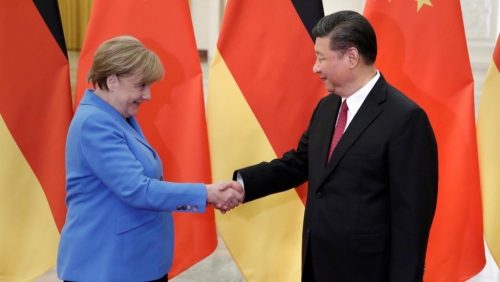
Quand l’Europe s’éveillera… La Chine s’esclaffera !
Par Guillaume Berlat
Ex: https://www.les-crises.fr
« Les temps changent. On ne sait pas quand, mais c’est toujours avant qu’on s’en aperçoive » (Catherine Breillat, cinéaste, romancière). Les temps changent, le ton change. Hier bénie, aujourd’hui (presque) honnie. Tel est le traitement que subit désormais la Chine. Au moment où le président chinois, Xi Jinping effectue une brève visite en Europe (Italie, Monaco1, France) en cette dernière décennie du mois de mars 2019, les critiques pleuvent comme à Gravelotte sur l’Empire Céleste2. Violations répétées des droits de l’Homme (Cf. contre les Ouigours ou contre l’ex-président d’Interpol, Meng Hongwei …), visées hégémoniques en Asie, en Afrique, voire en Europe à travers l’initiative des « Nouvelles routes de la soie »; violations graves des règles de l’Organisation mondiale du commerce (OMC basée à Genève) en pratiquant une concurrence déloyale, espionnage à grande échelle (Cf. critiques portées contre le géant des télécommunications Huaweï au moment où il concourt au marché de la 5G)…
Telles sont les philippiques qui reviennent le plus souvent, de manière inattendue, dans la bouche des dirigeants occidentaux, européens avec une certaine insistance depuis quelques dernières semaines. Les mêmes qui ne tarissaient pas d’éloge sur l’Empire Céleste, il y a peu encore. Comme si la guerre commerciale contre la Chine dans laquelle s’est lancée Donald Trump avait enfin décillé les yeux de la Belle au Bois Dormant qui a pour nom Europe sur les visées de Pékin. Le temps n’est plus au libéralisme échevelé, à la candeur rafraichissante. Le temps serait plutôt au patriotisme économique, à la Realpolitik, à la défense des intérêts bien compris. Mais, l’Europe (l’Union européenne) divisée et sans cap est-elle bien armée pour mener à bien ce combat contre la puissance montante du XXIe siècle ?3 Puissance normative incontestée, l’Europe est et restera encore longtemps une impuissance stratégique.
***
L’EUROPE : UNE PUISSANCE NORMATIVE
Pour tenter de comprendre l’impasse structurelle dans laquelle se trouve l’Union européenne, il est indispensable de se pencher sur la philosophie générale qui a présidé à sa création (la paix par le droit) pour être en mesure d’apprécier la conséquence de cette démarche (la construction par le vide).
La paix par le droit : une nouvelle utopie.
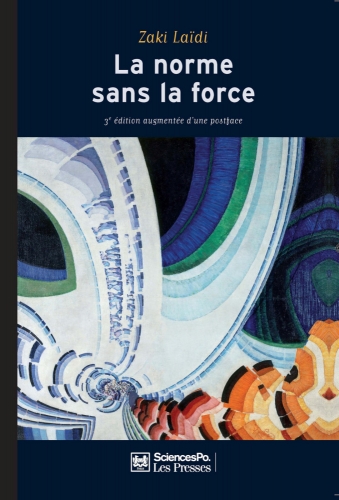 Faut-il le rappeler, comme le Conseil de l’Europe en 1949, l’Union européenne s’est construite sur le mantra de la paix par le droit (celui qui avait si bien fonctionné à l’époque de la SDN…) ! Par sa force intrinsèque et quasi-divine, la norme est censée résoudre tous les problèmes de l’Europe de l’après Seconde Guerre mondiale, de la Guerre froide, de l’après-Guerre froide et de la nouvelle Guerre froide. Ni plus, ni moins La construction européenne – du traité de Rome au traité de Lisbonne – s’est reposée sur d’énormes conventions internationales que seuls quelques initiés – dont ni vous, ni moi ne sommes – parviennent à comprendre et à interpréter. À Bruxelles, les hommes forts (les fortes femmes) de la Commission et du Conseil sont les juristes. Ils pondent en permanence de nouvelles normes et traquent l’État délinquant soit celui qui ne respecte pas les valeurs du machin (Hongrie, Pologne, Roumanie), soit celui qui viole les sacro-saintes règles budgétaires (Grèce, Italie, voire France)4. L’Europe à 28/27 n’a toujours ni cap, ni affectio societatis alors même qu’elle est secouée par des vents mauvais tant à l’intérieur (feuilleton sans fin du « Brexit », montée du sentiment national, croissance atone, phénomènes migratoires non contrôlés, terrorisme…) qu’à l’extérieur (Diktats américains, arrogance chinoise, cavalier seul russe, déclin de l’Occident…). « Cette non-personne pèse de l’extérieur, sans habiter notre intérieur »5.
Faut-il le rappeler, comme le Conseil de l’Europe en 1949, l’Union européenne s’est construite sur le mantra de la paix par le droit (celui qui avait si bien fonctionné à l’époque de la SDN…) ! Par sa force intrinsèque et quasi-divine, la norme est censée résoudre tous les problèmes de l’Europe de l’après Seconde Guerre mondiale, de la Guerre froide, de l’après-Guerre froide et de la nouvelle Guerre froide. Ni plus, ni moins La construction européenne – du traité de Rome au traité de Lisbonne – s’est reposée sur d’énormes conventions internationales que seuls quelques initiés – dont ni vous, ni moi ne sommes – parviennent à comprendre et à interpréter. À Bruxelles, les hommes forts (les fortes femmes) de la Commission et du Conseil sont les juristes. Ils pondent en permanence de nouvelles normes et traquent l’État délinquant soit celui qui ne respecte pas les valeurs du machin (Hongrie, Pologne, Roumanie), soit celui qui viole les sacro-saintes règles budgétaires (Grèce, Italie, voire France)4. L’Europe à 28/27 n’a toujours ni cap, ni affectio societatis alors même qu’elle est secouée par des vents mauvais tant à l’intérieur (feuilleton sans fin du « Brexit », montée du sentiment national, croissance atone, phénomènes migratoires non contrôlés, terrorisme…) qu’à l’extérieur (Diktats américains, arrogance chinoise, cavalier seul russe, déclin de l’Occident…). « Cette non-personne pèse de l’extérieur, sans habiter notre intérieur »5.
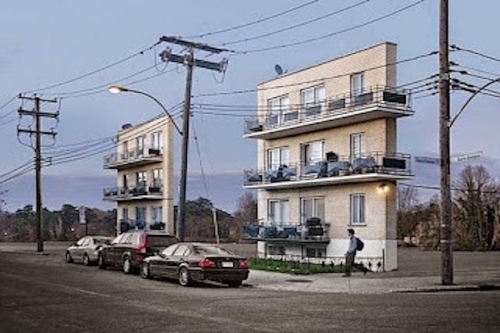
La construction par le vide : une puissance Potemkine
Nous avons aujourd’hui un exemple particulièrement éclairant de la vacuité européenne sur la scène internationale en analysant la relation de Pékin avec la France mais aussi avec l’Union européenne. Mais, un léger retour en arrière s’impose. Au cours des dernières années, sous l’influence de la pensée libérale à l’anglo-saxonne (le tout dérégulation), la Commission européenne (agissant dans l’un de ses domaines de compétence exclusif qu’est le commerce) s’est targuée de négocier et de conclure des dizaines de traités de commerce, de libre-échange avec la planète entière. Nos petits marquis drogués aux lobbies, particulièrement actifs à Bruxelles (« un aéropage technocratique, apatride et irresponsable »), nous expliquent fort doctement que tous ces torchons de papier constituent le nec plus ultra de la mondialisation heureuse6, la meilleure garantie pour les citoyens européens en termes de prospérité et de bonheur (« L’Europe des réponses » chère à Nathalie Loiseau), le signe de L’Europe indispensable7. Or, la réalité est tout autre comme ces mêmes citoyens peuvent s’en rendre compte concrètement.
L’Union n’est qu’un tigre de papier ouvert aux quatre vents. Elle ignore un principe cardinal de la diplomatie classique qui a pour nom réciprocité. Elle ouvre grandes ses portes aux entreprises chinoises alors que leurs homologues européennes sont soumises à des règles drastiques et des pratiques déloyales8. Souvenons-nous que Laurent Fabius, ministre des Affaires étrangères et du développement international (MAEDI), porteur de la diplomatie économique, ne jurait que par la Chine. Sans la Chine, point de salut. Or, aujourd’hui, les langues commencent à se délier sur les étranges pratiques commerciales chinoises. Du côté de la Commission européenne, c’était le silence radio. Du côté de nos partenaires, européens, c’était le chacun pour soit et les vaches seront bien gardées. Comme cela est tout à fait normal de la part d’une authentique grande puissance comme l’est la Chine9, Pékin pratique un vieux classique qui a fait ses preuves depuis la nuit des temps, le diviser pour mieux régner, la diplomatie des gros contrats pour mieux faire taire les rabat-joie10. Nous en avons un exemple frappant avec l’Italie qui est le premier pays du G7 à emprunter les « nouvelles routes de la soie »11. Une sorte d’embarquement pour Cythère du XXIe siècle.
L’angélisme est une plaie en ces temps conflictuels. Les États membres de l’union européenne ne comprendront jamais que « les puissants n’accordent leur amitié protectrice qu’en échange de la servitude »12. Ils commencent à peine à percevoir que la Chine entend transformer sa puissance économique en puissance diplomatique et stratégique aux quatre coins de la planète.
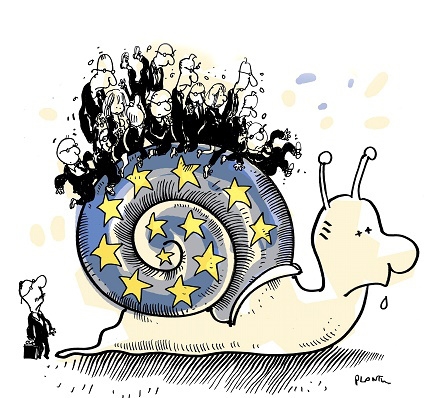
L’EUROPE : UNE IMPUISSANCE STRATÉGIQUE
Il est important d’en revenir aux fondamentaux des relations internationales. Dans un monde frappé au coin de la prégnance du rapport de forces, la désunion structurelle de l’Europe fait sa faiblesse sur la scène internationale. Par ailleurs, au moment où l’on nous annonce que l’Union se réveille face à la Chine, le moins que l’on puisse dire est que cette nouvelle posture relève encore de la cacophonie.
La désunion fait la faiblesse : l’Europe s’agite
L’opération de charme du nouvel empereur. C’est que le président Xi Jinping n’est pas né de la dernière pluie. Il sait parfaitement caresser ses hôtes français dans le sens du poil. Il le fait avec un sens aigu de l’emphase diplomatique. Pour s’en convaincre, il n’est qu’à se reporter à la tribune qu’il publie dans un grand quotidien français à la veille de sa visite en France. Il la conclut ainsi :
« La responsabilité. Ensemble, la Chine et la France pourront apporter de grandes transformations. L’histoire n’a cessé de le prouver au cours des 55 ans écoulés. À l’heure actuelle où l’humanité se trouve à la croisée des chemins, les grands pays du monde ont à assumer les responsabilités qui leur incombent. Membres permanents du Conseil de sécurité des Nations unies, la Chine et la France sont invitées à renforcer leur concertation pour défendre le multilatéralisme, préserver les normes fondamentales régissant les relations internationales basées sur les buts et principes énoncés dans la Charte des Nations unies, relever conjointement les défis, contribuer à la prospérité et à la stabilité dans le monde et promouvoir la construction d’une communauté de destin pour l’humanité.
Comme dit un proverbe chinois : « Un voyage de mille lieues commence toujours par le premier pas ». L’illustre écrivain français Victor Hugo disait : « Que peu de temps suffit pour changer toutes choses ! » Aujourd’hui sur un nouveau point de départ historique, la Chine souhaite aller de l’avant avec la France, concrètement et solidement, pour réaliser des accomplissements encore plus éclatants »13.
Et ses officines de propagande (« Échos de Chine ») d’inonder d’encarts publicitaires à l’eau de rose les principaux médias français à la veille de la visite en France du grand timonier sur les thèmes du développement d’un « partenariat stratégique global plus étroit et durable », de « Paris et Wuhan : le Conte de deux cités », de « Beijing et Paris : partenaires majeurs dans la lutte contre le changement climatique » (on en tombe à la renverse en se reportant aux facéties environnementales chinoises), de « Faire progresser plus avant les relations franco-chinoises », des « Perspectives de la coopération pragmatique entre la France et la Chine »… En prime, nous avons même droit aux dernières raffarinades : « Cette année sera une année fertile pour les relations franco-chinoises » (on se croirait revenu au temps d’Alice au pays des merveilles). Dans le rôle de l’idiot utile, Quasimodo n’a pas son pareil. Il est tout simplement parfait et impayable. Une fonction étrange pour un ancien Premier ministre de Jacques Chirac, mais qui ne gêne pas du tout l’intéressé. Ce dernier n’aime d’ailleurs pas qu’on vienne le chercher sur ces ambiguïtés : à l’en croire, il ne joue qu’un seul rôle, celui de poisson-pilote en Chine pour les entreprises françaises. Fermez le ban !
Jupiter tombe sous le charme du carnet de chèques chinois. Comment ne pas succomber aux charmes d’une telle sirène qui arrive avec de nombreuses promesses de contrats pour des entreprises françaises (on met à l’eau bouche avec des quantités extravagantes d’achats d’avions [commande de 300 Airbus pour 30 milliards d’euros par la compagnie d’État CASC]14, de navires et d’autres gadgets dont les Gaulois sont particulièrement friands) ? En bon français, cela s’appelle acheter son ou ses interlocuteurs. Comment évoquer le concept grossier de « violations des droits de l’Homme » dans cette ambiance du genre Embrassons-nous Folleville ?15 Fidèle à son habitude, Emmanuel Macron explique lors de sa conférence de presse commune à l’Élysée que la discussion sur la question des droits de l’Homme avec son homologue a été « franche » mais nous n’en saurons pas plus. Diplomatie de la discrétion oblige !
Oubliées les promesses européennes visant à faire front commun contre le tigre chinois (qui n’est pas de papier, les investissements chinois en Europe sont passés de 1,4 milliard de dollars en 2006 à 42,1 en 2018 après avoir connu un pic de 96,8 milliards en 2017) et vive le cavalier seul, le chacun pour soi dont sont coutumiers les 27/28 ! Il y a fort à parier que les moulinets de Jean-Yves Le Drian (qui accueille le président chinois sur l’aéroport de Nice) sur le thème du double sens des nouvelles routes de la soie feront rapidement pschitt. Il y a fort à parier que les déclarations viriles d’Emmanuel Macron avant la visite officielle chinoise aient autant d’effets positifs sur Xi Jinping que sur Donald Trump en son temps (il devait revenir sur son refus de l’accord sur le climat et sur celui sur le nucléaire iranien, Jupiter nous avait promis). À l’Élysée, Pinocchio (Bijou dans une robe longue rouge immaculée) fait assaut d’amabilités à l’égard de son hôte de marque. Pour nous rassurer sur les bonnes et pures intentions chinoises, quelques experts viennent nous faire la leçon : « La Chine s’essouffle, le monde s’inquiète »16, « La position de Xi Jinping n’est pas si confortable qu’elle en a l’air »17 au regard de la crise commerciale américano-chinoise18. Il est vrai que quelques nuages assombrissent le ciel bleu chinois après une longue période faste. Est-ce une tendance conjoncturelle ou structurelle ? Il est encore trop tôt pour le dire avec certitude. Mais, heureusement, l’Europe a décidé de sortir de sa torpeur pour prendre la mesure du problème. Faut-il avoir peur de la Chine ?19 Vaste programme, aurait dit le général de Gaulle qui a noué des relations diplomatiques avec la Chine communiste au nez et à la barbe des Américains.
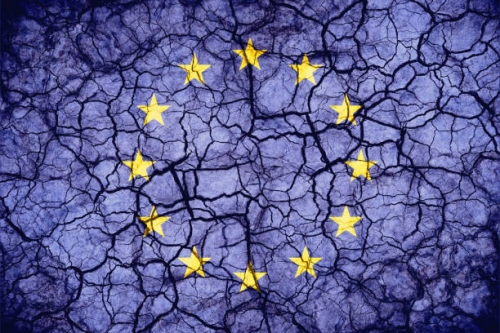
La cacophonie fait la foire : l’Europe se réveille20
Un réveil tardif et mou. Lors de ses entretiens à la villa Kérylos (Beaulieu), Emmanuel Macron prône « un partenariat équilibré » avec Pékin (déficit commercial de la France de 30 milliards d’euros)21. [Il enfonce le clou lors des entretiens à l’Élysée au cours desquels il déroule le tapis rouge et tous les leviers de la diplomatie gastronomique]. Des limites, du piège de la démagogie surtout lorsque nous apprenons qu’Emmanuel Macron, trop faible pour faire le poids, appelle de ses vœux la constitution d’un front européen (uni, nous imaginons !) destiné à déjouer la stratégie et les ambitions planétaires de Pékin. Trop peu, trop tard, pourrait-on dire. Des mots, toujours des mots… Où est la stratégie suivie d’actes forts d’une Europe unie ? On peine toujours à la découvrir. Ce qui fait le plus défaut à l’Union européenne est sa capacité d’anticipation sans parler de son absence de volonté de prendre à bras le corps les grands problèmes stratégiques du monde. Elle préfère se quereller sur des taux de TVA, de pourcentages de croissance et autres vétilles qui ne contribuent pas à faire d’elle un acteur du monde. En réalité, elle est de plus en plus spectatrice d’un spectacle dans lequel elle joue les seconds rôles. Comme le souligne si justement, Thierry de Montbrial : « Quand on reprend les conversations entre chefs d’État au lendemain de la Seconde Guerre mondiale, on s’aperçoit qu’ils ne parlaient pas de tactique, quand ils se rencontraient mais de visions »22. C’est là toute la différence entre celui qui fait l’avenir et celui qui le subit. « La construction européenne vise à surmonter les conflits et les guerres du passé. Elle a pour but la paix, la prospérité, la stabilité, la sécurité. Elle a construit un édifice institutionnel qui est bien huilé et tourne remarquablement bien. Pour renverser la formule d’Emile de Girardin, elle donne l’impression de tourner le dos à l’imprévu pour mieux diriger le cours des choses » comme le souligne un diplomate brillant, Maxime Lefebvre.
Une grande interrogation pour l’avenir.
Que peut-on mettre concrètement à l’actif de l’Union européenne au cours des dernières semaines ?
Une réponse visible, qui n’est pas pour autant efficace, est donnée au bon peuple. Xi Jinping est convié, le 26 mars 2019, à rencontrer à l’Élysée, outre le président Macron, la chancelière allemande, Angela Merkel et le président de la commission européenne, Jean-Claude Juncker23. Drôle de Sainte-Trinité (le terme de Pieds Nickelés serait plus approprié) pour sermonner le Grand Timonier et répondre d’une seule voix aux ambitieuses « routes de la soie » ! Mais, ce trio parle-t-il et a-t-il reçu mandat expresse des autres partenaires pour parler et s’engager en leur nom ? Emmanuel Macron a fait chou blanc avec son sermon aux citoyens européens. Angela Merkel est sur le départ et voit ses prérogatives rogner par son successeur, AKK24. Jean-Claude Juncker, qui ne sera pas reconduit dans ses fonctions après les élections européennes du 26 mai 2019, peine à marcher à trop lever le coude. Mais, Emmanuel Macron nous indique avoir plaidé pour un « multilatéralisme rénové » (que signifie ce nouveau concept ?) et « plus équilibré » auprès de Xi Jinping tout en confessant l’ampleur des désaccords entre la Chine et le trio choc25. Comme le démontre amplement la guerre commerciale américano-chinoise26, Pékin ne comprend que la force dans son état brut. Un grand classique des relations internationales ! Mais, nous sommes pleinement rassurés en apprenant l’existence de « convergences » euro-chinoises à l’Élysée27. Sur quels sujets, c’est un autre problème ! Nous les sommes encore plus en prenant connaissance des déclarations de de Bruno Le Maire selon lesquelles : « Face à la Chine et aux États-Unis, l’Europe doit s’affirmer comme une puissance souveraine ». Un superbe exemple de diplomatie déclaratoire.
Une réponse moins visible mais plus concrète. Le Parlement européen vient d’adopter (février 2019) et demande la mise en œuvre rapide de « l’instrument de filtrage des investissements directs étrangers pour des motifs de sécurité » 28. Il s’agit à l’évidence d’une initiative heureuse qu’il faut saluer. Encore, faut-il qu’elle trouve sa concrétisation dans les meilleurs délais et qu’elle soit ensuite appliquée avec la plus grande rigueur en cas de violation avérée de ses dispositions. L’Union européenne serait bien inspirée de voir ce qui se passe Outre-Atlantique en la matière29. En dernière analyse, il ne faut pas avoir la main qui tremble.
Une réponse encore hypothétique. Manifestement, du côté de la Commission européenne et sous l’amicale pression des États, on commence à mettre au point une sorte de feuille de route dans les relations UE/Chine30. Voici la relation qui nous en est faite par l’hebdomadaire Le Point.
« Nous avons avec la Chine des relations – comment dire ? – bonnes, mais qui ne sont pas excellentes. La Chine aujourd’hui pour nous est un concurrent, un partenaire, un rival. » C’est ainsi que Jean-Claude Juncker, le président de la Commission, concluait le Conseil européen le 22 mars, en amont de la visite de Xi Jinping en Europe, qui sera suivi, le 9 avril, d’un sommet UE-Chine. Emmanuel Macron a invité le président de la Commission et la chancelière Merkel à se joindre à la visite du leader chinois à Paris, en guise de hors-d’œuvre au futur sommet.
La semaine dernière, les chefs d’État et de gouvernement ont débattu des dix mesures que la Commission a mises sur la table vis-à-vis de l’empire du Milieu, qualifié de « rival systémique ». Un changement de ton qui traduit l’impatience des Européens à voir la Chine s’ouvrir à leurs entreprises – notamment les marchés publics –, cesser le dumping déloyal par ses prix, mettre fin au transfert de technologies forcé. En somme, rejoindre le concert des nations dans le cadre de l’OMC et accepter les règles du marché. Or, ce n’est pas le chemin emprunté par Pékin après son adhésion à l’OMC en 2001. Les Occidentaux ont eu la naïveté de croire que la Chine deviendrait une économie sociale de marché. Elle est demeurée étroitement entre les mains du Parti communiste chinois et a inventé une forme de « capitalisme d’État » qui l’a rendue quatre fois plus riche qu’en 2001…
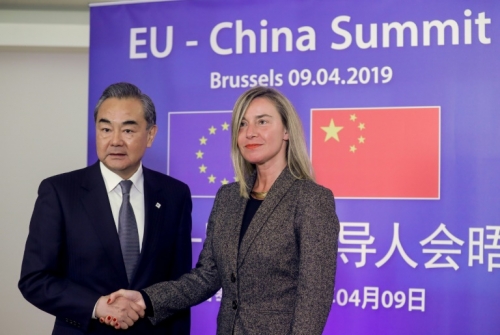
Zhang Ming, l’ambassadeur de Chine auprès de l’Union européenne, a prévenu les Européens que les avancées en termes d’ouverture économique s’effectueront à un « rythme raisonnable » et que « les demandes européennes seront « progressivement prises en compte ». Donc, il n’y a pas de « grand soir » à attendre ni de la visite de Xi Jinping à Paris ni du prochain sommet UE-Chine.
Parmi les dix mesures préconisées par la Commission, appuyée par Federica Mogherini, la haute représentante pour les relations extérieures, certaines relèvent encore, disons, des bons sentiments. Quand on pense pouvoir coopérer avec Pékin sur l’ensemble des trois piliers des Nations unies, à savoir les droits de l’homme, la paix et la sécurité et le développement, l’Union européenne demeure dans le formalisme diplomatique. Mais il est peu probable que la situation s’améliore, à court terme, au Tibet ou pour la minorité musulmane ouïghour. En revanche, l’Union européenne et la Chine sont davantage en phase sur le climat. Jean-Claude Juncker appellera Pékin à plafonner ses émissions de CO2 avant 2030, conformément aux objectifs de l’accord de Paris. Il existe également une bonne coopération sino-européenne sur le dossier iranien.
La mesure 5 est un peu plus « punchie » puisque l’UE « invite » la Chine à tenir ses engagements, dont la réforme de l’OMC, « en particulier pour ce qui est des subventions et des transferts de technologies forcés », de même que la protection des indications géographiques. Dans la mesure 6, la Commission appelle le Parlement européen et le Conseil européen à adopter l’instrument international de réciprocité sur les marchés publics avant la fin 2019. Cet appel a été entendu par le Conseil européen qui, dans ses conclusions du 22 mars, appelle à son tour « à la reprise des discussions sur l’instrument international de passation des marchés de l’UE ». On n’en est donc pas à décider. On discute… depuis 2012. L’Allemagne bloquait la discussion. Elle vient de changer d’avis à la faveur de la fusion avortée entre Alstom et Siemens. Ce travail sera donc parachevé lors de la prochaine législature, après les élections européennes. La mesure 7 est également musclée, puisque la Commission se propose de publier des « orientations » afin que les prix proposés dans les marchés publics de l’UE prennent en compte réellement les normes en matière de travail et d’environnement. C’est par ce biais que les concurrents chinois ne pourraient soutenir la concurrence avec les entreprises européennes. Emmanuel Macron, lui, voulait aller plus loin et établir une préférence communautaire dans les marchés publics. Il n’a pas été suivi par une majorité d’États membres. La Commission proposera également de compléter la législation européenne pour contrecarrer les distorsions de concurrence des pays tiers sur les biens et les services échangés dans le marché intérieur. S’agissant de la 5G, la Commission a pris en compte les problèmes de sécurité posés par le leader mondial Huawei et fera des propositions très prochainement, a annoncé Juncker31. On ne peut que se féliciter que Bruxelles ait décidé de ne pas exclure l’équipementier chinois du marché de la 5G32.
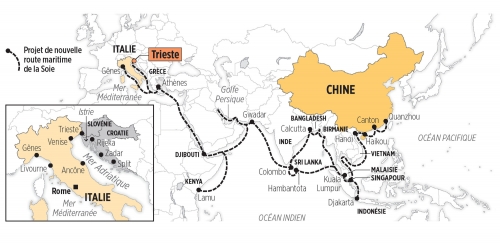
Enfin, la Commission invite les États membres à mettre en œuvre le plus rapidement possible, de manière « complète et effective », la récente législation sur le filtrage des investissements étrangers dans les domaines sensibles. Cette législation n’est pas contraignante pour les États, qui sont seulement tenus de s’informer les uns les autres. Cela n’empêcherait nullement, par exemple, l’Italie de poursuivre le partenariat qu’elle vient de signer avec Xi Jinping qui prévoit, dans le cadre du projet pharaonique des « nouvelles routes de la soie », des investissements chinois dans les ports stratégiques de Gênes et de Trieste. Un protocole d’accord « non contraignant », s’est empressé de dire Giuseppe Conte, le président du Conseil italien, devant les froncements de sourcils suscités par cet accord à Washington, Bruxelles et Paris. « La partie chinoise souhaite des échanges commerciaux dans les deux sens et un flux d’investissements dans les deux sens », a assuré, de son côté, Xi Jinping. « La relation entre l’Union européenne et la Chine ne doit pas être avant tout une relation commerciale, elle doit être une relation politique et géostratégique », a souligné Emmanuel Macron, au sortir du Conseil européen. Le commerce est un des aspects, mais si nous construisons de proche en proche une dépendance géopolitique ou stratégique, nous comprendrons rapidement les conséquences que cela peut avoir. Et nous serons perdants sur les deux points. »33
On l’aura compris, nous ne sommes qu’au début d’un très long processus diplomatique avant que toutes ces mesures deviennent contraignantes34. L’unanimité n’est pas garantie tant la Chine dispose de sérieux leviers d’influence sur les États les plus faibles de l’Union (Grèce, Italie…) et que les 27/28 pratiquent la défense de leurs intérêts nationaux avec celle de l’intérêt européen.
***
« L’Europe n’aura pas eu la politique de sa pensée ». Ce jugement porté par Paul Valéry avant la Seconde Guerre mondiale n’a pas pris la moindre ride en cette fin de deuxième décennie du XXIe siècle. Comme le rappelle fort justement Jean-Pierre Chevènement : « Les Européens se sont accommodés de la vassalisation ». Vassalisation surtout vis-à-vis du grand frère américain depuis la fin de la Première Guerre mondial et soumission vis-à-vis de l’Empire Céleste depuis la fin de la Guerre froide. Comme l’écrit avec le sens aigu de la formule qui est le sien, Régis Debray : « L’Européen a des velléités mais, à la fin, il fait où Washington lui dit de faire, et s’interdit là ou et quand il n’a pas la permission »35. Que veut-il faire avec et/ou contre la Chine qui tisse lentement mais sûrement sa toile des « nouvelles routes de la soie » (« Pour l’Europe, c’est la déroute de la soie »36), y compris jusqu’au cœur de l’Union (Grèce et maintenant Italie avec l’accord signé par Xi Jinping avec les nouveaux dirigeants37). La réponse est aussi peu claire qu’évidente à ce stade de la réflexion des 27/28. Nous sommes au cœur de la problématique institutionnelle et fonctionnelle de la construction européenne38.
Pourquoi l’Union européenne a-t-elle tant de mal à être unie face à la Chine (« Unité de façade Merkel, Macron-Juncker. Face à l’impérialisme économique de Xi Jinping, l’Europe chinoise ! »39) ? Même si les défis ne manquent pas pour Xi Jinping40, il faudra apprendre à compter avec la Chine et à anticiper des réponses réalistes pour faire jeu égal avec elle41. Aujourd’hui, force est de constater que l’expansionnisme chinois bouscule et divise sérieusement l’Europe qui est restée longtemps inerte42. Longtemps, trop longtemps, le mot « réciprocité » a été considéré comme un mot tabou, grossier du côté européen. Il semble qu’aujourd’hui il soit devenu cardinal dans la langue de certains de nos dirigeants toujours en retard d’une guerre43. Révolution copernicienne pour certains, tournant pour d’autres44. Le temps est venu de trancher le nœud gordien. D’ici là, quand l’Europe s’éveillera vraiment (nous ne savons toujours pas quand compte tenu de son inertie habituelle), le risque est grand qu’elle soit depuis longtemps empêtrée dans la nasse pékinoise et que la Chine s’esclaffera.
Guillaume Berlat
1 avril 2019![]()
1 Alice George, Albert et Charlène de Monaco reçoivent le président chinois et son épouse. Dans les coulisses d’une visite d’État, Point de vue, 27 mars-2 avril 2019, pp. 34 à 37.
2 Gabriel Grésillon/Frédéric Schaeffer, Le président chinois Xi Jinping amorce une tournée Pékin dans une Europe vigilante mais divisée face à Pékin, Les Échos, 21 mars 2019, pp. 6-7.
3 François d’Orcival, Les routes de la puissance et de l’intimidation, Valeurs actuelles, 28 mars 2019, p. 4.
4 Guillaume Berlat, De l’Europe de la sanction à la sanction de l’Europe, www.prochetmoyen-orient.ch , 24 décembre 2018.
5 Régis Debray, L’Europe fantôme, collection « Tracts », Gallimard, 2019, p. 34.
6 Guillaume Berlat, Mondialisation heureuse, balkanisation furieuse, www.prochetmoyen-orient.ch , 11 mars 2019.
7 Nicole Gnesotto, L’Europe indispensable, CNRS éditions, mars 2019.
8 Pierre Tiessen/Régis Soubrouillard, La France made in China, Michel Lafon, 2019.
9 Guillaume Berlat, Quand la Chine s’éveillera vraiment…, www.prochetmoyen-orient.ch , 14 janvier 2019.
10 Jean-Michel Bezat, Pékin emploie la diplomatie des gros contrats avec les Occidentaux, Le Monde, 27 mars 2019, p. 2.
11 Jérôme Gautheret, L’Italie, premier pays du G7 à prendre les « nouvelles routes de la soie », Le Monde, 26 mars 2019, p. 5.
12 Bernard Simiot, Moi Zénobie reine de Palmyre, Albin Michel, 1978, p. 208.
13 Xi Jinping, « La Chine et la France, ensemble vers un développement commun », Le Figaro, 23-24 mars 2019, p. 16.
14 Il convient de rappeler que cette commande avait déjà annoncée, il y a un an déjà, lors de la visite officielle d’Emmanuel Macron en Chine. Tous ces Airbus seront assemblés en Chine par des ouvriers chinois. Pour remporter ce contrat géant, Airbus aura dû consentir à d’importants transferts de technologies. Pékin n’aura pas dû se livrer à quelques activités d’espionnage pour obtenir des secrets de fabrication. Les clés de la Maison lui auront été confiées. Et, tout cela intervient en toute légalité…
15 François Bougon, La Chine cherche à imposer un nouvel ordre mondial de l’information, s’inquiète RSF, Le Monde, 26 mars 2019, p. 17.
16 Frédéric Lemaître/Marie de Vergès, La Chine s’essouffle, le monde s’inquiète, Le Monde, Économie & Entreprise, 22 mars 2019, p. 14.
17 Jean-Philippe Béja, La position de Xi Jinping n’est pas si i confortable qu’elle en a l’air, Le Monde, 26 mars 2019, p. 29.
18 Cyrille Pluyette, L’autorité de Xi Jinping écornée, Le Figaro, 6 mars 2019, p. 7.
19 Renaud Girard, Faut-il avoir peur de la Chine ?, www.lefigaro.fr , 25 mars 2019.
20 Isabelle Lasserre, Le réveil des Européens face à la Chine, Le Figaro, 25 mars 2019, p. 6.
21 Cyrille Pluyette, Macron prône un partenariat équilibré avec Pékin, Le Figaro, 25 mars 2019, p. 6.
22 Thierry de Montbrial (propos recueillis par Isabelle Lasserre), « La principale rupture du système international remonte fut 1989 et non 2001 », Le Figaro, 18 mars 2019, p. 20.
23 Brice Pedroletti/Marc Semo, L’Europe affiche son unité face à Pékin. Front européen face à la Chine de Xi Jinping, Le Monde, 27 mars 2019, pp. 1-2.
24 Thomas Wieder, « AKK », la dauphine de Merkel marque sa différence, Le Monde, 27 mars 2019, p. 4.
25 Michel de Grandi, Les Européens invitent la Chine à respecter « l’unité de l’Union », Les Échos, 27 mars 2019, p. 6.
26 Sylvie Kauffmann, L’Europe, champ de bataille sino-américain, Le Monde, 28 mars 2019, p. 32.
27 Alain Barluet, « Convergences » euro-chinoises à l’Élysée, Le Figaro, 27 mars 2019, p. 8.
28 Éric Martin, L’Union européenne va-t-elle se laisser acheter ? Le filtrage des investissements étrangers en Europe, https://www.ifri.org/fr/publications/etudes-de-lifri/lunion-europeenne-va-t-se-laisser-acheter-filtrage-investissements , mars 2019.
29 Marie de Vergès, Trump : un an d’escalade protectionniste, Le Monde, Économie & Entreprise, 28 mars 2019, p. 17.
30 Frédéric Lemaître/Jean-Pierre Stroobants/Brice Pedroletti, L’UE durcit le ton face à la Chine, Le Monde, 21 mars 2019, p. 2.
31 Sebastien Dumoulin, L’Union européenne se coordonne face à Huawei, Les Échos, 27 mars 2019, p. 6.
32 Jean-Pierre Stroobants, Huawei : face aux pressions américaines, l’Europe résiste, Le Monde, Économie & Entreprise, 28 mars 2019, p. 18.
33 Emmanuel Berretta, Les 10 préconisations de Bruxelles face à la Chine, www.lepoint.fr , 26 mars 2019.
34 Éditorial, UE-Chine : le bon virage de Paris, Le Monde, 28 mars 2019, p. 32.
35 Régis Debray, précité, p. 24.
36 Frédéric Pagès (propos presque recueillis par), Les interviews (presque) imaginaires du « Canard ». Xi Jinping : « Pour l’Europe, c’est la déroute de la soie », Le Canard enchaîné, 27 mars 2019, p. 1.
37 Olivier Tosseri, L’Italie sera bientôt la porte d’entrée des nouvelles routes de la soie en Europe, Les Échos, 21 mars 2019, p. 6.
38 Louis Vogel, Les 7 péchés capitaux de l’Europe, Ramsay, 2019.
39 Le Canard enchaîné, 27 mars 2019, p. 1.
40 Éric de la Maisonneuve, Les défis chinois : la révolution Xi Jinping, éditions du Rocher, mars 2019.
41 Hervé Martin, Les Chinois attrapent les États par la dette, Le Canard enchaîné, 27 mars 2019, p. 3.
42 Fabrice Nodé-Langlois/Valérie Segond, Les ambitions de Xi Jinping prospèrent dans une Europe divisée, Le Figaro économie, 20 mars 2019, pp. 19-20-21.
43 Anne Rovan, Face à la Chine, Bruxelles tente de trouver la parade, Le Figaro économie, 20 mars 2019, p. 21.
44 Sylvie Kauffmann, Chine-Europe : le tournant, Le Monde, 21 mars 2019, p. 31.
Pour aider le site Proche & Moyen-Orient c’est ici
Source : Proche & Moyen-Orient, Guillaume Berlat, 01-04-2019
00:14 Publié dans Actualité, Affaires européennes, Eurasisme, Géopolitique | Lien permanent | Commentaires (0) | Tags : actualité, europe, affaires européennes, chine, asie, affaires asiatiques, géopolitique, politique internationale, économie, eurasie, union européenne |  |
|  del.icio.us |
del.icio.us |  |
|  Digg |
Digg | ![]() Facebook
Facebook
vendredi, 26 avril 2019
L’initiative chinoise « Belt and Road » bat son plein en Europe
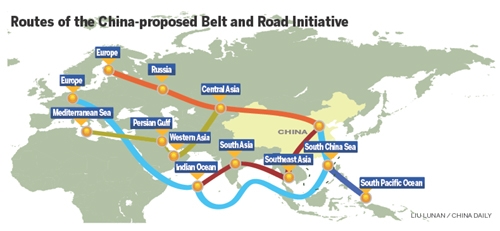
L’initiative chinoise « Belt and Road » bat son plein en Europe
Ex: https://echelledejacob.blogspot.com
La visite de Xi Jinping en Europe confirme ce que beaucoup d’entre nous ont écrit au cours des derniers mois et des dernières années, à savoir la réalité de la transformation mondiale en cours, d’un monde dominé par les États-Unis, vers un monde pluraliste composé de puissances différentes travaillant ensemble à l’avenir d’un monde multipolaire.
L’Europe se trouve donc dans une position imprévue, à l’équilibre entre l’ancien monde avec ses liens avec les États-Unis d’une part et le nouveau monde de l’Eurasie naissante portée sur les fonds baptismaux par la Russie et la Chine d’autre part.
Des pays comme l’Allemagne et la France, et même le Royaume-Uni, ont depuis longtemps mis en place des politiques commerciales favorisant l’intégration avec les pays du supercontinent eurasien. En 2015, le Royaume-Uni a été l’un des premiers pays occidentaux à rejoindre la Banque d’investissement pour l’infrastructure (AIIB), dirigée par la Chine, qui finance des projets de l’Initiative Belt and Road (BRI).
Le méga projet chinois BRI [les nouvelles routes de la soie] a débuté en 2014 avec l’objectif ambitieux de favoriser le commerce entre la Chine et l’Europe par mer et par terre, avec la participation de tous les pays intermédiaires. L’idée, en tant que consolidation naturelle du commerce, est de réduire les délais de livraison des marchandises par chemin de fer et d’intégrer les routes maritimes. Le projet couvre non seulement les ports et les lignes ferroviaires, mais également la construction d’infrastructures technologiques permettant une inter-connectivité mondiale en utilisant la technologie 5G développée par le géant chinois de la technologie Huawei.
L’Allemagne et la France ont, au fil des années, renforcé leurs partenariats avec Beijing. Paris, en particulier, a des liens historiques avec la Chine découlant de la coopération nucléaire entre le groupe chinois General Power Group (CGNPC) et Électricité de France (EDF), qui remonte à 1978, ainsi que de la coopération aérospatiale entre Airbus et les compagnies aéronautiques chinoises, en cours depuis 1985.
L’Italie a récemment approché la BRI, suite à une initiative du nouveau gouvernement constitué du mouvement Lega Nord et du Mouvement des cinq étoiles (M5S). La décision de signer un mémorandum d’accord entre Beijing et Rome souligne la volonté du nouveau gouvernement de maintenir une position équilibrée entre Washington et Beijing dans certains secteurs. C’est exactement la démarche de l’Allemagne, qui a choisi de continuer à approfondir ses liens avec Moscou vis-à-vis des hydrocarbures et de Nord Stream 2, face aux énormes pressions de Washington. En outre, l’Allemagne et l’Italie ont toutes deux confirmé leur volonté de faire confiance à Huawei pour la mise en œuvre et la gestion du trafic 5G, élément fondamental d’un monde dominé par l’internet des objets.
Les décisions de l’Allemagne, de la France et de l’Italie de poursuivre leur coopération avec Moscou et Beijing dans divers domaines vont à l’encontre du discours avancé par les médias aux ordres, contrôlés par les États-Unis, qui tentent de décourager les hommes politiques européens d’agir dans l’intérêt de leurs pays et de s’engager avec la Russie et la Chine.
Washington ne comprend toujours pas pourquoi certains pays européens sont si déterminés à saisir les opportunités offertes par l’Est. L’exemple récent de l’Italie est assez facile à comprendre. Les Italiens espèrent que la BRI donnera une impulsion indispensable à leur industrie manufacturière, qui est en berne ces dernières années. La volonté de capitaux chinois de stimuler les exportations de produits italiens est le moteur du projet d’accord entre Beijing et Rome.
Outre le besoin évident et naturel de capital financier, il y a aussi l’idée d’assurer l’approvisionnement en énergie, comme le fait l’Allemagne avec la construction du Nord Stream 2 avec la Russie. Malgré la forte opposition américaine, Berlin a défendu ses intérêts nationaux en matière de diversification énergétique, en évitant de céder aux pressions de Washington, qui souhaitait que l’Allemagne s’appuie sur le GNL [gaz naturel liquéfié] fourni par les États-Unis à un prix exorbitant par rapport au gaz fourni par la Russie.
Les divergences entre les hommes politiques européens sont frappantes, surtout si l’on examine les relations entre Macron et Salvini en Italie ou entre May et ses collègues européennes. Même entre Merkel et Macron, il semble y avoir des frictions notables autour de l’indépendance énergétique. Cependant, malgré ces divergences apparentes, le thème dominant en dernière analyse est celui de vouloir échapper à la domination étouffante de Washington au profit d’une plus grande participation au concept d’un monde multipolaire.
Aucune capitale européenne – que ce soit Paris, Rome, Berlin ou Londres – n’a l’intention de rompre le pacte atlantique avec Washington. Ceci est confirmé à chaque occasion officielle possible. Cependant, alors que Pékin se trouve de plus en plus au centre des questions de technologie, de fourniture de capital pour des investissements ou d’expansion commerciale, les modifications apportées à l’ordre global semblent imparables.
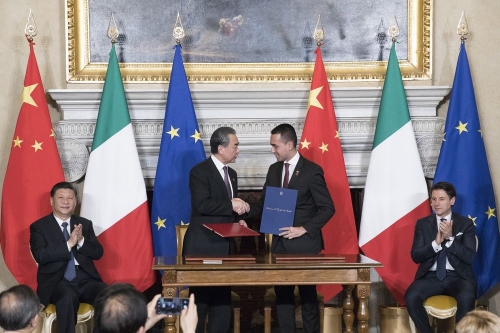
Ce n’est pas un hasard si pour les stratèges américains les deux plus grands dangers résident dans la possibilité que Moscou et Beijing, ou Moscou et Berlin, coopèrent et coordonnent leurs efforts. Le triangle Berlin-Moscou-Beijing, avec l’ajout de Rome et de Paris, représente un scénario sans précédent pour Washington en ce qui concerne son défi à l’hégémonie américaine en Europe.
Wang Yiwei, chercheur principal au Center for China and Globalization, lors de la visite historique de Xi Jinping à Rome, a exprimé de manière concrète l’évolution de l’ordre mondial : « Avec le plan de coopération 16 + 1 des pays d'Europe centrale et orientale avec la Chine, plusieurs pays ont signé un mémorandum d'accord avec celle-ci afin de construire conjointement la BRI. Actuellement, 171 accords de coopération ont été conclus avec 123 pays et 29 organisations internationales dans le cadre de la BRI ».
Federico
00:42 Publié dans Actualité, Affaires européennes, Eurasisme, Géopolitique | Lien permanent | Commentaires (0) | Tags : actualité, europe, affaires européennes, chine, asie, affaires asiatiques, belt & road, eurasisme, géopolitique, politique internationale |  |
|  del.icio.us |
del.icio.us |  |
|  Digg |
Digg | ![]() Facebook
Facebook
mercredi, 24 avril 2019
Modi-Poutine: alliance stratégique ?
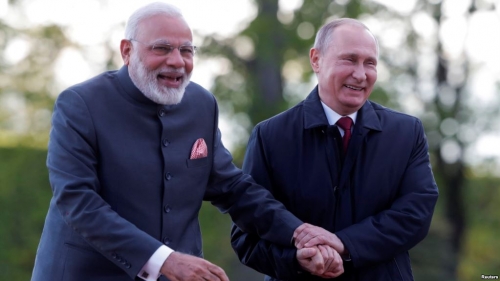
Modi-Poutine: alliance stratégique ?
par Jean-Paul Baquiast
Ex: http://www.europesolidaire.eu
Il reste que l'on a été surpris de voir l'Inde accepter un décret de Vladimir Poutine conférant à Modi la plus haute distinction honorifique russe. Il s'agit de la promotion dans l'Ordre de St André l'Apôtre dit en anglais Order of St Andrew the Apostle the First-Called. Cette distinction avait été abolie sous le régime soviétique et rétablie en 1998. Modi est le premier chef d'Etat occidental à recevoir cette distinction. Les observateurs considèrent que cette distinction, loin d'affaiblir l'audience politique de Modi en Inde, contribuera grandement à augmenter ses chances dans les futures « élections présidentielles.
Le décret russe indique que Modi a été décoré pour les services exceptionnels qu'il a apporté au partenariat stratégique entre l'Inde et la Russie, ainsi que pour le développement des relations amicales entre les deux peuples. Modi en retour a remercié Poutine avec une effusion remarquée. « Je suis très honoré de recevoir cette distinction prestigieuse. « J'en remercie le président Poutine et le peuple russe. Les racines de l'amitié entre la Russie et l'Inde sont anciennes et profondes. L'avenir de notre partenariat est brillant. Celui-ci avait déjà apporté à nos citoyens respectifs de nombreuses retombées positives.
Les observateurs extérieurs, notamment à Washington, ont été surpris de voir les témoignages de reconnaissance de Narendra Modià l'égard du président russe. Ils ont été plus encore surpris de voir Vladimir Poutine interférer, certes indirectement, mais d'une façon pouvant être lourde de conséquences, dans le processus électoral intéressant un chef d'Etat extérieur. Il avait toujours tenu a éviter de telles interventions officielles.
Rappelons cependant que Modi avait pris certains risques en acceptant l'acquisition de missiles russes de défense S-400 pour un montant de 6 milliards de dollars. Il négocie actuellement par ailleurs la mise en place d'une devise autre que le dollar pour les transactions avec la Russie.
Image Narendra Modi et Vladimir Poutine en 2018
17:07 Publié dans Actualité, Affaires européennes, Eurasisme, Géopolitique | Lien permanent | Commentaires (0) | Tags : russie, inde, europe, asie, affaires européennes, affaires asiatiques, politique internationale, vladimir poutine, eurasisme, géopolitique |  |
|  del.icio.us |
del.icio.us |  |
|  Digg |
Digg | ![]() Facebook
Facebook
vendredi, 05 avril 2019
Jean-Philippe Duranthon : « Le contre monde est en marche » : faudra-t-il une nouvelle Longue Marche en Chine… ou en Europe ?
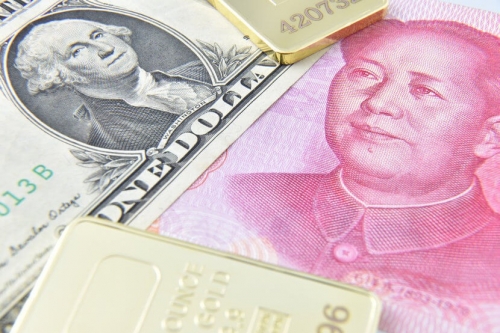
Jean-Philippe Duranthon : « Le contre monde est en marche » : faudra-t-il une nouvelle Longue Marche en Chine… ou en Europe ?
Billet d’Humeur du 28 mars 2019, par Jean-Philippe Duranthon*
Ex: https://geopragma.fr
Caroline Galactéros a publié le 25 mars un « billet du lundi » consacré, dans la perspective de la visite en France du président de la République populaire de Chine, aux relations entre la France et ce pays. J’adhère pour ma part totalement aux analyses contenues dans ce billet mais aimerais prolonger certaines d’entre elles avec un prisme économico-financier.
1/ Sur le plan international, la Chine joue un triple rôle :
– c’est une puissance politique, qui s’affirme sans cesse davantage à l’échelle régionale mais aussi mondiale au point que certains voient aujourd’hui l’émergence d’un nouveau duopole, cette fois sino-américain ;
– c’est une puissance économique, un acteur fondamental de la répartition internationale de l’activité économique : en faisant appel à elle les entreprises peuvent, d’un côté abaisser leurs coûts de production, de l’autre vendre leurs produits sur un marché énorme et dont le potentiel de croissance doit être mesuré à l’aune des perspectives de développement du pays ;
– c’est une puissance financière car, en achetant leurs emprunts d’Etat, en particulier les bons du Trésor américain, elle permet aux pays occidentaux de financer leurs déficits des paiements mais aussi acquiert de ce fait une capacité d’investissement considérable.
Dans une sorte de cercle vertueux ces trois puissances se renforcent mutuellement. À titre d’exemple, l’énorme capacité financière de la Chine lui permet à la fois – de développer ses propres entreprises à vocation mondiale, ce qui complète son modèle économique tout en lui donnant des atouts supplémentaires dans le dialogue planétaire, – d’aider à financer les projets des « pays émergents », ce qui facilite sa prise de contrôle des matières premières nécessaires à sa propre croissance, – d’investir dans les entreprises occidentales, ce qui lui permet d’acquérir plus rapidement les technologies de pointe, et – de formaliser son emprise régionale en créant une « Banque Asiatique d’Investissement pour les Infrastructures » (AIIB) dont la vocation est clairement d’offrir une alternative à la Banque Mondiale.
 2/ Faut-il, dès lors que la Chine s’est ainsi clairement « réveillée », « trembler », ainsi que Napoléon, s’il faut en croire Alain Peyrefitte, nous l’a conseillé ?
2/ Faut-il, dès lors que la Chine s’est ainsi clairement « réveillée », « trembler », ainsi que Napoléon, s’il faut en croire Alain Peyrefitte, nous l’a conseillé ?
Comme le dit Caroline Galactéros, la France a, sur le plan géostratégique, beaucoup à gagner de l’émergence politique d’un grand acteur à vocation mondiale, capable de contrebalancer l’influence des Etats-Unis dont la personnalité de l’actuel président révèle à ceux qui en doutaient le poids et les objectifs.
Il n’en serait autrement que si l’on pouvait craindre une tentation hégémonique à dimension planétaire.
Peut-on la craindre d’un pays dont la langue principale est d’une complexité telle qu’elle exige de nombreuses années d’études, ne pourra donc jamais être parlée par les populations étrangères et n’a en conséquence aucune chance de s’imposer face au globish ? Faut-il la craindre d’un pays dont la culture est marquée par le confucianisme et le bouddhisme, c’est-à-dire par des philosophies dans lesquelles, contrairement à bien d’autres en Europe et au Moyen-Orient, le salut est une question personnelle et doit être recherché quel que soit l’environnement social, indépendamment de toute évolution de la société qu’il ne s’agit pas de transformer avant de la répandre sur la terre entière ? Faut-il la craindre d’un pays où l’on joue au go, c’est-à-dire à un jeu où, contrairement aux échecs dont l’objectif est de détruire l’ennemi en s’emparant de son chef, le but est « seulement » d’être plus fort que l’adversaire, sans pour autant l’anéantir ?
N’oublions pas, en outre, que le modèle économique chinois commence à montrer ses faiblesses : la croissance ralentit et le développement économique du pays fait que, désormais, la différence des coûts de production n’est plus aussi importante que dans le passé et est parfois moindre que dans d’autres pays (voir l’Ethiopie par exemple). C’est pourquoi la Chine cherche à se « banaliser » en développant des entreprises capables d’être des acteurs de poids sur le marché mondial et à maîtriser les technologies d’avenir (énergies propres, numérique…). Reste à savoir si cette nouvelle orientation, qui favorise les technologies les plus sophistiquées, permettra, comme la précédente, plus basique, de diffuser les bienfaits de la croissance économique à la majeure partie de la population.
Pensons aussi au fait que, plus qu’un pays, l’« empire du Milieu » est un empire et que peu d’empires ont été durables. Pékin parviendra-t-il à maintenir l’hégémonie des Han dans tous les territoires où ils sont implantés, mieux que, du temps de l’URSS, Moscou a voulu le faire avec les Slaves ? L’Occident ne s’intéresse qu’au Tibet (pour lequel on voit les défenseurs de la laïcité et de la démocratie réclamer avec insistance l’instauration d’une théocratie), mais c’est dans les territoires occidentaux de la Chine que se dérouleront certainement, et que se déroulent d’ores et déjà, des évènements porteurs de difficultés ultérieures.
Constatons enfin que l’histoire de la Chine est celle d’une recherche constante et d’une concentration des pouvoirs. Cette concentration des pouvoirs est absolue dans le domaine politique (pas de « balance des pouvoirs » à la mode de l’Anglais Fortescue, pas d’ « équilibre des pouvoirs » à la mode du Français Montesquieu), ce qui explique l’autoritarisme dont ont fait ou font preuve en interne les fils du Ciel successifs (quels que soient les avatars de ce Ciel) ; mais son extension spatiale n’a jamais été au centre des ambitions, dès lors que l’étranger (le barbare, auraient dit les Grecs) ne menace pas le détenteur du pouvoir.
3/ Restent les questions économiques.
Parce que le niveau de vie de sa population était faible, que son potentiel industriel était alors très limité et que tout était à faire, la Chine a obtenu de la part des pays développés de pouvoir commercer avec eux avec des dérogations considérables, de droit ou de fait, aux règles de l’OMC ou des conventions bilatérales régissant le commerce international : une forme de contrepartie aux nombreux accords imposés à la Chine, au XIXème, par les pays occidentaux et que Sun Yat Sen a, au début du XXème, qualifiés de « traités inégaux ». Bien sûr cette nouvelle inégalité de sens opposé n’était pas, pour les pays développés, inspirée uniquement par des considérations humanitaires, elle avait aussi et peut-être surtout pour but de favoriser l’émergence d’un nouveau marché, de taille considérable, dont leurs entreprises pourraient profiter.
Vingt ans après, puisque la Chine a réussi, et au-delà, son décollage économique, le même monde occidental lui demande de respecter désormais les règles qui régissent les relations économiques mondiales entre pays de niveau de développement comparable, jugées indispensables pour que les échanges favorisent le bien-être de tous. Il souhaite en particulier que les entreprises occidentales puissent investir et agir en Chine dans les mêmes conditions que les entreprises chinoises peuvent aujourd’hui investir et agir chez eux. Est-ce déraisonnable ?
Or la Chine refuse et veut continuer à profiter des exceptions qu’on lui a consenties dans un autre contexte. Elle veut continuer à pouvoir prendre le contrôle d’entreprises occidentales, ou en devenir l’actionnaire de référence, et désormais intervenir en partenariat avec les fonds d’investissements occidentaux, sans permettre aux entreprises occidentales d’en faire de même chez elle, où l’ampleur des participations étrangères est limitée et où les règles de gouvernance des entreprises sont différentes. Est-ce raisonnable ? Doit-on et peut-on l’accepter ?
Certes, la Chine a élaboré de manière accélérée une nouvelle loi sur les investissements étrangers. Mais celle-ci, dont certaines dispositions sont très vagues, donc sujettes à interprétations incertaines, ne répond pas à l’ensemble des demandes présentées pour rétablir l’équilibre des relations. Son but est plutôt de permettre au président des Etats-Unis, en mal d’accord international après les rebuffades du leader de la Corée du Nord, d’avoir un argument pour signer un accord commercial avec la Chine. Et, dans le même temps, celle-ci continue de bloquer la convention qu’elle négocie avec l’Union européenne en refusant de bouger sur des sujets aussi fondamentaux que la réciprocité d’accès aux marchés, les secteurs stratégiques, les marchés publics, les subventions ou la propriété intellectuelle.
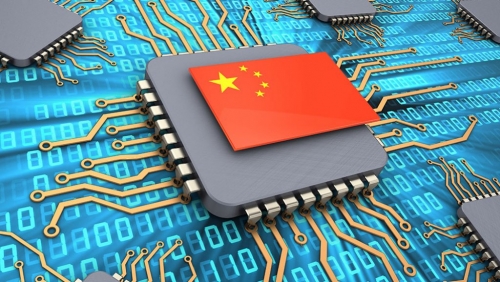
Comme l’écrit Caroline Galactéros, il faut donc travailler avec la Chine, il faut dialoguer avec elle, il faut chercher une solution qui satisfasse l’équilibre et l’équité. Le problème est que ce dialogue doit se faire dans un contexte que les Chinois veulent maintenir déséquilibré sur le plan économique, ce qui n’est pas acceptable.
4/ Comment faire ?
La première condition est de ne pas mélanger ce qui relève des rapports entre Etats et ce qui concerne les choix nationaux : les premiers sujets font naturellement l’objet du dialogue international, pour lequel notre pays doit être aussi rigoureux et volontaire que la Chine l’est elle-même, les seconds relèvent du droit de chaque pays à s’organiser comme il le souhaite et aucun pays n’est légitime pour chercher à imposer à des tiers ses propres choix et donner des leçons aux autres.
La deuxième condition est que notre pays, dans un cadre européen mais aussi seul (le siège permanent au Conseil de Sécurité de l’ONU est un atout et confère des responsabilités que d’autres n’ont pas), s’insère dans le dialogue existant entre la Chine et les Etats-Unis. Et, dans ce contexte, la Russie pourrait être un allié de poids car elle a tout à craindre d’une Chine beaucoup plus peuplée que la partie asiatique de son propre territoire, quasiment vide et donc potentiellement attractive.
Mais, à l’échelle planétaire, l’Europe devrait avoir davantage de poids qu’un seul pays. C’est pourquoi l’initiative prise par le président de la République de recevoir le président de la République populaire de Chine avec la chancelière d’Allemagne et le président de la Commission européenne est éminemment logique. Mais, vu de Chine, quel poids ont aujourd’hui une chancelière sur le départ, dont le successeur se démarque chaque jour et exprime publiquement des revendications à l’égard de la France, et le président d’une Commission dont l’autorité sera amoindrie dans quelques mois lorsque le nouveau parlement aura été élu et disposera d’une légitimité plus grande que la sienne ? En outre, pourquoi ne pas avoir convié également le Royaume Uni qui, s’il préfère aujourd’hui se délecter dans ses jeux d’alcôves politiciens, sera toujours un acteur européen d’importance, et l’Italie, dont le PIB est le troisième de l’Union européenne à 27 ? Il est vrai que celle-ci avait choisi de faire cavalier seul en signant avec la Chine un accord-cadre relatif aux routes de la soie, sans grand contenu concret toutefois, semble-t-il, mais ne s’agissait-il pas avant tout pour elle de manifester aux Européens sa lassitude d’être toujours traitée en paria ? L’Europe ne doit-elle pas accepter que ses membres ne soient pas toujours d’accord et ne serait-elle pas plus forte si elle dialoguait avec ses membres critiques au lieu de les ostraciser ?
L’Europe doit aussi prendre conscience que les modes de régulation économique qu’elle a choisis ne sont plus nécessairement adaptés à une époque où les marchés ont acquis une dimension mondiale, ainsi que l’affaire Alstom/Siemens l’a clairement illustré.
Ainsi, les relations avec la Chine montrent les limites actuelles de la construction européenne et l’incapacité de son organisation à gérer avec efficacité les enjeux du moment.
5/ Comment apprécier, dans ce contexte, les « routes de la soie » (« Belt and Road Initiative » ou BRI) ?
S’agit-il de contribuer à la croissance mondiale en utilisant pour le bien-être de tous les énormes moyens financiers accumulés par la Chine ? D’œuvrer au bénéfice de l’entente entre les pays et entre les peuples ? De mettre en place des instruments de domination permettant au pouvoir chinois d’acquérir un droit de regard, en fait de codécision, dans toutes les zones concernées ? De promouvoir les entreprises chinoises en leur ouvrant des marchés ?… Sans doute de tout cela à la fois. Mais quelle est la véritable hiérarchie des priorités ?
Les Chinois n’aident guère leurs interlocuteurs à se positionner car, depuis l’annonce du projet par le président XI Jinping en septembre 2013 à l’université Nazarbayev du Kazakhstan, les objectifs et les modalités demeurent assez flous. Les montants concernés varient mais les ordres de grandeur sont tels (on parle de 1700 Md$ par an pour la seule Asie) qu’ils en deviennent déconnectés de toute perception concrète. Les modes de financement demeurent incertains. Certaines études montrent que 95 % des projets déjà réalisés ont été confiés à des entreprises chinoises, ce qui fait craindre une mainmise du processus par les seuls intérêts chinois ; mais ces projets ont, pour l’essentiel, été réalisés dans des zones dans lesquelles le potentiel local, c’est-à-dire la concurrence, était faible. Sans doute les possibilités sont-elles diverses et les modes de définition, de financement et de pilotage des projets peuvent varier d’un cas à l’autre : l’imagination doit avoir une place dans le processus, mais il ne faut pas oublier que la Chine dispose de moyens financiers que la France n’a pas, ce qui place inévitablement cette dernière en position de faiblesse.
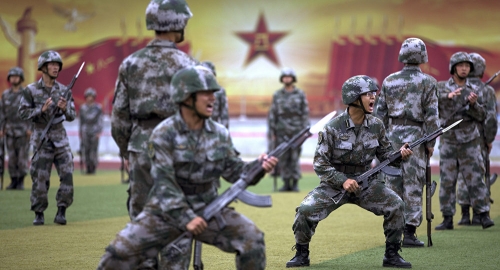
La prudence est donc de mise. Il serait autant absurde de refuser de participer au processus que d’accepter d’y jouer un rôle sans savoir à quoi l’on s’engage. C’est, semble-t-il, la ligne que les Européens ont exprimée au président chinois, et l’on ne peut que s’en réjouir.
6/ Le développement des relations entre la France et la Chine est éminemment souhaitable.
Mais son succès suppose, d’une part qu’au nom du réalisme la Chine accepte de perdre ses privilèges économiques qui ne se justifient plus, d’autre part que la France œuvre à ce qu’au nom du même réalisme l’Europe fonctionne de manière plus efficace. Il n’est pas certain que le challenge le plus difficile soit en Asie.
*Jean-Philippe Duranthon, membre fondateur de Geopragma
00:58 Publié dans Actualité, Affaires européennes, Géopolitique | Lien permanent | Commentaires (0) | Tags : chine, europe, affaires européennes, affaires asiatiques, géopolitique, politique internationale |  |
|  del.icio.us |
del.icio.us |  |
|  Digg |
Digg | ![]() Facebook
Facebook
jeudi, 04 avril 2019
How Brzezinski's Chessboard Degenerated Into Brennan's Russophobia
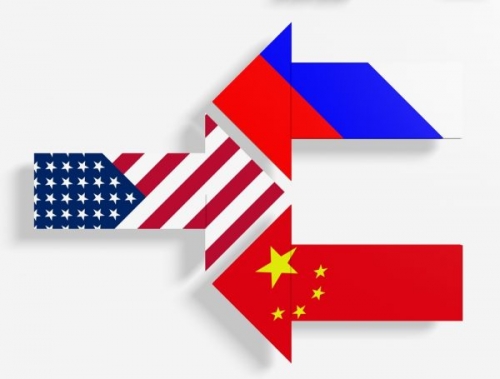
“Russia is an inalienable and organic part of Greater Europe and European civilization. Our citizens think of themselves as European. That’s why Russia proposes moving towards the creation of a common economic space from the Atlantic to the Pacific Ocean, a community referred to by Russian experts as ‘the Union of Europe’ which will strengthen Russia’s potential in its economic pivot toward the ‘New Asia.’” Vladimir Putin, President of the Russian Federation, February 2012
The allegations of ‘Russian meddling’ only make sense if they’re put into a broader geopolitical context. Once we realize that Washington is implementing an aggressive “containment” strategy to militarily encircle Russia and China in order to spread its tentacles across Central Asian, then we begin to understand that Russia is not the perpetrator of the hostilities and propaganda, but the victim. The Russia hacking allegations are part of a larger asymmetrical-information war that has been joined by the entire Washington political establishment. The objective is to methodically weaken an emerging rival while reinforcing US global hegemony.
Try to imagine for a minute, that the hacking claims were not part of a sinister plan by Vladimir Putin “to sow discord and division” in the United States, but were conjured up to create an external threat that would justify an aggressive response from Washington. That’s what Russiagate is really all about.
US policymakers and their allies in the military and Intelligence agencies, know that relations with Russia are bound to get increasingly confrontational, mainly because Washington is determined to pursue its ambitious “pivot” to Asia plan. This new regional strategy focuses on “strengthening bilateral security alliances, expanding trade and investment, and forging a broad-based military presence.” In short, the US is determined to maintain its global supremacy by establishing military outposts across Eurasia, continuing to tighten the noose around Russia and China, and reinforcing its position as the dominant player in the most populous and prosperous region in the world. The plan was first presented in its skeletal form by the architect of Washington’s plan to rule the world, Zbigniew Brzezinski. Here’s how Jimmy Carter’s former national security advisor summed it up in his 1997 magnum opus, The Grand Chessboard: American Primacy And Its Geostrategic Imperatives:
“For America, the chief geopolitical prize is Eurasia… (p.30)….. Eurasia is the globe’s largest continent and is geopolitically axial. A power that dominates Eurasia would control two of the world’s three most advanced and economically productive regions. …. About 75 per cent of the world’s people live in Eurasia, and most of the world’s physical wealth is there as well, both in its enterprises and underneath its soil. Eurasia accounts for 60 per cent of the world’s GNP and about three-fourths of the world’s known energy resources.” (“The Grand Chessboard:American Primacy And Its Geostrategic Imperatives”, Zbigniew Brzezinski, Basic Books, page 31, 1997)
14 years after those words were written, former Secretary of State Hillary Clinton took up the banner of imperial expansion and demanded a dramatic shift in US foreign policy that would focus primarily on increasing America’s military footprint in Asia. It was Clinton who first coined the term “pivot” in a speech she delivered in 2010 titled “America’s Pacific Century”. Here’s an excerpt from the speech:
“As the war in Iraq winds down and America begins to withdraw its forces from Afghanistan, the United States stands at a pivot point. Over the last 10 years, we have allocated immense resources to those two theaters. In the next 10 years, we need to be smart and systematic about where we invest time and energy, so that we put ourselves in the best position to sustain our leadership, secure our interests, and advance our values. One of the most important tasks of American statecraft over the next decade will therefore be to lock in a substantially increased investment — diplomatic, economic, strategic, and otherwise — in the Asia-Pacific region…
Open markets in Asia provide the United States with unprecedented opportunities for investment, trade, and access to cutting-edge technology…..American firms (need) to tap into the vast and growing consumer base of Asia…The region already generates more than half of global output and nearly half of global trade. As we strive to meet President Obama’s goal of doubling exports by 2015, we are looking for opportunities to do even more business in Asia…and our investment opportunities in Asia’s dynamic markets.”
(“America’s Pacific Century”, Secretary of State Hillary Clinton”, Foreign Policy Magazine, 2011)
The pivot strategy is not some trifling rehash of the 19th century “Great Game” promoted by think-tank fantasists and conspiracy theorists. It is Washington’s premier foreign policy doctrine, a ‘rebalancing’ theory that focuses on increasing US military and diplomatic presence across the Asian landmass. Naturally, NATO’s ominous troop movements on Russia’s western flank and Washington’s provocative naval operations in the South China Sea have sent up red flags in Moscow and Beijing. Former Chinese President Hu Jintao summed it up like this:
“The United States has strengthened its military deployments in the Asia-Pacific region, strengthened the US-Japan military alliance, strengthened strategic cooperation with India, improved relations with Vietnam, inveigled Pakistan, established a pro-American government in Afghanistan, increased arms sales to Taiwan, and so on. They have extended outposts and placed pressure points on us from the east, south, and west.”
Russian President Vladimir Putin has been equally critical of Washington’s erratic behavior. NATO’s eastward expansion has convinced Putin that the US will continue to be a disruptive force on the continent for the foreseeable future. Both leaders worry that Washington’s relentless provocations will lead to an unexpected clash that will end in war.
Even so, the political class has fully embraced the pivot strategy as a last-gasp attempt to roll back the clock to the post war era when the world’s industrial centers were in ruins and America was the only game in town. Now the center of gravity has shifted from west to east, leaving Washington with just two options: Allow the emerging giants in Asia to connect their high-speed rail and gas pipelines to Europe creating the world’s biggest free trade zone, or try to overturn the applecart by bullying allies and threatening rivals, by implementing sanctions that slow growth and send currencies plunging, and by arming jihadist proxies to fuel ethnic hatred and foment political unrest. Clearly, the choice has already been made. Uncle Sam has decided to fight til the bitter end.
Washington has many ways of dealing with its enemies, but none of these strategies have dampened the growth of its competitors in the east. China is poised to overtake the US as the world’s biggest economy sometime in the next 2 decades while Russia’s intervention in Syria has rolled back Washington’s plan to topple Bashar al Assad and consolidate its grip on the resource-rich Middle East. That plan has now collapsed forcing US policymakers to scrap the War on Terror altogether and switch to a “great power competition” which acknowledges that the US can no longer unilaterally impose its will wherever it goes. Challenges to America’s dominance are emerging everywhere particularly in the region where the US hopes to reign supreme, Asia.
This is why the entire national security state now stands foursquare behind the improbable pivot plan. It’s a desperate “Hail Mary” attempt to preserve the decaying unipolar world order.
What does that mean in practical terms?
It means that the White House (the National Security Strategy) the Pentagon (National Defense Strategy) and the Intelligence Community (The Worldwide Threat Assessment) have all drawn up their own respective analyses of the biggest threats the US currently faces. Naturally, Russia is at the very top of those lists. Russia has derailed Washington’s proxy war in Syria, frustrated US attempts to establish itself across Central Asia, and strengthened ties with the EU hoping to “create a harmonious community of economies from Lisbon to Vladivostok.” (Putin)
Keep in mind, the US does not feel threatened by the possibility of a Russian attack, but by Russia’s ability to thwart Washington’s grandiose imperial ambitions in Asia.
As we noted, the National Security Strategy (NSS) is a statutorily mandated document produced by the White House that explains how the President intends to implement his national security vision. Not surprisingly, the document’s main focus is Russia and China. Here’s an excerpt:
“China and Russia challenge American power, influence, and interests, attempting to erode American security and prosperity. They are determined to make economies less free and less fair, to grow their militaries, and to control information and data to repress their societies and expand their influence.” (Neither Russia nor China are attempting to erode American security and prosperity.” They are merely growing their economies and expanding their markets. If US corporations reinvested their capital into factories, employee training and R and D instead of stock buybacks and executive compensation, then they would be better able to complete globally.)
Here’s more: “Through modernized forms of subversive tactics, Russia interferes in the domestic political affairs of countries around the world.” (This is a case of the ‘pot calling the kettle black.’)
“Today, actors such as Russia are using information tools in an attempt to undermine the legitimacy of democracies. Adversaries target media, political processes, financial networks, and personal data.” (The western media behemoth is the biggest disinformation bullhorn the world has ever seen. RT and Sputnik don’t hold a candle to the ginormous MSM ‘Wurlitzer’ that controls the cable news stations, the newspapers and most of the print media. The Mueller Report proves beyond a doubt that the politically-motivated nonsense one reads in the media is neither reliably sourced nor trustworthy.)
The Worldwide Threat Assessment of the US Intelligence Community is even more explicit in its attacks on Russia. Check it out:
“Threats to US national security will expand and diversify in the coming year, driven in part by China and Russia as they respectively compete more intensely with the United States and its traditional allies and partners…. We assess that Moscow will continue pursuing a range of objectives to expand its reach, including undermining the US-led liberal international order, dividing Western political and security institutions, demonstrating Russia’s ability to shape global issues, and bolstering Putin’s domestic legitimacy.
We assess that Moscow has heightened confidence, based on its success in helping restore the Asad regime’s territorial control in Syria,… Russia seeks to boost its military presence and political influence in the Mediterranean and Red Seas… mediate conflicts, including engaging in the Middle East Peace Process and Afghanistan reconciliation….
Russia will continue pressing Central Asia’s leaders to support Russian-led economic and security initiatives and reduce engagement with Washington. …Russia and China are likely to intensify efforts to build influence in Europe at the expense of US interests…” (“The Worldwide Threat Assessment of the US Intelligence Community”, USG)
Notice how the Intelligence Community summary does not suggest that Russia poses an imminent military threat to the US, only that Russia has restored order in Syria, strengthened ties with China, emerged as an “honest broker” among countries in the Middle East, and used the free market system to improve relations with its trading partners and grow its economy. The IC appears to find fault with Russia because it is using the system the US created to better advantage than the US. This is entirely understandable given Putin’s determination to draw Europe and Asia closer together through a region-wide economic integration plan. Here’s Putin:
“We must consider more extensive cooperation in the energy sphere, up to and including the formation of a common European energy complex. The Nord Stream gas pipeline under the Baltic Sea and the South Stream pipeline under the Black Sea are important steps in that direction. These projects have the support of many governments and involve major European energy companies. Once the pipelines start operating at full capacity, Europe will have a reliable and flexible gas-supply system that does not depend on the political whims of any nation. This will strengthen the continent’s energy security not only in form but in substance. This is particularly relevant in the light of the decision of some European states to reduce or renounce nuclear energy.”
The gas pipelines and high-speed rail are the arteries that will bind the continents together and strengthen the new EU-Asia superstate. This is Washington’s greatest nightmare, a massive, thriving free trade zone beyond its reach and not subject to its rules. In 2012, Hillary Clinton acknowledged this new threat and promised to do everything in her power to destroy it. Check out this excerpt:
“U.S. Secretary of State Hillary Clinton described efforts to promote greater economic integration in Eurasia as “a move to re-Sovietize the region.”…. “We know what the goal is and we are trying to figure out effective ways to slow down or prevent it,” she said at an international conference in Dublin on December 6, 2012, Radio Free Europe.”
“Slow down or prevent it”?
Why? Because EU-Asia growth and prosperity will put pressure on US debt markets, US corporate interests, US (ballooning) national debt, and the US Dollar? Is that why Hillary is so committed to sabotaging Putin’s economic integration plan?
Indeed, it is. Washington wants to block progress and prosperity in the east in order to extend the lifespan of a doddering and thoroughly-bankrupt state that is presently $22 trillion in the red but continues to write checks on an overdrawn account.
But Russia shouldn’t be blamed for Washington’s profligate behavior, that’s not Putin’s fault. Moscow is merely using the free market system more effectively that the US.
Now consider the Pentagon’s 2018 National Defense Strategy (NDS) which reiterates many of the same themes as the other two documents.
“Today, we are emerging from a period of strategic atrophy, aware that our competitive military advantage has been eroding. We are facing increased global disorder, characterized by decline in the long-standing rules-based international order—creating a security environment more complex and volatile than any we have experienced in recent memory. Inter-state strategic competition, not terrorism, is now the primary concern in U.S. national security.”
(Naturally, the “security environment” is going to be more challenging when ‘regime change’ is the cornerstone of one’s foreign policy. Of course, the NDS glosses over that sad fact. Here’s more:)
“Russia has violated the borders of nearby nations and pursues veto power over the economic, diplomatic, and security decisions of its neighbors…..(Baloney. Russia has been a force for stability in Syria and Ukraine. If Obama had his way, Syria would have wound up like Iraq, a hellish wastelands occupied by foreign mercenaries. Is that how the Pentagon measures success?) Here’s more:
“China and Russia want to shape a world consistent with their authoritarian model…
“China and Russia are now undermining the international order from within the system…….
“China and Russia are the principal priorities for the Department… because of the magnitude of the threats they pose to U.S. security.” (National Defense Strategy of the United States of America)
Get the picture? China and Russia, China and Russia, China and Russia. Bad, bad, bad.
Why? Because they are successfully implementing their own development model which is NOT programed to favor US financial institutions and corporations. That’s the whole thing in a nutshell. The only reason Russia and China are a threat to the “rules-based system”, is because Washington insists on being the only one who makes the rules. That’s why foreign leaders are no longer falling in line, because it’s not a fair system.
These assessments represent the prevailing opinion of senior-level policymakers across the spectrum. (The White House, the Pentagon and the Intelligence Community) The USG is unanimous in its judgement that a harsher more combative approach is needed to deal with Russia and China. Foreign policy elites want to put the nation on the path to more confrontation, more conflict and more war. At the same time, none of these three documents suggest that Russia has any intention of launching an attack on the United States. The greatest concern is the effect that emerging competitors will have on Washington’s provocative plan for military and economic expansion, the threat that Russia and China pose to America’s tenuous grip on global power. It is that fear that drives US foreign policy.
And this is broader context into which we must fit the Russia investigation. The reason the Russia hacking furor has been allowed to flourish and spread despite the obvious lack of any supporting evidence, is because the vilifying of Russia segues perfectly with the geopolitical interests of elites in the government. The USG now works collaboratively with the media to influence public attitudes on issues that are important to the powerful foreign policy establishment. The ostensible goal of these psychological operations (PSYOP) is to selectively use information on “audiences to influence their emotions, motives, objective reasoning, and ultimately the behavior of… organizations, groups, and individuals.”
The USG now sees the minds of ordinary Americans as a legitimate target for their influence campaigns. They regard attitudes and perceptions as “the cognitive domain of the battlespace” which they must exploit in order to build public support for their vastly unpopular wars and interventions. The relentless Russiagate narrative (which was first referred to the FBI by the chief architect of the Syrian War, former-CIA Director John Brennan) represents the disinformation component of the broader campaign against Russia. Foreign policy elites are determined to persuade the American people that Russia constitutes a material threat to their security that must be countered by tighter sanctions, more sabre-rattling, and eventually war.
10:30 Publié dans Actualité, Géopolitique | Lien permanent | Commentaires (0) | Tags : zbigniew brzezinski, politique internationale, eurasie, europe, asie, affaires européennes, affaires asiatiques, géopolitique, routes de la soie, russophobie, russie, chine |  |
|  del.icio.us |
del.icio.us |  |
|  Digg |
Digg | ![]() Facebook
Facebook
mercredi, 03 avril 2019
De la guerre des devises à la guerre militaire

De la guerre des devises à la guerre militaire
par Eberhard Hamer, professeur ès sciences économiques
Ex: http://www.zeit-fragen.ch/fr
Le système financier mondial est dominé par un syndicat: le Conseil de stabilité financière (CSF) réunit, sous la supervision de la Banque fédérale de réserve (FED), les grandes banques atlantiques,1 elles-mêmes contrôlées par sept familles.2 «Les géants pétroliers Exxon Mobil, Royal Dutch Shell, BP et Chevron y sont également étroitement liés. Les sept familles disposent des majorités actionnaires dans pratiquement la totalité des 500 premières entreprises.»3
«La méthodologie de la domination financière mondiale est en fait assez simple: l’Amérique importe beaucoup plus de biens qu’elle n’exporte, de sorte que les dollars (fraîchement imprimés) sortent des Etats-Unis pour atterrir dans les banques centrales des autres pays. Les Etats-Unis refusant de payer leurs dettes en or, les banques centrales sont obligées d’investir des dollars en obligations et autres instruments financiers. Il en résulte un système d’endettement mondial, dominé par les Etats-Unis, qui fait prospérer l’économie américaine au détriment des autres».4
Suite à la prolifération effrénée du dollar et à la bulle d’endettement grandissante qui en résulte (32 billions de dollars), le dollar représente un risque financier toujours plus accentué. La bulle éclaterait si le monde refusait d’accepter le dollar. C’est en effet la régence du dollar qui permet au syndicat financier mondial de dépenser de l’argent à mauvais escient. Cette hégémonie du dollar est maintenue par la présence mondiale des armées américaines. Ainsi, la quasi-totalité des pays du monde se retrouvent assujettis par endettement envers le Syndicat financier américain, la plupart d’eux sont contraints à tolérer sur leur territoire, des troupes d’occupation ou des bases américaines qui assurent leur servitude pour dettes (Ramstein en Allemagne, Camp Bondsteel au Kosovo et autres).
Cependant, à maintes reprises, des pays individuels ont tenté de sortir de l’assujettissement par endettement imposé par l’empire du dollar afin d’engager leurs ressources en faveur du bien-être national plutôt que pour le syndicat financier mondial. Pour contrecarrer de tels efforts, l’empire mène en permanence des guerres économiques et financières sous diverses formes:
- Les agences de notation du syndicat financier monopolisent l’évaluation de la solvabilité des Etats. Un pays mal noté doit payer des taux d’intérêt plus élevés sur les prêts.
- Les blocus financiers, par exemple contre le Venezuela ou l’Iran, empêchent toute transaction financière avec les pays concernés, les excluant ainsi pratiquement du système monétaire mondial afin de le rendre insolvable.
- Les sanctions économiques bloquent les importations ou exportations du pays visé.
- Les accords sur les prix (dépression artificielle des prix à l’importation) réduisent la solvabilité des Etats rétifs jusqu’à ce qu’ils abandonnent.
- Les actions judiciaires contre les concurrents des banques ou entreprises anglo-saxonnes visent à réduire leur compétitivité (actions américaines en justice contre VW (23 milliards de dollars) ou la Deutsche Bank (12 milliards de dollars).
- En même temps, un système d’espionnage américain opérant à l’échelle mondiale garantit que tous les systèmes numériques dans le monde soient contrôlés, évalués, écrémés au profit des Etats-Unis et soumis au régiment numérique américain.
- Une idéologie de la globalisation lutte pour les «quatre libertés» (libre circulation du capital, des produits, des services et des travailleurs) afin de briser les structures nationales, les systèmes sociaux et les démocraties, tout cela en faveur de l’empire du dollar.
La domination mondiale du dollar est assurée militairement. «Le cartel bancaire envoie l’armée américaine, qui dévore plus de la moitié de l’ensemble des budgets militaires du monde entier, partout où elle voit ses intérêts menacés.»5 Partout où l’hégémonie du dollar américain est remise en cause, les moyens de guerre financière ou économique mentionnés ci-dessus s’emploient dans le but de rétablir la soumission. Mais si les pays ou les gouvernements se montrent têtus, s’ils ne veulent plus vendre leurs matières premières pour des dollars ou même ne plus accepter le dollar lui-même, le syndicat financier exige l’intervention de l’armée américaine:
- En novembre 2000, Saddam Hussein refusa d’accepter le dollar en échange du pétrole irakien; il accepta néanmoins l’euro, ce qui fit dévaluer le dollar.
- En 2003, l’Irak fut attaqué parce qu’il rejetait la dictature du dollar. Ainsi la menace pour le dollar fut éliminée.
- De même, le dirigeant libyen Kadhafi tenta de ne plus utiliser le dollar dans son commerce pétrolier. Aussitôt son régime fut exposé à des soulèvements et à une intervention militaire contre lui. Après l’assassinat de Kadhafi et la destruction de son système, la Libye fut réintégrée dans l’empire du dollar.
- La Russie, elle non plus, n’était plus dispose à accepter l’avantage du dollar américain par rapport aux autres devises. Elle a mis en place son propre système de paiement (PRO100) qui se trouvait en dehors de la portée du cartel bancaire international. Poutine a, en outre, privé le cartel pétrolier de se servir des réserves russes de pétrole et de gaz. Depuis lors, Poutine et la Russie se trouvent être les principaux ennemis de l’empire du dollar. Ils se font donc encercler militairement et sont combattus par tous les moyens dans une guerre financière et commerciale.
- Depuis plus de cinq ans, l’Iran est la cible des attaques monétaires, commerciales et juridiques du syndicat américain, car le pays se montrait décidé à vendre son pétrole non seulement en échange de dollars, mais également de toutes les autres devises. Des sanctions brutales à l’encontre de tous les potentiels acheteurs et partenaires commerciaux ont abouti à son exclusion totale du système financier mondial ainsi que de l’économie mondiale. Comme cet Etat ne fléchit toujours pas, la menace d’une action militaire est de plus en plus imminente.
- La Chine se démarque aussi du dollar en se dotant d’un système monétaire concurrent (Banque asiatique de développement) qui ne tolère plus la domination du dollar et évolue donc, de plus en plus, en Etat ennemi du Syndicat financier atlantique.
Lors de la campagne électorale, Hillary Clinton avait promis «de commencer la guerre contre la Russie en Ukraine et en Syrie d’ici le mois de mars», mais elle s’est ensuite corrigée, en disant qu’on n’y parviendrait pas avant mai 2018. Par bonheur, elle n’a pas été élue.
Le dos contre le mur, l’Amérique est pourtant toujours sous double pression:
- L’effet de la pression effrénée sur le dollar a conduit à une quantité de dettes uniques dans l’histoire des Etats-Unis (32 billions de dollars) qui peuvent s’effondrer à tout moment si d’autres pays importants n’acceptent plus le dollar, si les banques du système financier tombent en faillites ou si les pays surendettés deviennent insolvables. L’empire du dollar a jusqu’à présent tenté de corriger ces dangers avec des prêts à intérêt zéro, ce qui devient de plus en plus difficile à maintenir. La dévaluation d’une monnaie de référence (dollar) en hausse incontrôlée est finalement certaine. La confiance diminue. Le syndicat financier prépare donc déjà l’interdiction des espèces et le remplacement de l’argent-monnaie par de l’argent numérique.
- L’empire du dollar ne peut être soutenu qu’avec un boom constant. Cela présuppose une exploitation élevée de la capacité de l’économie. Cependant, l’économie américaine produit pour 70% des armes, de sorte que l’économie américaine n’est florissante que lorsque l’industrie de l’armement est en plein essor. Celle-ci ne peut se développer que si elle peut vendre ses produits, c’est-à-dire s’il y a suffisamment de guerres dans le monde. La production américaine d’équipements militaires dépasse les 600 milliards d’euros, soit dix fois plus que celle de la Russie et plus de la moitié de la production mondiale d’équipements militaires. Le président américain exige des pays satellites d’acheter davantage d’armement (en provenance des USA), et il vend sans vergogne des armements à des dictatures (Arabie saoudite).
- Après le réarmement de l’OTAN et de l’Ukraine et après la fin de la guerre en Syrie, l’industrie américaine de la défense a besoin d’un nouveau coup de pouce pour relancer l’économie aux Etats-Unis au moyen d’une nouvelle guerre.
La politique américaine prétend toujours que la Russie, la Chine, l’Iran ou d’autres pays sont belliqueux et dangereux. Comme le montrent les dépenses militaires et les actes d’agression (sanctions, châtiments, etc.) des Etats-Unis dans le monde entier, ce sont avant tout les USA qui sont belliqueux et prêts à la guerre. A plusieurs reprises, ils ont mis en avant le Secrétaire général de l’OTAN, Jens Stoltenberg, et des hommes politiques des pays satellites (Heiko Maas, Ursula von der Leyen) pour diaboliser la Russie et exprimer des menaces de guerre.
Comme avant la Première Guerre mondiale, nous sommes donc dans une situation, où un petit événement pourrait déclencher un nouvel incendie mondial. Les dictatures et les empires ont toujours utilisé la guerre comme dernier recours quand ils ne savaient plus que faire. Si l’économie américaine s’effondre en raison d’un manque de demande d’armes ou de l’éclatement de la bulle d’endettement de l’empire du dollar, l’hégémonie du syndicat financier mondial et de la puissance mondiale des Etats-Unis devraient disparaître. Ainsi on arriverait à un point, où les politiciens ne savent plus quoi faire et ils pourraient éventuellement avoir recours au dernier ressort.
Aux Etats-Unis, des voix s’élèvent déjà pour dire que la guerre contre l’Iran doit commencer cet été. Les préparatifs sont terminés.
Il n’est donc guère compréhensible que le monde ne prenne pas conscience du danger de guerre, que les marches pour la paix n’exigent pas la paix dans tous les pays comme par le passé et que les médias dirigés par le syndicat financier (par exemple la presse Springer) puissent s’attaquer à la Russie et à l’Iran, sans aucune opposition, au lieu d’exiger la paix. Nous avons besoin d’une «révolte de tous les amoureux de la paix» pour faire prendre conscience du danger de la guerre et de l’exigence de paix pour tous les peuples. Si nous restons inactifs et que nous ne la dénonçons pas à temps, la politique irresponsable des Etats-Unis et de l’OTAN pourrait nous replonger dans l’impasse de la guerre contre notre volonté.
Non seulement il est grand temps de mettre en garde contre cela, mais nous devons le faire à voix haute. •
(Traduction Horizons et débats)
1 JP Morgen Chase, City Group, Wells Fargo, Deutsche Bank, BNP, Barclays
2 Goldman Sachs, Rockefeller, Lehmann, Rothschild, Warburg, Lazard et Seifs
3 Orzechowski, Peter. Durch globales Chaos in die Neue Weltordnung, Rottenburg 2016
4 ibid, p. 61
5 ibid, p. 62
09:57 Publié dans Actualité, Affaires européennes, Economie | Lien permanent | Commentaires (0) | Tags : guerre des devises, devises, dollar, yuan, euro, finance, économie, politique internationale, géopolitique, europe, affaires européennes, asie, affaires asiatiques |  |
|  del.icio.us |
del.icio.us |  |
|  Digg |
Digg | ![]() Facebook
Facebook
vendredi, 29 mars 2019
Europe: la Chine attaque l'Amérique!
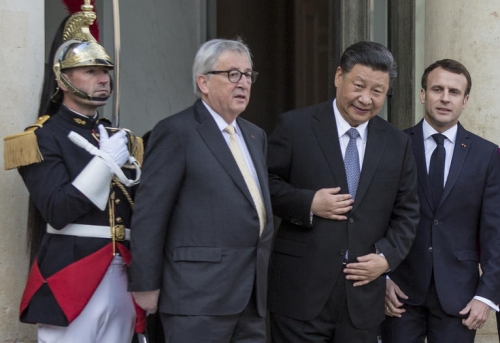
Europe: la Chine attaque l'Amérique!
Parallèlement à la Russie qui accueille en ce moment même le président libanais, quitte à inquiéter très sérieusement Américains et Israéliens qui ont peur de voir de riches réserves gazières quitter la côte israélienne de la Méditerranée pour se diriger vers la côte libanaise, la Chine a lancé cette semaine une terrifiante offensive contre les États-Unis en plein cœur de l’Europe « américanisée ».
Cette Europe qui s’accroche toujours au modèle américain, à l’OTAN ne voyant plus que le géant aux pieds d’argile qu’est l’Amérique, s’effondre comme un château de cartes.
En Italie, le président Xi Jinping a réussi un coup de maître. Faisant miroiter d’énormes intérêts que l’Italie, parent pauvre de l’Europe de l’Ouest a à gagner, il a mis la main sur les ports et les aéroports italiens et a fini par convaincre les Italiens d’adhérer à la route de la soie. Ce concept qui terrorise les Américains, ne devait pas trop plaire à Emmanuel Macron, représentant pur et dur de l’atlantisme moribond. Et pourtant, arrivé à Nice, en fin stratège militaire qu’il est, Jinping a su trouver les mots et les « sommes » pour séduire Jupiter qu’accompagnait l’Allemande Merkel et l’européiste, Junker.
Bien que la Macronie ait apposé une fin de non-recevoir catégorique au méga-projet « l’Initiative route et ceinture (BRI) », son président avait convié à Paris la chancelière allemande, Angela Merkel, et le président de la Commission européenne, Jean-Claude Juncker, rien que pour avoir un sommet tripartite avec Xi. Cette rencontre a réuni les trois plus puissants personnages de l’Union Européenne face au numéro un chinois.
Des sources proches des pourparlers, citées par Sputnik, affirment que la partie chinoise a tenté de dissuader l’Europe de recourir à des sanctions et que la dynamique sanctionnelle déclenchée par Washington vise avant tout les intérêts européens. Le président chinois a aussi encouragé la France à emboîter le pas à l’Italie dans le cadre de la BRI. Et cet encouragement est passé par d’alléchants contrats auxquels même la Macronie n’a pas pu dire non.
«La Chine et la France ont signé un contrat de 30 milliards d’euros pour la livraison à Pékin de 300 avions Airbus. C’est sans doute le résultat le plus tangible de la visite de Xi Jinping à Paris. Il témoigne de la confiance de la Chine envers Airbus, ce qui est particulièrement important sur fond de problèmes avec les appareils de Boeing et alors que les États-Unis multiplient leurs offensives contre l’industrie aéronautique française en imposant aux pays européens leurs F-14, leurs F-16 ou encore leurs F-35 …
» Qu’a-t-elle la France à s’obstiner à refuser la perspective particulièrement prometteuse que lui offre la BRI ? La semaine dernière, le président US a porté un nouveau coup dur à l’OTAN en ouvrant grand ses portes au Brésil, un pays qui ne fait pas partie de l’axe transatlantique. La décision a été prise sans consultation avec les membres de l’Alliance dont la France qui s’est toutefois soumise aux exigences militaires des États-Unis. Dans presque tous les dossiers militairo-sécuritaires, de la Syrie au Yémen en passant par l’Irak voire l’Iran, la France de Macron s’est totalement alignée sur Washington pour n’avoir in fine que le mépris et l’irrespect de l’administration US, se demande Hanif Ghafari, interrogé par Press TV.
« Une chose est néanmoins sûre : le départ du Brésil de BRICS se fera rudement ressentir par les puissances qui en font partie. La Chine prépare sa revanche : elle vise le cœur même de l’alliance atlantiste et anticipe la perspective d’un BRICS sans le Brésil. Pékin travaille à remplacer l’Union Européenne par une Union eurasiatique et la France finira, elle aussi par comprendre que ses intérêts résident en Asie et non pas à l’autre côté de l’Atlantique ».
- Source : Pars Today (Iran)
00:33 Publié dans Actualité, Affaires européennes, Eurasisme, Géopolitique | Lien permanent | Commentaires (0) | Tags : actualité, chine, europe, affaires européennes, affaires asiatiques, asie, eurasie, politique internationale, géopolitique |  |
|  del.icio.us |
del.icio.us |  |
|  Digg |
Digg | ![]() Facebook
Facebook
mercredi, 27 mars 2019
Xi Jinping, le VRP 5G des routes de la soie en Europe
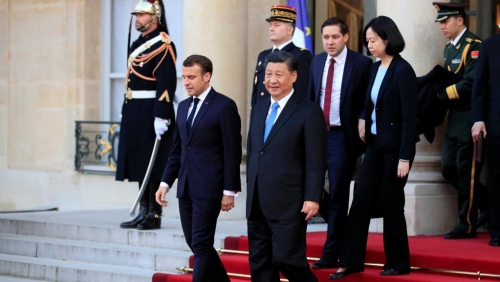
Xi Jinping, le VRP 5G des routes de la soie en Europe
Ex: https://lesobservateurs.ch
Pour le 55e anniversaire des relations diplomatiques entre la République populaire de Chine et la France, Xi Jinping n'est pas arrivé à Paris les mains vides.
Sa visite à notamment été l'occasion de signer des contrats pour l’achat de 300 appareils Airbus (290 A320 et 10 A350) pour un montant prix catalogue d’environ 35 milliards d’euros. Mais Xi Jinping n’est pas seulement venu faire des emplettes. Tout d’abord, les milliards de contrats annoncés sont souvent des investissements croisés. Par exemple, Airbus ne se contente pas de vendre des avions à la compagnie étatique China Aviation Supplies Holding Company (CASC), il a aussi signé un contrat avec l’exploitant chinois de satellites 21AT pour coopérer sur le développement de services d’imagerie à haute résolution.
L’armateur français CMA CGM, numéro trois mondial du transport maritime par conteneur, va faire construire par la China State Shipbuilding Corporation (CSSC), l’un des deux principaux conglomérats publics chinois de construction navale, dix nouveaux porte-conteneurs, pour un montant estimé de 1,2 milliard d’euros. Quant à EDF, l’électricien public devrait investir environ un milliard d’euros dans deux projets de parc éolien en mer de Chine, au large de la province du Jiangsu, au nord de Shanghai, pour une capacité totale de production de plus de 500 mégawatts.
Enfin, deux protocoles sanitaires ont été signés lundi par l’ambassadeur de Chine en France et le ministre français de l’Agriculture, Didier Guillaume. Le premier lève l’embargo sur les volailles et produits de volailles françaises mis en place en décembre 2015 au motif de la grippe aviaire. Le second concerne l’importation par la France de mollusques chinois.
L'Italie brise l'unité du G7 face aux routes de la soie
Le président chinois est aussi venu vendre son projet de routes de la soie à l’Europe. Juste avant de rencontrer Emmanuel Macron, Jean-Claude Juncker et Angela Merkel à Paris dans la perspective du sommet UE-Chine d’avril, Xi Jinping avait commencé sa tournée européenne par l’Italie. A la clé, la signature d’un mémorandum d’accord sur l’initiative chinoise de routes de la soie.
Déjà 29 accords sectoriels ont été signés dans la capitale italienne, et les deux pays auraient déjà des contrats assurés pour sept milliards d’euros, avec la possibilité d’arriver jusqu’à 20 milliards. Lancé en 2013, le projet de Nouvelle route de la Soie, également appelé «la ceinture et la route» vise à établir des liaisons logistiques entre l'Europe, le Moyen-Orient, l’Afrique, l'Asie du Sud-Est et la Chine. Il prévoit notamment le financement d'infrastructures terrestres et maritimes pour un montant de plus de 1 000 milliards de dollars, mélangeant investissements publics et privés.
#Apple et #Huawei au cœur de la guerre commerciale entre les #EtatsUnis et la #Chine
https://t.co/VVl2NbavRDpic.twitter.com/VUSyqNYRIL
— RT France (@RTenfrancais) January 4, 2019
Si l’Italie est le premier pays membre du G7 à s’engager dans le gigantesque projet de développement chinois, elle n’est pas le premier Etat européen. Viktor Orban, le Premier ministre hongrois, a accueilli à Budapest, dès 2011, le premier forum économique et commercial Chine-Europe centrale et orientale au format 16+1. Il associe la Chine à 11 pays de l’Union européenne : Bulgarie, Croatie, Estonie, Hongrie, Lettonie, Lituanie, Pologne, République tchèque, Roumanie, Slovaquie et Slovénie, ainsi qu’à cinq de leurs voisins extra-communautaires : l’Albanie, la Bosnie-Herzégovine, la Macédoine du Nord, le Monténegro et la Serbie.
Une emprise économique qui préoccupe Bruxelles
Une emprise économique et unificatrice inquiétante pour les principaux dirigeants européens, qui avaient jusqu’ici tendance à fustiger la tendance des petits Etats membres à faire cavalier seul alors que la Chine leur parlait d’investissements.
Ainsi, lors d'entretiens avec le président chinois, Emmanuel Macron, évoquant les routes de la soie, a déclaré : «La coopération rapporte plus que la confrontation», avant d'ajouter : «Nous attendons naturellement de nos grands partenaires qu'ils respectent eux aussi l'unité de l'Union européenne comme les valeurs qu'elle porte.»
«Les Nouvelles routes de la soie sont un projet très important [et] nous, Européens, nous voulons jouer un rôle [mais] cela doit conduire à de la réciprocité et nous avons un peu de mal à la trouver», a renchéri la chancelière allemande Angela Merkel.
En 2016, la Chine avait fait main basse sur le port du Pirée (Athènes) en prenant, via COSCO, l'un des leaders mondiaux du fret, le contrôle de la société de gestion de ce port européen ouvert sur l’Adriatique, la Méditerranée et, via le détroit du Bosphore, sur la mer Noire. Elle a aussi pris pied dans ceux de Valence et Bilbao en Espagne, et pourrait viser bientôt ceux de Gênes – où elle finance 49% de la construction d’un nouveau terminal pour Cargo – et de Trieste en Italie.
Difficile de reprocher ces investissements qui ont tout l’air d’une prédation alors qu’au plus fort de la crise de la dette grecque, l’Allemagne avait mis la main, via le consortium Fraport AG-Slentel, sur 14 aéroports régionaux et internationaux grecs comme ceux de Corfou ou Santorin.
Entre Rome et Paris, Xi Jinping a aussi fait une halte à Monaco particulièrement symbolique, même si elle n’a duré que quelques heures. La micro-cité Etat est en effet devenue, avec l’aide intéressé du constructeur d’équipements de téléphonie mobile chinois Huawei, le premier pays entièrement équipé en 5G, l’internet de cinquième génération. Une camouflet de plus pour le département d'Etat américain, qui tente de convaincre ses partenaires occidentaux de barrer la route à Huawei dans le domaine de l'équipement de réseaux 5G au nom de la lutte contre l'espionnage.
Extrait de: Source et auteur
09:57 Publié dans Actualité, Affaires européennes, Géopolitique | Lien permanent | Commentaires (0) | Tags : xi jinping, chine, europe, france, asie, airbus, affaires asiatiques, affaires européennes, 5g, routes de la soie, italie |  |
|  del.icio.us |
del.icio.us |  |
|  Digg |
Digg | ![]() Facebook
Facebook
mardi, 19 mars 2019
Italy Courting China is a Masterstroke of Chaos
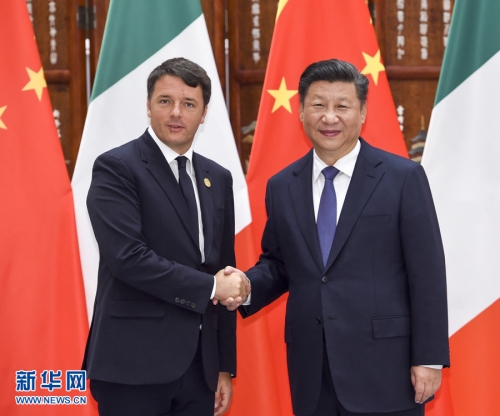
Italy Courting China is a Masterstroke of Chaos
Next week’s visit to Italy by Chinese Premier Xi Jinping has nearly everyone jittery. The recent announcement by Five Star Movement Leader Luigi Di Maio that his country is prepared to sign a Memorandum of Understanding with China to be a part of China’s ambitious Belt and Road Initiative has set off a firestorm of response from Donald Trump to Angela Merkel to Di Maio’s own coalition partner, Lega leader Matteo Salvini.
But, don’t let the wrapper fool you on this. Di Maio’s announcement I don’t think it ‘blindsided’ Salvini as this Reuters article suggests, as much as Merkel and Trump.
Even though Geraci is a member of the League, the group appeared blindsided when news of an imminent deal emerged last week, with party chief Matteo Salvini warning against the “colonialization” of Italy by China.
“We are reviewing it,” Salvini, who serves as joint deputy prime minister with Di Maio, said on Thursday. “Before allowing someone to invest in the ports of Trieste or Genoa, I would think about it not once but a hundred times.”
If anything, this announcement is a smart move by Di Maio. It puts Salvini a bit on the defensive who has been setting the tempo for the coalition recently. Salvini needs Trump on his good side to assist him in taking on Merkel and the European Union.
Merkel is trying to play hardball with Trump over energy issues, as I discussed in a recent article, by defending the Nordstream 2 pipeline from U.S. aggression as change the board state of geopolitics.
It’s clear that to me now that Merkel’s priorities for what is left of her term in office are as follows:
1. Carve out an independent path for EU foreign policy from the U.S. through the creation of an EU army, obviating the need for NATO and…
2. End U.S. occupation of Germany.
3. Secure Germany’s energy future, which also secures its political future as the leader of the European Union, by stitching together the continent with Russian energy arteries — Nordstream 2, Turkstream.
4. Manage the shift away from NATO as a controlling force in Europe’s relationship with Russia which doesn’t serve Europe’s long term purposes.
This while Trump and Xi are deep in the weeds on a trade deal that the entire world is watching the outcome of with bated breath. Hint: Trump will fold.
The EU just put off talks with the U.S. over the same issue, failing to deliver an opinion on whether to re-open trade talks with the U.S.
In a confusing vote, the European Parliament passed by a narrow majority a series of amendments against beginning talks, but then voted down its own resolution on the topic, meaning in effect it took no view.
The resolution would not have been binding, but parliament will have to approve any deal agreed and EU governments said they wanted to hear the view of lawmakers before deciding.
Because everything with the EU is so crystal clear on a normal day, right?
Now, Di Maio comes in and takes a major meeting with Xi looking for billions in Chinese investment to jump start Italian economic prospects.
Trump is already apoplectic over Nordstream 2 and is threatening to sanction some of the biggest companies in the world for being a part of the project. But, that ship has mostly sailed. The pipeline is over 70% complete.
About all the U.S. can do now is get the EU parliament to stop the pipeline delivering gas, wasting €11 billion building the thing. Like with Brexit or Crimea, there comes a point where those in opposition to something in the world they don’t like has to be accepted as de facto.
Unfortunately, the insane people who think they run the world won’t give up as long as there are lawyers to be deployed to complicate things.
This is why I love Di Maio’s move here. Trump is engaged in a trade war with China while complaining bitterly about Europe doing business with Russia. He’s even threatening them with a bill for housing our troops that we don’t want to remove.
Di Maio says Italy would be a great fit for China’s Belt and Road Project, which the U.S. is actively undermining all across Asia and the Middle East.
While at the same time he is thumbing his nose at Merkel who doesn’t want Italy to feel empowered on any level as they enter the European Parliamentary election season. Euroskeptics could take as much as a third of the seats, even without a hostage U.K. contingent.
Moreover, Merkel is still trying to talk out of both sides of her mouth with the U.S.:
Stand firm on Nordstream 2, try to save the JCPOA, on the one hand, but support the U.S.’s idiotic regime change operation in Venezuela to appease Trump.
This is a strong statement of independence by Italy as they join Hungary, Poland, Greece and Portugal, who all have MOU’s with China. And it’s not like Hungary and Poland are high on Merkel’s Christmas card list. Both are dealing with Article 7 proceedings to strip them of their EU voting rights.
From every angle it throws a wrench in the works internationally while being good politics domestically. If Xi leaves Rome without a deal it doesn’t necessarily mean Italy caved to outside pressure from Trump or Merkel, as much as it could signal that Xi simply asked for more than Italy was willing to give at this point.
And both sides realized that they were being used by the other as leverage with the people not in the room. Regardless, Xi coming to Rome and meeting with these European outsiders is a great statement on his part that China knows the imperial game Merkel and the Gang in Brussels is playing in the long run.
Join my Patreon and subscribe to the Gold Goats ‘n Guns Newsletter where geopolitics and portfolio management meet to help you navigate a very difficult period of history.
00:37 Publié dans Actualité, Affaires européennes, Géopolitique | Lien permanent | Commentaires (0) | Tags : italie, chine, europe, asie, affaires européennes, affaires asiatiques, politique internationale, géopolitique, diplomatie |  |
|  del.icio.us |
del.icio.us |  |
|  Digg |
Digg | ![]() Facebook
Facebook
Chine-Amérique : les trois fronts de la guerre économique voulue par Trump
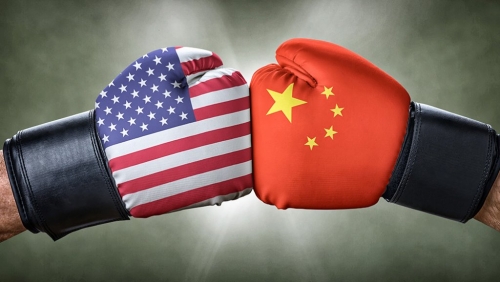
Chine-Amérique : les trois fronts de la guerre économique voulue par Trump
Jean-Raphaël Chaponnière
Ex: https://asialyst.com
En lançant sa guerre commerciale contre la Chine, le président américain Donald Trump souhaite en finir avec l'ordre économique mondial bâti par les États-Unis au sortir de la Seconde Guerre mondiale. (Source : USA Today)
Front commercial
Front industriel
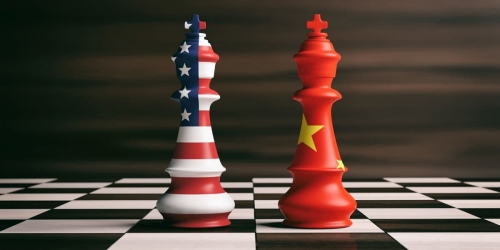
Front financier
Les conséquences d’une stratégie perdant-perdant
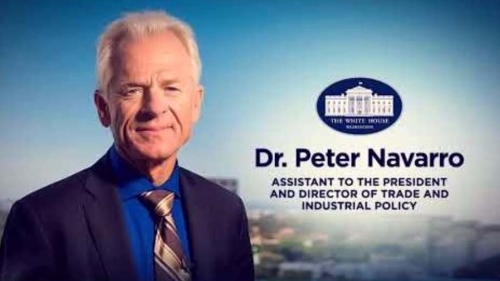
A propos de l'auteur
00:23 Publié dans Actualité, Géopolitique | Lien permanent | Commentaires (0) | Tags : chine, états-unis, guerre commerciale, politique internationale, géopolitique, asie, affaires asiatiques |  |
|  del.icio.us |
del.icio.us |  |
|  Digg |
Digg | ![]() Facebook
Facebook
jeudi, 14 mars 2019
City of Xi’an and Why the New Chinese Silk Road Terrifies the West?
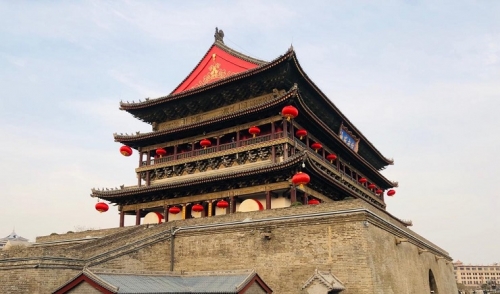
City of Xi’an and Why the New Chinese Silk Road Terrifies the West?
by Andre Vltchek
Ex: https://journal-neo.org
Snow is falling on the wide sidewalks of the historic city of Xi’an, but people don’t seem to be troubled by the bitter cold.
One of the oldest cities in China, Xi’an, is now vibrant, optimistic and stunningly beautiful. Sidewalks are paved with expensive stones and have more than enough space for pedestrians, electric bicycles, plants, trees and bus shelters.
Attempts by the Communist Party to turn China into an ‘Ecological Civilization’ are visible at every step: trees are revered and protected, comfortable walking is encouraged, while heavy duty, efficient and super modern public transportation is extremely cheap and ecological: the metro, and electric buses. All scooters are also electric, and so are the tricycles that are intended to transport passengers between the metro stations.
Compared to most Asian cities, but even to those in the United States and Europe, Chinese metropolises, including Xi’an, look like sort of urban areas of the future. But they are not ‘impersonal’, nor atomized. They are built for the people, not against them.
Xi’an is where the old Silk Road used to begin, connecting China to India, Central Asia and the Middle East.
It has a special significance and deep symbolism in Chinese history, and it is essential for China’s present and future.
Xi’an is the oldest of the four ancient capitals, and home to the Terracotta Army of Emperor Qin Shi Huang. This tremendous world heritage site is a titanic symbol of loyalty, endurance and optimism. According to the legend, the entire tremendous army followed its commander to the other life, ready to defend him, to fight for him and if necessary, to offer the ultimate sacrifice. What does it all really mean? Is it just an emperor that these brave warriors are ready to sacrifice their lives for, with smiles on their faces? Or is it the nation, or perhaps even the entire humanity they are determined to defend?
Whatever it is, it is enormous, and seeing the sheer size of the monument sends shivers all over my body.
*
Some fifty kilometers away, at the North Station of Xi’an City, an army of the fastest trains on earth is lined up at countless platforms. These beautiful bullet trains connect Xi’an with Beijing, Shanghai and soon, Hong Kong. Some of them are already speeding towards the city of Zhangye, which is the first step on the new rail Silk Road that will soon continue all the way towards the north-western tip of China, at Kashgar. And Kashgar is only 100 kilometers from the border with Kyrgyzstan, and 150 kilometers from Tajikistan.
If someone thinks that China is simply a north Asian country, far away from the rest of the world, they should think twice. In the center of Xi’an, there is a bustling neighborhood, similar to those found in any bustling city of the Middle East. There is a Grand Mosque, a bazaar, and endless lanes of colorful stalls, jewelry workshops, restaurants and halal eateries. Many women here wear colorful clothes and headscarves, while men cover their heads with skullcaps.
The western part of China is a vibrant mix of cultures from the north, as well as Central Asia. And the ancient capital of China – Xi’an – is well known and admired for its multi-cultural identity. Like the former Soviet Union, Communist China is an enormous and diverse country.
*
And the West doesn’t like what it sees.
It hates those super high-speed trains, which, at tremendous speed, as well as cheaply and comfortably, cover distances of thousands of kilometers. It hates where they are going: towards the former Soviet Central Asian republics, and soon, hopefully, towards Afghanistan, Pakistan, Iran, Russia, and one day, maybe even India.
It hates the optimistic spirit of the people of Xi’an, as well as the wise and at the same time, avant-garde environmental policies of China.
It hates that in cities like Xi’an, there are no slums, no homeless people, and almost no beggars: that instead of advertisements, there are beautiful paintings with messages highlighting socialist virtues, including equality, patriotism, respect for each other, democracy and freedom. It hates that most of the people here look determined, healthy, in good spirits, and optimistic.
The West passionately hates the fact that China is essentially Communist, with a centrally planned economy and tremendously successful social policies (by 2020, China will eliminate the last pockets of extreme poverty), even strive for the ecological civilization.
China defies Western propaganda, which hammers into the brains of the people that any socialist society has to be drab, uniform and infinitely boring. Compared to such a city as Xi’an, even the European capitals look dull, depressing, dirty and backward.
Yet China is not rich, not yet. At least on paper, (read: using statistics produced and controlled predominantly by the countries and by the organizations controlled by Washington, London and Paris), its HDI (Human Development Index, compiled by UNDP), is the same as Thailand’s. While the contrast between two countries is striking. Thailand, a feudal society glorified by the West, because of its staunch support during the Vietnam War and because of its anti-Communist drive, is suffering from collapsed infrastructure (no public transportation outside Bangkok, awful airports and train system), monstrous, almost ‘Indonesian-style’ city planning (or lack of it), urban slums, endless traffic jams and basically no control of the government over business. In Thailand, frustration is everywhere, and the murder rate is consequently even higher than in the United States (per capita, according to INTERPOL data), while in China it is one of the lowest on earth.
But above all, the West hates China’s growing influence on the world, particularly among the countries that have been for centuries brutalized and plundered by European and North American corporations and governments. And it is scared that they will, eventually, fully understand that China is determined to stop all forms of imperialism, and to eradicate poverty in all corners of the world.
*
Xi’an is where the old and new Silk Roads have their starting points. The new one is called the Belt Road Initiative (BRI), and very soon it will account for tens of thousands of kilometers of railroads and roads connecting and crisscrossing Asia, Africa and Europe, pulling out of misery billions of men, women and children. Once completed, everybody will benefit.
But that is not how the West likes it. ‘Everyone benefiting’ is a totally foreign, even hostile concept, at least in the Western capitals. Only the West, plus those few ‘chosen’ and highly obedient countries (including Japan, South Korea and Singapore) have been, until now, allowed to prosper, forming a strictly ‘by appointment only’ club of nations.
China wants everyone to be rich, or at least not poor.
Most Asians love the idea. Africans love it even more. The new elegant train station in Nairobi, Kenya, is a new symbol, a promise of a better future. Tram lines in Addis Ababa, the construction of a high-speed train line that will go through Laos, all these are marvels unimaginable only a few years ago.
The world is changing, mainly thanks to the determined efforts of China and Russia to finally destroy Western colonialism (the ‘project’ that began so well right after WWII, but, except on paper, was never fully completed).
*
Xi’an is rising. In the West, they used to say that life in China is improving, but only for Beijing, Shanghai and Guangdong.
Later they said, for the Pacific coast, OK, life is better, but go further West… Xi’an, Chengdu, Kunming and other cities followed.
Then, the propagandists regrouped: ‘Chinese cities are doing well, but the countryside is suffering’. Then came President Xi’s brainchild – ‘Ecological civilization’, and decisive reforms aimed at improving the standards of living and quality of life all over the most populous country on earth. In 2018, for the first time in modern history, there was a reverse migration from Chinese cities, to the rural areas.
One has to repeat again and again, until it sinks into people’s brains: After 2020, there will be no extreme misery in China.
In our upcoming book “China and Ecological Civilization”, a dialogue between me and leading philosopher John Cobb Jr, John who has been working very closely with the Chinese government on issues of environment and education, explained:
“As I compare China’s success in giving serious attention to the well-being of its natural environment and needy citizens with that of European countries, my reason for betting on China is that I have some confidence that it will maintain governmental control of finance and of corporations generally. If it does this, it can also control the media. Thus, it has a chance of making financial and industrial corporations serve the national good as perceived by people not in their service. Less centralized governments are less able to control the financial and other corporations whose short-term interests may conflict with the common good.”
That may be the main reason why the West is horrified, and trying to antagonize China by all means: If China succeeds, colonialism will collapse, but also corporatism, which, like a fairy-tale monster devours everything in its sight.
*
Facing thousands of determined Terracotta soldiers, I felt the enormity of China.
I imagined hundreds of millions of men and women building the nation; millions of construction sites, not only in China itself, but also abroad. I recalled my neighbors in Nairobi, when I used to live in Africa – optimistic, well-natured but tough Chinese engineers, who used to power-walk, together, every night. I liked, I admired their spirit.
To me, they were like present-day Terracotta soldiers: brave, determined and loyal. Loyal not to the emperor, but to humanity. Not military men, but people who are constructing, building a much better world in all corners of the globe, often with their own hands. Despite the vitriolic spite and nihilism unleased against them by the West.
In Xi’an, I stood in front of the old gate, where everything began, many centuries ago; the old Silk Road. Now, everything was returning here, in a grand circle. The new beginning.
It was cold. It was beginning to snow. But I was immensely happy to be here, and I felt alive and full of optimism for the future of humanity.
I made a few symbolic steps. Millions did before me. Millions will, again, soon.
Andre Vltchek is philosopher, novelist, filmmaker and investigative journalist. He’s a creator of Vltchek’s World in Word and Images, and a writer that penned a number of books, including China and Ecological Civilization. He writes especially for the online magazine “New Eastern Outlook.”
https://journal-neo.org/2019/02/20/city-of-xi-an-and-why-...
12:34 Publié dans Actualité, Géopolitique | Lien permanent | Commentaires (0) | Tags : routes de la soie, chine, asie, affaires asiatiques, géopolitique, politique internationale, eurasie, eurasisme |  |
|  del.icio.us |
del.icio.us |  |
|  Digg |
Digg | ![]() Facebook
Facebook
dimanche, 03 mars 2019
La Chine devient un arbitre mondial incontournable
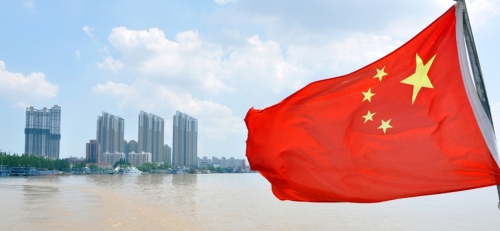
La Chine devient un arbitre mondial incontournable
par Jean-Paul Baquiast
Ex: http://www.europesolidaire.eu
L'incapacité manifestée le 31 janvier par Donald Trump pour faire céder le leader nord-coréen Kim Jong Un dans l'affaire du désarmement nucléaire vient d'en donner un exemple éclatant. Cet épisode a certes mis en valeur le manque de réalisme et l'immense maladresse de Trump lui-même. Mais elle a surtout montré qu'une Amérique considérée encore comme la première puissance mondiale n'avait plus désormais, sauf à déclencher une guerre nucléaire, la capacité de faire céder un petit Etat asiatique.
Dans cette affaire, la Chine est intervenue discrètement, autant que l'on sache, pour rappeler à Kim que si elle le soutenait politiquement, il ne devait pas abuser de ce soutien et qu'il devait en particulier tenir le plus grand compte des intérêts de la Corée du Sud et des autres Etats de la région. Comme la Chine est voisine de la Corée du Nord et que celle-ci avait toujours bénéficié de son aide, PyongYang n'est pas en mesure de refuser son arbitrage.
Sur de nombreux autres théâtres de confrontation entre les Etats-Unis et la Russie, le président chinois Xi Jinping, sans s'opposer directement au positions de son allié Vladimir Poutine, joue là aussi un rôle d'apaisement permettant de calmer l'hystérie anti-russe que Washington s'efforce de propager dans l'ensemble du monde occidental. Au Venezuela, la Chine et la Russie se sont opposées jusqu'ici avec succès aux efforts de Donald Trump pour renverser Nicolas Maduro. Plus généralement, la Chine qui a de plus en plus d'investissements en Amérique Latine, fera tout son possible pour éviter des tensions entre les pays de ce continent. Il en sera de même en Afrique.
Dans le début de guerre entre Inde et Pakistan, la Chine alliée de ce dernier pays, s'efforce actuellement d'éviter qu'une guerre de grande ampleur n'éclate entre Delhi et Islamabad. Ses intérêts, notamment dans le cadre de l'Obor, en seraient directement affectés. Mais elle veut également maintenir de bonnes relations avec l'Inde avec qui elle cohabite dans le cadre du Brics. On peut espérer que son intermédiation ramènera à la raison les deux adversaires.
Au Moyen-Orient, il semble bien que la diplomatie chinoise intervienne pour détendre les relations entre l'Iran, l'Irak et la Syrie.
La Chine dispose d'atouts importants pour se faire prendre au sérieux par les autres grandes puissances. Le milliard de chinois sont désormais réputés pour jouer la carte d'un développement mondial pacifique. On ne peut en dire autant du milliard d'hindous qui restent pénétrés d'un hindouisme religieux militant qui les pousse à s'opposer au reste du monde. Sur le plan des industries numériques et de la recherche scientifique avancée, la Chine est en voie de rattraper le retard qu'elle avait pris sur les Etats-Unis. Elle dispose par ailleurs d'un élément essentiel pour ce faire, les très nombreux chercheurs chinois qui travaillent dans les laboratoires américains et pourraient si consigne leur en était donnée, rejoindre rapidement leur pays d'origine. Concernant les industries spatiales et l'exploration de l'espace, si elle reste encore inférieure aux Etats-Unis, cette infériorité ne durera pas, car les crédits publics ne manquent pas. Ce qui n'est plus le cas désormais dans le spatial américain non militaire.
Inutile d'ajouter que l'Europe, et plus particulièrement la France, qui auraient pu également jouer ce rôle d'arbitre, en accord avec la Chine, ne le feront pas car elles sont et demeureront des american puppets.
Note. Sur la Chine, voir cet article se voulant rassurant de Bruno Guiguez https://francais.rt.com/opinions/59011-chine-sans-oeiller...
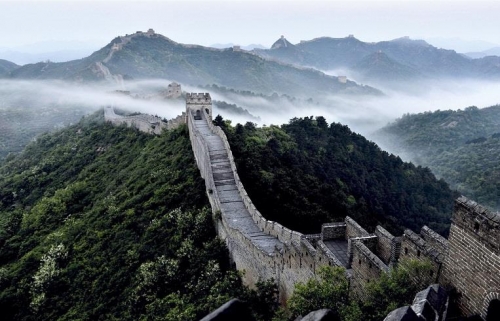
09:59 Publié dans Actualité, Géopolitique | Lien permanent | Commentaires (0) | Tags : actualité, politique internationale, géopolitique, chine, asie, affaires asiatiques |  |
|  del.icio.us |
del.icio.us |  |
|  Digg |
Digg | ![]() Facebook
Facebook
mardi, 12 février 2019
The Costs of Misunderstanding Iranian Foreign Policy
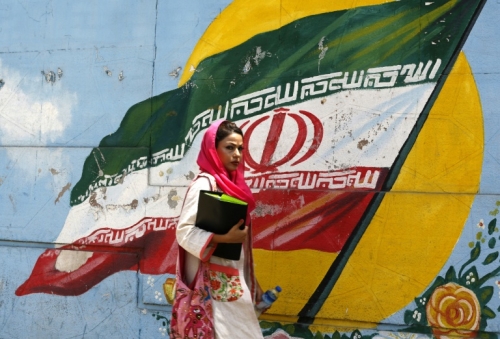
The Costs of Misunderstanding Iranian Foreign Policy
This is because, contrary to what many believe, Iran’s foreign policy today is largely shaped by its threat perceptions and interests—not ideology.
Because the contours of Iran’s foreign policy appear to be drawn primarily by security considerations, including deterrence and power projection, the United States isn’t likely to fundamentally change the country’s behavior.
American policymakers have several blind spots when it comes to understanding the behavior of other governments, especially when they consider them to be adversaries. The worst of these is the tendency to ascribe profound ideological motives to a regime’s leadership when they are usually concerned much more with self-preservation and protecting their national interests as they understand them. During the Cold War, many anticommunists imagined that the Soviets were much more bent on pursuing a revolutionary foreign policy than they actually were. Those who understood that Soviet foreign policy had a great deal of continuity with the policy of pre-revolutionary Russia were more likely to make sense of what the Soviets were likely to do and why they were doing it. Interpretations of other states’ behavior that reduce everything to the official ideology of that state are always going to miss the mark because the real reasons for their conduct are to be found elsewhere.
Prior to the negotiation of the nuclear deal, Americans were regularly treated to nonsensical “analysis” that portrayed Iran as a fanatical government prepared to commit national suicide in pursuit of its goals abroad. This “martyr-state” myth has thankfully been thoroughly debunked and discredited by events, but the fact that it flourished at all shows how determined many American policymakers and pundits are to perceive their adversaries as irrational, inflexible maniacs that cannot be deterred or reasoned with.
Iran hawks in the Trump administration still insist on describing Iran’s policies in terms of exporting revolution. Pompeo said as much in his widely-panned article for Foreign Affairs from last year:
The regime’s revolutionary mindset has motivated its actions ever since—in fact, soon after its founding, the IRGC created the Quds Force, its elite special forces unit, and tasked it with exporting the revolution abroad. Ever since, regime officials have subordinated all other domestic and international responsibilities, including their obligations to the Iranian people, to fulfilling the revolution.
As Tabatabai explains, this is a dated interpretation that ignores the changes in Iran and its government over the last four decades:
But a closer assessment of the regime’s foreign policy unveils a much more pragmatic Iran, one whose policies are nonetheless shaped by its historical experiences and culture.
The Trump administration can’t or won’t acknowledge the existence of this “much more pragmatic Iran,” because that would be an admission that their own uncompromising hard-line approach is unnecessary and harmful. They need to portray Iran as a destabilizing revolutionary state to make their obsessive hostility to Iran seem more defensible, but it is all based on a faulty understanding of the country and its government. That in turn has led to the administration’s preposterous demands that Iran radically alter its foreign policy, but that won’t ever happen because Iran considers its current policies to be important for their national security and for the survival of the regime. Far from being the self-destructive revolutionaries that Iran hawks want them to be, Iran’s leaders are interested in self-preservation above all else. The U.S. needs to have an Iran policy that takes that into account, or else we will continue to have a failing and bankrupt Iran policy that achieves nothing besides deepening the enmity between our governments.
00:29 Publié dans Actualité, Géopolitique | Lien permanent | Commentaires (0) | Tags : états-unis, iran, politique internationale, géopolitique, moyen orient, asie, affaires asiatiques |  |
|  del.icio.us |
del.icio.us |  |
|  Digg |
Digg | ![]() Facebook
Facebook
samedi, 09 février 2019
La stratégie perdante du Président Trump: Contrôler le Brésil et affronter la Chine
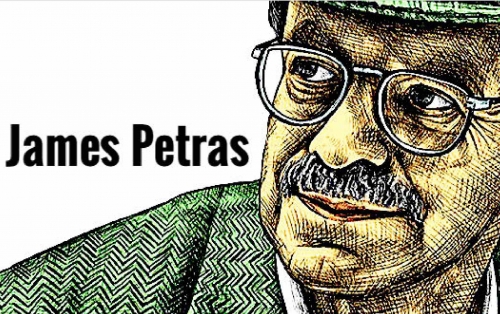
La stratégie perdante du Président Trump: Contrôler le Brésil et affronter la Chine
par James Petras
Traduit par le blog http://versouvaton.blogspot.fr
Les États-Unis adoptent un régime voué à l’échec et menacent l’économie la plus dynamique du monde. Le président Trump a fait l’éloge du président brésilien nouvellement élu, Jair Bolsonaro, et promet de promouvoir des liens économiques, politiques, sociaux et culturels étroits avec lui. En revanche, le régime Trump s’est engagé à démanteler le modèle de croissance de la Chine, à imposer des sanctions sévères et généralisées et à promouvoir la division et la fragmentation de la Chine élargie.
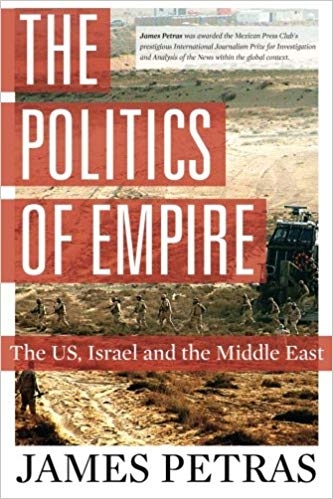
Le choix des alliés et des ennemis de Washington repose sur une conception étroite et à court terme des avantages et des pertes stratégiques.
Dans cet article, nous discuterons des raisons pour lesquelles les relations américano-brésiliennes s’inscrivent dans la poursuite de la domination mondiale de Washington et pourquoi Washington craint la croissance dynamique et le défi d’une Chine indépendante et compétitive.
Le Brésil à la recherche d’un Patron
Le président du Brésil, Jair Bolsonaro, a annoncé, dès le premier jour, un programme visant à inverser près d’un siècle de croissance économique dirigée par l’État. Il a annoncé la privatisation de l’ensemble du secteur public, y compris les activités stratégiques quelles soient financières ; bancaires ; minières : d’infrastructure ; de transport ; énergétiques ou manufacturières. De plus, cette vente en masse va donner la priorité aux sociétés multinationales étrangères. Les régimes civils et militaires autoritaires précédents protégeaient les entreprises nationalisées dans le cadre d’alliances tripartites comprenant des entreprises privées étrangères, étatiques et nationales.Contrairement aux précédents régimes civils élus qui s’efforçaient – pas toujours avec succès – d’augmenter les pensions, les salaires et le niveau de vie et de faire reconnaître la législation du travail, le Président Bolsonaro a promis de licencier des milliers d’employés du secteur public, de réduire les pensions et de relever l’âge de la retraite tout en abaissant les traitements et salaires afin de faire baisser les coûts et augmenter les profits pour les détenteurs de capitaux.
Le Président Bolsonaro promet d’inverser la réforme agraire, d’expulser, d’arrêter et d’agresser les familles paysannes afin de renforcer les propriétaires terriens et d’encourager les investisseurs étrangers à les remplacer. La déforestation de l’Amazonie et son transfert aux barons du bétail et aux spéculateurs fonciers entraîneront la saisie de millions d’hectares de terres indigènes.
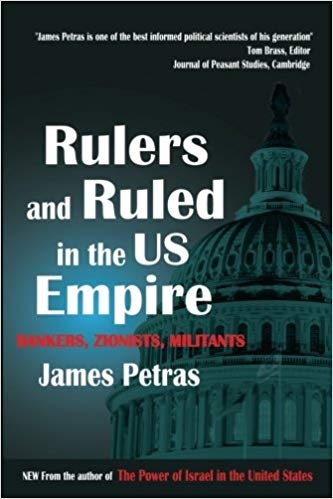
En matière de politique étrangère, le nouveau régime brésilien s’engage à suivre la politique américaine sur chaque question stratégique : Le Brésil soutient les attaques économiques de Trump contre la Chine, soutient l’accaparement des terres d’Israël au Moyen-Orient (y compris le transfert de sa capitale à Jérusalem), soutient les complots américains de boycott et les politiques visant à renverser les gouvernements de Cuba, du Venezuela et du Nicaragua. Pour la première fois, le Brésil a offert des bases militaires au Pentagone et des forces militaires pour toute invasion ou guerre à venir.
La célébration de la remise gratuite des ressources et des richesses par le président Bolsonaro et de l’abandon de souveraineté est célébrée dans les pages du Financial Times, du Washington Post et du New York Times qui prédisent une période de croissance, d’investissement et de reprise – si le régime a le « courage » d’imposer sa trahison.
Comme cela s’est produit lors de nombreuses expériences récentes de changement de régime néolibéral de droite en Argentine, au Mexique, en Colombie et en Équateur, les journalistes et experts des pages financières ont laissé leur dogme idéologique les aveugler face à d’éventuels pièges et crises.
Les politiques économiques du régime Bolsonaro ignorent le fait qu’elles dépendent des exportations agro-minérales vers la Chine et qu’elles sont en concurrence avec les exportations américaines… Les élites agro-industrielles brésiliennes vont s’indigner du changement de partenaires commerciaux… Elles s’opposeront, vaincront et mineront la campagne anti-Chinoise de Bolsonaro s’il ose persister.
Les investisseurs étrangers prendront le contrôle d’entreprises publiques, mais il est peu probable qu’ils puisse accroitre la production en raison de la forte réduction de l’emploi, des salaires et des traitements, à mesure que le marché de la consommation va chuter.
Les banques peuvent accorder des prêts, mais exigent des taux d’intérêt élevés pour des « risques » élevés, d’autant plus que le gouvernement sera confronté à une opposition sociale accrue de la part des syndicats et des mouvements sociaux, et à une violence accrue par la militarisation du contrôle de la société.
Bolsonaro n’a pas de majorité au Congrès, qui dépend du soutien électoral de millions de fonctionnaires, de salariés, de retraités et de minorités raciales et de genre. L’alliance du Congrès sera difficile sans corruption et sans compromis… Le cabinet de Bolsonaro comprend plusieurs ministres clés qui font l’objet d’une enquête pour fraude et blanchiment d’argent. Sa rhétorique anti-corruption s’évanouira face aux enquêtes judiciaires et aux révélations.
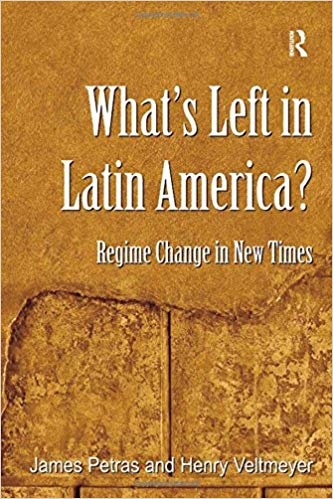
Il est peu probable que le Brésil fournisse des forces militaires significatives pour les aventures militaires régionales ou internationales des États-Unis. Les accords militaires avec les États-Unis n’auront que peu de poids face à la profonde agitation intérieure.
Les politiques néolibérales de Bolsanaro vont creuser les inégalités, en particulier parmi les cinquante millions de personnes qui sont récemment sorties de la pauvreté. La prise de contrôle du Brésil par les États-Unis enrichira Wall Street qui prendra l’argent et s’enfuira, laissant les États-Unis faire face à la colère et au rejet d’un allié dépouillé.
Les États-Unis face à la Chine
Contrairement au Brésil, la Chine n’est pas prête à se soumettre au pillage économique et à renoncer à sa souveraineté. La Chine suit sa propre stratégie à long terme qui se concentre sur le développement des secteurs les plus avancés de l’économie – y compris l’électronique de pointe et les technologies de communication.Les chercheurs chinois produisent déjà plus de brevets et d’articles scientifiques référencés que les États-Unis. Ils diplôment plus d’ingénieurs, de chercheurs de pointe et de scientifiques innovateurs que les États-Unis, grâce à des niveaux élevés de financement de l’État. La Chine, avec un taux d’investissement de plus de 44 % en 2017, surpasse de loin les États-Unis. La Chine a progressé, passant d’exportations à faible valeur ajoutée à des exportations à forte valeur ajoutée, y compris des voitures électriques à des prix compétitifs. Par exemple, les i-phones chinois font concurrence à Apple en termes de prix et de qualité.
La Chine a ouvert son économie aux multinationales américaines en échange de l’accès à une technologie de pointe, ce que Washington appelle des saisies « forcées ».
La Chine a encouragé la conclusion d’accords multilatéraux sur le commerce et l’investissement y compris avec plus de 60 pays dans le cadre d’accords à grande échelle et à long terme sur les infrastructures en Asie et en Afrique.
Au lieu de suivre l’exemple économique de la Chine, Washington se plaint du commerce déloyal, du vol technologique, des restrictions du marché et des contraintes étatiques sur les investissements privés.
La Chine offre à Washington des possibilités à long terme d’améliorer sa performance économique et sociale – si Washington reconnaît que la concurrence chinoise est une incitation positive. Au lieu d’investir massivement dans la modernisation et la promotion du secteur des exportations, Washington s’est tournée vers des menaces militaires, des sanctions économiques et des droits de douane qui protègent les secteurs industriels américains obsolètes. Au lieu de négocier pour des marchés avec une Chine indépendante, Washington prend le contrôle de régimes vassaux comme celui du Brésil sous le gouvernement du président nouvellement élu Jair Bolsonaro, qui compte lui sur le contrôle économique et les prises de contrôle américains.
Les États-Unis peuvent facilement dominer le Brésil pour des gains à court terme – profits, marchés et ressources, mais le modèle brésilien n’est ni viable ni durable. En revanche, les États-Unis doivent négocier, discuter et accepter des accords concurrentiels réciproques avec la Chine… Le résultat final de la coopération avec la Chine permettrait aux États-Unis d’apprendre et de se développer d’une manière durable.
Conclusion
Pourquoi les États-Unis ont-ils choisi la voie de contrôler un Brésil rétrograde et de négliger le rôle d’une future nation leader ?Fondamentalement, les États-Unis sont structurellement ancrés dans un système politique fortement militarisé qui est guidé par la quête de la domination mondiale – « l’impérialisme ». Les États-Unis ne veulent pas concurrencer une Chine innovante, ils cherchent à contraindre la Chine à démanteler les institutions, les politiques et les priorités qui font sa grandeur.
Washington exige que la Chine renonce à l’autonomie relative de l’État, augmente la pénétration de ses secteurs stratégiques par les États-Unis et s’appuie sur des banquiers et des universitaires adeptes du marché libre. La politique économique américaine est façonnée par des banquiers, des spéculateurs corrompus et des lobbyistes qui défendent des intérêts régionaux particuliers, y compris des régimes comme Israël. La politique économique de la Chine est façonnée par des intérêts industriels, guidés par les objectifs stratégiques de l’autorité d’un État centralisé, capable et désireux d’arrêter des centaines de hauts fonctionnaires à la volée.
Les États-Unis ne peuvent pas contenir la trajectoire ascendante de la Chine avec un encerclement militaire – parce que la stratégie économique de Pékin neutralise les bases militaires américaines et défait les contraintes douanières par la diversification de nouveaux accords commerciaux majeurs. Par exemple, la Chine négocie avec l’Inde pour augmenter considérablement les importations de produits agricoles, y compris le riz, le sucre, le lait, la farine de soja et le coton. L’Inde a actuellement un déficit commercial important avec la Chine, en particulier les machines et les produits industriels et est désireuse de remplacer les exportateurs américains. La Chine a conclu d’importants accords commerciaux et d’investissement en Asie du Sud-Est, Corée du Sud, Japon, Pakistan, Russie et Australie ainsi que dans les pays africains et d’Amérique latine (Brésil et Argentine) et au Moyen-Orient (Iran, Irak et Israël).
Les États-Unis n’ont que peu d’influence pour « contenir » la Chine, même dans les secteurs de haute technologie, car la Chine est moins dépendante du savoir-faire américain. Washington a conclu des accords avec la Chine, augmentant les exportations de voitures et de divertissements ; la Chine peut facilement accepter d’appliquer des mesures de lutte contre le « vol de propriété intellectuelle », d’autant plus que ce n’est plus un facteur important puisque la plupart des innovations chinoises sont créées au niveau national. De plus, les grandes entreprises et Wall Street exigent que le régime Trump parvienne à un accord d’ouverture des marchés avec la Chine et ignore ses ennemis autarciques.
Compte tenu de la vigueur soutenue de l’économie chinoise (6,5 % du PIB en 2018), de l’importance accrue accordée à l’expansion des services sociaux, du marché de la consommation et de l’assouplissement du crédit, les politiques douanières coercitives de Trump sont condamnées et les menaces militaires ne feront qu’encourager la Chine à étendre et à améliorer ses programmes militaires de défense et spatiaux.
Quels que soient les accords commerciaux temporaires et limités qui découleront des négociations entre les États-Unis et la Chine, le régime Trump poursuivra son programme impérial unipolaire de contrôle de régimes vassaux, comme le Brésil, et de lutte contre la Chine.
L’avenir appartient à une Chine indépendante, innovante et compétitive, et non à des régimes vassalisés, militarisés et soumis comme le Brésil.
James Petras
00:24 Publié dans Actualité, Géopolitique | Lien permanent | Commentaires (0) | Tags : états-unis, chine, brésil, amérique latine, amérique du sud, asie, affaires asiatiques, politique internationale, donald trump, géopolitique |  |
|  del.icio.us |
del.icio.us |  |
|  Digg |
Digg | ![]() Facebook
Facebook
samedi, 24 novembre 2018
Oude en Nieuwe Zijderoutes - Geopolitiek als drijvende kracht in de geschiedenis
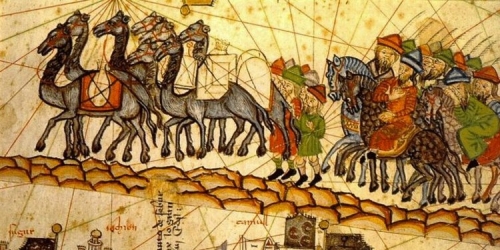
Oude en Nieuwe Zijderoutes
Geopolitiek als drijvende kracht in de geschiedenis
door Jonathan van Tongeren
Ex: http://www.novini.nl
Het onderstaande artikel is de tekst van een lezing gehouden op het 2e congres van het Geopolitiek Instituut Vlaanderen-Nederland (GIVN) op 17 november 2018 te Leuven.
526 jaar geleden bereikte een groep Spaanse schepen onder het commando van de 41-jarige Genuees Cristoforo Colombo (vernederlandst Christoffel Columbus) het eiland Guanahani. Dit geldt als de ‘ontdekking van Amerika’. De zeelui hadden een reis van 5.700 kilometer in het ongewisse achter zich en hun admiraal daarenboven nog dik zeven jaar aan overtuigingswerk aan de Spaanse en Portugese hoven.
Het idee om simpelweg naar het westen te varen om de oostkust van Azië te bereiken, stamde oorspronkelijk van de Griekse filosoof en naturalist Aristoteles. In de tijd daarna werd het idee onder andere door grootheden als Seneca, Roger Bacon en Pierre d’Ailly naar voren gebracht. In de 15e eeuw was het de Florentijnse geleerde Paolo dal Pozzo Toscanelli die er de grootste voorvechter van was. Tegelijk was de voorstelling van de aarde als schijf grotendeels obsoleet geworden. Zo schreef paus Pius II in zijn rond 1460 verschenen ‘Cosmographia’, dat onze planeet een bol is die om de zon draait. In zoverre zwom Columbus echt niet meer tegen de stroom in, toen hij in 1484 begon te werven voor een zeetocht naar Azië via het westen.
Constantinopel en het Iberisch schiereiland
Bovendien waren de geopolitieke verhoudingen in het Middellandse Zeegebied hem behulpzaam. Want door de Ottomaanse verovering van Constantinopel in mei 1453 was de route over land naar China en Indië afgesneden, wat de zoektocht naar nieuwe handelsroutes over zee enorm stimuleerde.
Overigens onderschatte Columbus de afstand tussen Europa en Oost-Azië ernstig. Hij meende dat de Canarische eilanden en Japan slechts 4.500 kilometer van elkaar verwijderd waren – in werkelijkheid was het 20.000. Verantwoordelijk hiervoor waren de onjuiste gegevens over de breedte van de Euraziatische landmassa van Toscanelli en D’Ailly, waarop Columbus zich baseerde. De respectievelijke deskundigen aan het Spaanse en Portugese hof zagen dit in, en ontrieden hun vorsten in eerste instantie de Genuees te ondersteunen bij zijn onderneming.
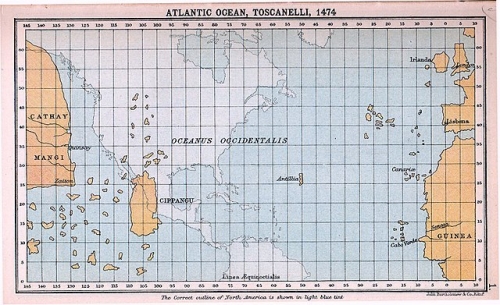
De kaart van Toscanelli over een hedendaagse kaart geprojecteerd
Toen kwam echter 2 januari 1492, de dag waarop de emir van Granada, Muhammad XII, capituleerde. Waarmee de Reconquista op het Iberisch schiereiland succesvol afgesloten werd. Nu groeide het verlangen van Isabella I van Castilië en León en Ferdinand II van Aragón, om de Portugese koning Johan II in te halen. Zijn zeevaarders tastten zich namelijk langs de kust van Afrika een weg naar Indië en leken daarbij kort voor een succes te staan.
Koopwaar
Columbus verlangde echter dermate veel privileges, dat de hele zaak daarop stuk dreigde te lopen. De Genuees verlangde namelijk de benoeming tot ‘admiraal van de oceaan’ als ook de titel van onderkoning en gouverneur-generaal van de door hem ontdekte gebieden. Bovendien stond hij erop, dat hij het recht zou hebben om van alle “parels, edelstenen, goud, zilver, specerijen als ook alle andere koop- en handelswaar die in zijn gebied gevonden, geplukt, verhandeld of gewonnen worden, na aftrek van de kosten, een tiende voor zichzelf te houden”. Uiteindelijk gaven Isabella en Ferdinand op advies van hun schatmeester Luis de Santángel op 17 april 1492 in de zogenaamde capitulatie van Santa Fe toe.
De voor de expeditie benodigde twee miljoen Maravedi’s (zo’n 300.000 euro) kwamen echter niet uit de schatkist van het koningspaar, maar grotendeels van het confederale politieleger Santa Hermandad (Heilige Broederschap). Daarnaast droegen Santángel en enkele Genuese kooplieden nog enkele honderdduizenden Maravedi’s bij. Van dat geld werden de grote driemaster (kraak) ‘Santa Maria’ en de twee karvelen ‘Niña’ en ‘Pinta’ gecharterd en van proviand voor een jaar voorzien. Daarnaast moesten circa 90 zeelieden ingehuurd en betaald worden.
De drie schepen verlieten in de morgen van 3 augustus 1492 de haven van Palos de la Frontera bij Huelva in Andalusië, waarbij de Santa Maria onder het bevel van Columbus zelf stond, terwijl de twee andere schepen onder het commando van Vicente Yáñez Pinzón en Martín Alonso Pinzón stonden. Om het beschadigde roer van de Niña te repareren en het grootzeil van de Pinta te vervangen, maakte Columbus weinig later halt in de haven van San Sebastián op het Canarische eiland La Gomera, om op 6 september aan de tocht dwars over de Atlantische Oceaan te beginnen.
Las Indias
In de daarop volgende weken zeilde de groep schepen met bestendige passaatwinden in de rug bij overwegend goed weer met een doorsnee snelheid van tien knopen naar het westen. De admiraal hoopte zo de door Marco Polo beschreven Chinese havenstad Quinsay, het huidige Hangzhou, te bereiken, waar hij de groot-khan brieven van zijn koninklijke opdrachtgevers Isabella en Ferdinand wilde overhandigen. Anders dan vaak onjuist gesteld wordt, was Columbus namelijk niet voornemens naar Indië zelf te varen, maar naar ‘Las Indias’, waarmee naast het eigenlijke Indië destijds ook alle landen ‘voorbij’ Indië (vanuit het westen gezien) bedoeld werden.
In de nacht van 11 op 12 oktober 1492 kreeg de joodse matroos Rodrigo de Triana alias Juan Rodriguez Bermejo van de Pinta een eiland in zicht, waarop de Genuees en zijn bemanning dan later op de dag voet aan wal zetten. Daarover lezen we in Columbus reisdagboek het volgende:
“Om 2 uur ’s morgens kwam het land in zicht, waarvan we zo’n acht zeemijlen verwijderd waren [..] Toen kwamen we bij elkaar en wachtten tot de dag aanbrak. Het was een vrijdag, waarop we voet aan wel zetten op een eiland, dat in de Indianentaal Guanahani heette.”
Met deze ontdekking ontsnapte de admiraal overigens aan een naderende muiterij, want veel van zijn mannen werd de reis, die ogenschijnlijk nergens naartoe leidde, met de dag ongemakkelijker. Om welk eiland het precies gaat, is tot op de dag van vandaag onduidelijk. Inmiddels gelden zowel het Watling-eiland dat sinds 1926 officieel de naam San Salvador heeft, als ook Samana Cay, Plana Cays en Mayaguana in de Bahama’s als mogelijke kandidaten.
Hoe het ook zij, Columbus voer aansluitend tot 16 januari 1493 door de Caraïbische Zee en ontdekte daarbij onder andere Cuba en Hispaniola. De terugtocht vond plaats zonder de Santa Maria, die op Kerstdag van het jaar daarvoor op een zandbank gelopen was. De overige twee schepen bereikten Palos op 15 maart 1493. Daarna werd Columbus als held gevierd.
Geopolitiek
Zo ziet u wat een ingrijpende gevolgen geopolitieke gebeurtenissen kunnen hebben. De verovering van Constantinopel door de Ottomanen en de voltooiing van de reconquista van het Iberisch schiereiland, leidden tot de ontdekking van Amerika. En enkele eeuwen later zou een voormalige kolonie in de Nieuwe Wereld uitgroeien tot de ‘laatste supermacht’.
Maar wat is nu eigenlijk geopolitiek? Het gebruik van de term geopolitiek lijkt de laatste jaren sterk in opkomst te zijn, nadat er enige tijd een taboe op rustte. Dat taboe kwam voort uit de associatie van geopolitiek met Duitse nationaalsocialistische noties als Lebensraum en Heim ins Reich. Een associatie kortom met een specifieke subjectieve en ideologische kijk op geopolitiek. Nu het taboe allengs afneemt, zien we het gebruik van de term sneller toenemen dan het verstaan ervan. Geopolitiek wordt dikwijls gebruikt als synoniem voor internationaal conflict. Of men veronderstelt dat het hoofdzakelijk over pijpleidingen en olie of andere delfstoffen gaat. Nu kunnen die zaken wel met geopolitiek te maken hebben, maar ze zijn niet zelf de geopolitiek. Kort gezegd gaat geopolitiek over de beheersing van geografische ruimtes. Waarbij beheersing uiteraard gradueel kan verschillen van invloed tot effectieve soevereiniteit. In het hiervoor besproken voorbeeld hebben we gezien hoe de beheersing van de geografische ruimtes van wat nu respectievelijk Turkije en Spanje zijn, leidde tot de opschorting van de Oude Zijderoute en een zoektocht naar een nieuwe zijderoute die zou leiden tot de ontdekking van de Nieuwe Wereld, oftewel de Amerika’s.
Enfin, geopolitiek dus, de beheersing van geografische ruimte. Denk maar aan het bordspel Risk, één van de manieren om verder te komen in het spel en kans te maken om te winnen, is het beheersen van continenten. In de geopolitieke realiteit is het niet veel anders. De Verenigde Staten beheersen bijvoorbeeld al geruime tijd het Noord-Amerikaanse continent en hebben stevige invloed in Latijns-Amerika, wat een goede uitgangspositie bood om uit te groeien tot de ‘enige supermacht’.
Eén van de lastigste continenten om onder controle te krijgen in het bordspel Risk is Azië. Ook in de geopolitiek ligt er een sterke focus op dit grote en centrale continent. Azië wordt gedomineerd door twee grootmachten: Rusland, dat zich in Europa bevindt, maar zich ook uitstrekt over Noord-Azië tot aan het Verre Oosten, en China. Mede daartoe gedreven door het westerse sanctiebeleid, is Rusland zich in de afgelopen jaren meer en meer op China gaan richten.
Oost-Azië
Het economisch expansieve China heeft van zijn kant te maken met een Amerikaans containmentbeleid, onder president Obama ‘pivot to Asia’ genoemd. De VS hebben een snoer van bondgenoten en meer halfslachtige partnerlanden in Oost-Azië gevormd, van Zuid-Korea tot Vietnam en verder richting India, waarmee China als het ware ingesnoerd wordt.
Juist de import en export over zee spelen echter een grote rol in de economische ontwikkeling van China. Het conflict in de Zuid-Chinese Zee draait dan ook in essentie niet om een handvol nietige eilandjes, maar om de vraag wie de zeewegen beheerst. De VS werpen zich wel op als kampioen van de vrije navigatie, maar het is veeleer China dat er vitaal belang bij heeft deze zeewegen open te houden.
Door de combinatie van containmentbeleid tegenover China en sanctiepolitiek tegenover Rusland, heeft het Westen deze twee grootmachten onbedoeld in elkaars armen gedreven en zo de consolidatie van een Euraziatische synergie in de hand gewerkt.
China heeft economisch echter zo’n sterke uitstraling in de regio, dat het niet alleen diverse Centraal-Aziatische landen aantrekt, maar dat ook diverse Zuidoost-Aziatische landen het containmentbeleid inmiddels doorbroken hebben. President Duterte van de Filipijnen nam hierin het voortouw en werd al snel gevolgd door de Maleisische regering en later zelfs de Japanse.
Zuid-Azië
China laat zich door dergelijke ontwikkelingen op de korte termijn echter niet in slaap sussen, maar houdt voor de langere termijn nog altijd rekening met een eventuele blokkade van cruciale zeewegen. Zo heeft het transportcorridors met autowegen, spoorwegen, pijpleidingen, diepzeehavens en olie- en gasterminals door Birma en Pakistan aangelegd, waardoor het toegang krijgt tot de Indische Oceaan, i.c. de Golf van Bengalen en de Arabische Zee, met omzeiling van de flessenhals van de Straat van Malakka.
Vanzelfsprekend vertegenwoordigen deze transportcorridors niet dezelfde capaciteit als die van de aanvoer langs de traditionele routes. Niettemin lijken andere spelers er het nodige aan te doen om deze Chinese strategie te doorkruisen. Zo laaide recent het conflict tussen de Rohingya-minderheid en de Birmese staat weer op, uitgerekend in die provincie waar zich de diepzeehaven van Kyaukpyu bevindt die voor China van belang is. Gewapende groeperingen, waarvan de leiders in Saoedi-Arabië zijn opgeleid, richtten dood en verderf aan in dorpen van andere etnische groepen en vielen militaire posten aan. De Birmese regering sloeg keihard terug, maar inmiddels geven ook westerse mensenrechtenorganisaties toe dat de Rohingya het conflict in gang hebben gezet.
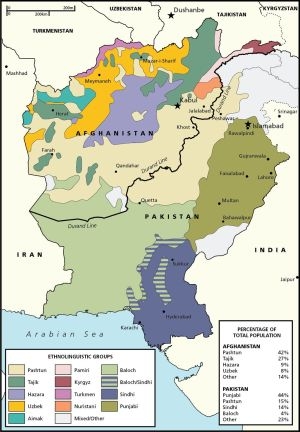 Ook de transportcorridor door Pakistan heeft met dergelijke destabilisaties te kampen. In deze regio strekken veel bevolkingsgroepen zich uit over de grens tussen Afghanistan en Pakistan, zodat instabiliteit in Afghanistan ook uitstraalt naar Pakistaanse regio’s.
Ook de transportcorridor door Pakistan heeft met dergelijke destabilisaties te kampen. In deze regio strekken veel bevolkingsgroepen zich uit over de grens tussen Afghanistan en Pakistan, zodat instabiliteit in Afghanistan ook uitstraalt naar Pakistaanse regio’s.
Ondanks de jarenlange militaire aanwezigheid van de Amerikanen in het land floreren ‘Islamitische Staat’ en de Taliban er nog altijd, zodat de vraag rijst of men soms belang heeft bij het in stand houden van deze groepen ter rechtvaardiging van voortdurende Amerikaanse militaire aanwezigheid. Ondertussen speelt Afghanistan weer een grote rol in de drugshandel en hebben de Amerikanen hier een stevige vinger in de pap. In diverse provincies bestaat daarnaast onvrede over de vermoedelijke exploitatie van mijnen, onder andere uranium, door de Amerikanen.
Centraal-Azië
De voortdurende Amerikaanse aanwezigheid in Afghanistan dient echter ook het indirecte nut, dat men door het instabiel houden van de regio de belangen van de grote concurrent China in deze regio doorkruist. Men onttrekt Afghanistan op deze wijze grotendeels aan de mogelijke economische synergie met China, Pakistan en de Centraal-Aziatische landen en bovendien hangt het schrikbeeld van het overslaan van islamistisch radicalisme naar andere landen in de regio als een donkere wolk boven de politiek van die landen.
Het zoeken naar nieuwe handelsroutes om te ontsluiten, lijkt de aangewezen weg voor China en dit is dan ook precies wat Peking doet. Zo wordt er sterk geïnvesteerd in de economische betrekkingen en de aanleg van nieuwe transportroutes naar Rusland en Siberië en diverse Centraal-Aziatische landen, in het kader van de zogenoemde Nieuwe Zijderoutes (let op: meervoud). Hiermee kan uiteindelijk bijvoorbeeld ook de verbinding over land gelegd worden met Iran en Turkije. Economisch niet onbelangrijke spelers die ieder op hun eigen manier een moeizame verhouding met de VS hebben.
Voor de verbindingen over land naar Voor-Azië en Europa is China echter afhankelijk van de samenwerking met diverse Centraal-Aziatische landen. De regeringen van deze landen zien hier het belang van in, ze hebben zelf baat bij de economische groei en de stabiliteit die dit met zich meebrengt. Dit is de steppe- en woestijnzone tussen de traditionele Russische en Chinese beschavingsgebieden. Hier zijn islamitische en grotendeels Turkse volkeren gevestigd. Dit is echter ook de zwakke plek van de Euraziatische integratie waarop de Amerikanen geregeld in proberen te spelen. Dit was bijvoorbeeld te zien in de Tulpenrevolutie in Kirgizië en we zien het ook in het opstoken van het separatisme onder de Oeigoeren in de noordwestelijke Chinese provincie Sinkiang.
Noord-Azië
Mede vanwege dit complex aan factoren is Rusland een waardevolle partner voor China. Rusland kent reeds een hoge mate van economische en militaire integratie met voormalige Sovjetrepublieken in Centraal-Azië en heeft op die wijze een stabiliserende werking. Daarnaast heeft Rusland goede relaties met traditionele vijanden van China in Azië, zoals India en Vietnam, die anders geheel onder Amerikaanse invloed zouden kunnen komen.
Verder heeft Rusland ook vanwege zijn geografische ligging China het nodige te bieden. Zo wordt er geïnvesteerd in het revitaliseren van de Trans-Siberische spoorlijn, die vertakkingen heeft naar Binnen-Mongolië en Mantsjoerije, maar aan de andere kant ook naar Finland. Hier liggen kansen voor Europa, zowel qua economische kosten als milieukosten ligt intensivering van de handel met Eurazië meer voor de hand dan de intercontinentale handel met Noord- en Zuid-Amerika (TTIP, CETA, Mercosur) waardoor de Europese Commissie in beslag genomen wordt. De Oostenrijkse en Slowaakse regeringen hebben in ieder geval concrete plannen om aan te sluiten op de Trans-Siberische spoorlijn, waarbij in Wenen een grote terminal moet komen voor de overslag naar Europees spoor of andere transportvormen.
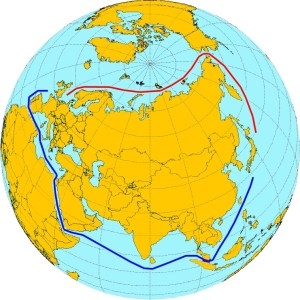 Nog groter is het potentieel van de zogeheten Arctische Zijderoute. Rusland en China verkennen in dit kader de mogelijkheden om de Noordoostelijke Doorvaart te gaan gebruiken. Het gaat om een potentiële scheepvaartroute langs de noordkust van de Russische Federatie, die de Stille Oceaan met de Atlantische verbindt via de Beringzee, de Oost-Siberische Zee, Karazee, Barentszzee en de Noorse Zee.
Nog groter is het potentieel van de zogeheten Arctische Zijderoute. Rusland en China verkennen in dit kader de mogelijkheden om de Noordoostelijke Doorvaart te gaan gebruiken. Het gaat om een potentiële scheepvaartroute langs de noordkust van de Russische Federatie, die de Stille Oceaan met de Atlantische verbindt via de Beringzee, de Oost-Siberische Zee, Karazee, Barentszzee en de Noorse Zee.
Dit heeft het grote (kosten)voordeel dat deze route voor vrachtschepen tussen China en Europa twee weken korter is dan de route door de Zuid-Chinese Zee, de Straat van Malakka, de Indische Oceaan, het Suez-kanaal en de Middellandse Zee. Daarnaast heeft het voor China het voordeel dat de route grotendeels door de Russische invloedssfeer verloopt en dus veel minder flessenhalzen kent dan de hierboven beschreven gangbare route.
Zo bezien komt ook de recente grootschalige NAVO-oefening Trident Juncture op IJsland, de Noorse Zee en in Noorwegen, zogenaamd tegen een eventuele Russische invasie gericht, in een geheel ander licht te staan. Maar dat terzijde.
Afrika
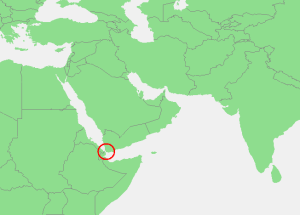 De Noordoostelijke Doorvaart biedt dus veel voordelen ten opzichte van de nu gangbare route. Het gebied rond het Suez-kanaal is momenteel immers bepaald instabiel. De Straat van Bab el Mandeb, die vanuit de Golf van Aden toegang geeft tot de Rode Zee en het Suezkanaal, ligt immers tussen Jemen enerzijds en Eritrea/Djibouti anderzijds. In Jemen voert een Arabische coalitie onder leiding van Saoedi-Arabië en met ondersteuning van de VS, het Verenigd Koninkrijk en Frankrijk een alles vernietigende oorlog tegen de Houthi-rebellen, waarvan valselijk beweerd wordt dat het Iraanse proxy’s zouden zijn. Iets zuidelijker ligt het door burgeroorlog verscheurde Somalië, van waaruit de piraten van al Shabab opereren. Door de komst van een nieuwe Ethiopische premier lijkt de spanning tussen Ethiopië en Eritrea en tussen Ethiopië en Egypte wat af te nemen, maar een recente (mislukte) moordaanslag op deze politicus maakt behoedzaam. China heeft intussen een militair steunpunt in Djibouti ingericht ter ondersteuning van de bestrijding van de piraterij. Diverse andere landen hebben ook militaire bases in het land en Turkije heeft sinds kort een basis in buurland Somalië om de regering daar te steunen. Vooralsnog is het roeien met de voor handen zijnde riemen, maar het mag duidelijk zijn dat een dermate volatiele regio, inclusief de militaire aanwezigheid van diverse grootmachten een riskante cocktail vormt. Dit maakt een alternatieve verbinding tussen Oost-Azië en Europa des te interessanter.
De Noordoostelijke Doorvaart biedt dus veel voordelen ten opzichte van de nu gangbare route. Het gebied rond het Suez-kanaal is momenteel immers bepaald instabiel. De Straat van Bab el Mandeb, die vanuit de Golf van Aden toegang geeft tot de Rode Zee en het Suezkanaal, ligt immers tussen Jemen enerzijds en Eritrea/Djibouti anderzijds. In Jemen voert een Arabische coalitie onder leiding van Saoedi-Arabië en met ondersteuning van de VS, het Verenigd Koninkrijk en Frankrijk een alles vernietigende oorlog tegen de Houthi-rebellen, waarvan valselijk beweerd wordt dat het Iraanse proxy’s zouden zijn. Iets zuidelijker ligt het door burgeroorlog verscheurde Somalië, van waaruit de piraten van al Shabab opereren. Door de komst van een nieuwe Ethiopische premier lijkt de spanning tussen Ethiopië en Eritrea en tussen Ethiopië en Egypte wat af te nemen, maar een recente (mislukte) moordaanslag op deze politicus maakt behoedzaam. China heeft intussen een militair steunpunt in Djibouti ingericht ter ondersteuning van de bestrijding van de piraterij. Diverse andere landen hebben ook militaire bases in het land en Turkije heeft sinds kort een basis in buurland Somalië om de regering daar te steunen. Vooralsnog is het roeien met de voor handen zijnde riemen, maar het mag duidelijk zijn dat een dermate volatiele regio, inclusief de militaire aanwezigheid van diverse grootmachten een riskante cocktail vormt. Dit maakt een alternatieve verbinding tussen Oost-Azië en Europa des te interessanter.
Voor Rusland heeft dit het bijkomende voordeel dat het een extra impuls kan geven aan de ontwikkeling van het hoge noorden. Zowel Siberië als het Noordpoolgebied herbergen nog veel niet geëxploiteerde bodemschatten, China is dan ook zeer geïnteresseerd in het investeren in de ontsluiting hiervan. Zo neemt China bijvoorbeeld al deel aan de recent begonnen productie van vloeibaar gas (LNG) op het schiereiland Jamal. Toen de Britten tijdens de koude van de afgelopen winter een aardgastekort hadden, moest een grote tanker met LNG van het Jamal-schiereiland aanrukken om de Britten, ondanks sancties en gezwollen retoriek, toch nog een behaaglijke Kerst te geven.
Europa
Met de extra capaciteit van de Nordstream II-pijpleiding zou er zo nodig natuurlijk, via Nederland, op goedkopere wijze meer aardgas naar Engeland geloodst kunnen worden. Of die pijpleiding definitief doorgaat, is echter nog altijd niet geheel duidelijk. Er wordt immense druk uitgeoefend op de betrokken Europese landen om er vanaf te zien. Economisch is de aanleg van Nordstream II echter zeer voor de hand liggend. Russisch aardgas is relatief dichtbij, de kosten voor het transport liggen laag, terwijl de prijzen voor het Russische gas ook goed zijn. Rusland niet gunstig gezinde EU-lidstaten als Polen en Litouwen kiezen er echter om politieke redenen voor te investeren in terminals om per schip veel duurdere LNG te kunnen importeren, bij voorkeur uit Amerika, dus met grote transportkosten en uit schaliegas, dus sowieso al duurder.
De strategische logica van de pijpleiding door de Oostzee is dat hiermee de afhankelijkheid van Oekraïne als doorvoerland verkleind wordt. Om politieke redenen willen verscheidene Europese politici dit niet. Als men de antipathie tegen Rusland even tussen haakjes zet, ligt – gezien de reputatie van Oekraïne voor het illegaal aftappen van gas, waardoor EU-lidstaten met tekorten te kampen hadden – niets meer voor de hand dan het omzeilen van Oekraïne. Door de logica van de oppositie tussen het westerse, Atlantische blok en het Russische blok, zou Europa er echter nog toe komen om in dezen tegen haar eigen belangen in te handelen, zoals Polen en Litouwen reeds voordoen.
Noord-Amerika
De Russische en Chinese investeringen in het Noordpoolgebied doen in de VS intussen reeds alarmbellen afgaan. Zo riep oud-staatssecretaris Paula Dobriansky (dochter van de beruchte Lev Dobriansky) het westerse bondgenootschap op zijn positie in het Noordpoolgebied te versterken en een militaire infrastructuur uit te bouwen. De VS hebben zelf immers maar een relatief kleine claim op het poolgebied, in de vorm van Alaska. Zodoende moeten NAVO-bondgenoten als Canada, Denemarken en Noorwegen er aan te pas komen – onder Amerikaanse leiding uiteraard.
Intussen worden er in de Groenlandse politiek concrete voorbereidingen getroffen voor afscheiding van Denemarken. Chinese bedrijven zijn in de arm genomen voor het winnen van de Groenlandse bodemschatten, maar Chinese aanwezigheid op het Noord-Amerikaanse continent zou natuurlijk een doorn in het oog van Amerika zijn. De Groenlandse regering heeft echter ten eerste de inkomsten uit de winning van haar delfstoffen nodig om financieel onafhankelijk te worden van Denemarken. Ten tweede bevindt de meest noordelijke luchtmachtbasis van de Verenigde Staten zich in Groenland. Van daaruit worden spionagevluchten boven Rusland uitgevoerd. Een verlies van deze positie zou de Amerikaanse greep op de Noordpool verder verslappen.
Slotwoord
We zien kortom dat er op diverse continenten een concurrentiestrijd gaande is tussen de Verenigde Staten en China, waarbij geopolitieke realiteiten als nabijheid, bereikbaarheid en de kostenefficiëntie van transport herhaaldelijk in botsing komen met gevestigde politieke voorkeuren en ideologische vooronderstellingen. Ik durf u echter wel te voorspellen dat de geopolitieke realiteiten de langere adem zullen blijken te hebben.
12:36 Publié dans Actualité, Affaires européennes, Eurasisme, Géopolitique, Histoire | Lien permanent | Commentaires (0) | Tags : actaulité, géopolitique, politique internationale, routes de la soie, europe, asie, affaires européennes, affaires asiatiques, eurasie, eurasisme, histoire |  |
|  del.icio.us |
del.icio.us |  |
|  Digg |
Digg | ![]() Facebook
Facebook
jeudi, 22 novembre 2018
Afghanistan. Guerre américaine ou paix russe
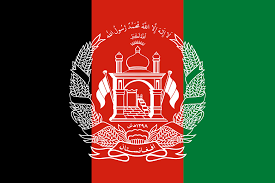
Afghanistan. Guerre américaine ou paix russe
par Jean-Paul Baquiast
Ex: http://www.europesolidaire.eu
L'on se souvient qu'en 1979 les troupes soviétiques, dans le cadre des accords de défense mutuelle qui liaient l'URSS à l'État afghan, ont répondu à l'appel du parti communiste au pouvoir, menacé par une rébellion armée.
Cette intervention a entraîné une forte résistance des rebelles, armés par les Etats-Unis, qui conduira après une longue guerre au retrait des forces soviétiques en 1989. En 1996, un gouvernement nationaliste islamique, dit des taliban avait pris le pouvoir. Il en a été chassé par une coalition internationale conduite par les Etats-Unis.
En 2004, le pays est devenu une république islamique de type présidentiel. Elle est encore très largement contrôlé par Washington, qui y a établi des bases militaires importantes. Mais l'opposition nationaliste islamique demeure partout présente. Elle dispose de moyens militaires non négligeable, vraisemblablement fournis par l'Iran. Elle aussi continue à revendiquer l'appellation de taliban. La présence militaire des Etats-Unis y est rendue de plus en plus difficile.
Cependant, ceux-ci n'entendent pas abandonner leur actuelle position dominante dans l'Afghanistan urbaine. Pour eux, l'Afghanistan dispose d'un intérêt stratégique essentiel, dans la perspective de la lutte qu'ils entendent encore mener contre la Russie. Géographiquement, elle dispose de frontières communes avec le Pakistan, le Tadjikistan et des autres Etats d'Asie centrale voisins de la Russie.
De plus elle possède des ressources naturelles considérables, encore mal exploitées. Pour Washington, s'y établir avec des implantations militaires durables permet à la fois de continuer à menacer la Russie actuelle et d'espérer pouvoir bénéficier à terme des perspectives économiques du pays.
Malheureusement pour eux, l'opposition que l'on continue d'imputer aux seuls taliban, se fait de plus en plus forte et impossible à contenir. On se souviendra que l'armée américaine avait lancé il y a quelques années contre eux une bombe classique présentée comme aussi puissante que la bombe Hiroshima, sans autres effets que tuer des civils.
L'élément nouveau que doit désormais prendre en compte Washington est le retour de la Russie. Mais celle-ci le fait non militairement mais diplomatiquement, avec un succès croissant. Moscou affirme qu'il ne cherche pas à substituer en Afghanistan l'influence russe à celle des Etats-Unis. Il dit vouloir seulement vouloir intervenir pour qu'une présence américaine reste compatible avec une influence russe pacifique, dans le cadre d'un complet accord tant du gouvernement de Kaboul que des taliban.
Conférence de Moscou
A cette fin, la Russie avait organisé avait organisé à Moscou une conférence de paix le 9 novembre, à laquelle ont participé notamment la Chine, l'Iran, le Pakistan, le Tadjikistan, l'Ouzbékistan et le Turkménistan. Une délégation de cinq membres, conduite par Sher Mohammad Abbas Stanakzaï, chef du conseil politique des taliban au Qatar, s'était rendu dans la capitale russe.Le gouvernement afghan, sous la pression américaine, n'y a pas été présent. Mais il a envoyé à Moscou des membres du Haut Conseil pour la paix, un organisme afghan chargé de superviser les efforts en vue de parvenir à un règlement politique du conflit. Bien évidemment, Washington avait refusé l'invitation.
La conférence de Moscou a été présentée par les Occidentaux comme un échec. Il est évident qu'il n'en est pas ressorti un accord pour une cessation immédiate des hostilités. Mais Moscou a fait admettre que tour accord de paix devrait dorénavant résulter d'une démarche commune américano-russe en ce sens. On peut penser que Donald Trump se ralliera à cette perspective, si du moins il peut l'imposer au Pentagone. Il s'était fait officieusement représenté à Kaboul par un envoyé spécial, Zalmay Khalilzad 1) diplomate américain connaissant bien l''Afghanistan où il semble avoir des intérêts personnels. Il y a retrouvé Zamir Kabulov, diplomate russe exerçant les fonctions d'envoyé spécial en Afghanistan, qu'il connaît lui-même très bien. 2)
Or pour Moscou et sans doute aussi pour les taliban et même le gouvernement de Kaboul la conférence du 9 novembre a été un succès. On lira ici sa déclaration. 3)
Reste à savoir quelle sera la réaction de Donald Trump. Se résignera-t-il à admettre une présence diplomatique américaine et russe conjointe en Afghanistan, ou cédera-t-il aux pressions du lobby militaro-industriel américain pour poursuivre la guerre. On peut penser qu'il choisira la première solution, au vu de l'hostilité grandissante des électeurs américains à l poursuite d'une guerre dont ils voient les coûts grandissants, y compris en termes de pertes humains, pour des avantages qui leur paraissent de plus en plus lointains.
Macron devrait en tous cas se rapprocher de la position de Moscou, s'il entendait comme il le dit voir la France continuer à jouer un certain rôle au Moyen Orient et en Asie centrale.
1) https://en.wikipedia.org/wiki/Zalmay_Khalilzad,
2) https://en.wikipedia.org/wiki/Zamir_Kabulov
3) https://actualite-news.com/fr/international/asie/6901-la-...
00:24 Publié dans Actualité, Géopolitique | Lien permanent | Commentaires (0) | Tags : asie, affaires asiatiques, politique internationale, géopolitique, afghanistan, états-unis, russie |  |
|  del.icio.us |
del.icio.us |  |
|  Digg |
Digg | ![]() Facebook
Facebook
mardi, 20 novembre 2018
Le Sri Lanka, enjeu géopolitique important

Le Sri Lanka, enjeu géopolitique important
par Jean-Paul Baquiast
Ex: http://www.europesolidaire.eu
L'ancien homme fort du pays, le chef du gouvernement Mahinda Rajapakse, avait accepté de nombreux prêts chinois pour la construction d'infrastructures semble-t-il démesurées. Cet endettement a fait que fin 2017, le Sri Lanka avait concédé pour 99 ans le port de Hambantota, dans le sud de l'île, à une société d'Etat chinoise en échange de l'effacement d'un peu plus de 1 milliard d'euros de dettes.
Or l'Inde et derrière elle les Etats-Unis, voient avec inquiétude la transformation possible de l'île en étape des « nouvelles routes de la soie » chinoises empruntant la voie maritime. Pékin a été l'une des rares capitales à avoir félicité Mahinda Rajapakse lorsqu'il a été nommé premier ministre fin octobre 2018.
Nous n'entrerons pas ici dans les détails fort compliqués de la vie politique du Sri Lanka et des luttes d'influences qui s'y exercent entre les différentes communautés politiques et religieuses. Disons seulement que la situation s'est tendue depuis que le président du Sri Lanka, Maithripala Sirisena, avait limogé, le 26 octobre, son premier ministre Ranil Wickremesinghe pour le remplacer par Mahinda Rajapakse. Or celui-ci, souvent présenté comme l'homme de Pékin, se voit aussi reprocher de nombreux faits de corruption.
Mais le remplacement ne s'est pas fait comme prévu, le chef du gouvernement sortant Ranil Wickremesinghe a refusé de quitter son poste de même que sa résidence officielle. Par ailleurs il bénéficie toujours d'une majorité au Parlement. Le président Maithripala Sirisena avait essayé de dissoudre la Chambre et d'organiser des élections anticipées. Mais la Cour suprême vient d'invalider ces décrets présidentiels.
Le pays est paralysé et nul ne sait qui le gouverne. Fin octobre, le Sri Lanka avait deux premiers ministres, celui qui refusait de partir, Ranil Wickremesinghe, et celui qui venait d'être nommé, Mahinda Rajapakse. Aujourd'hui, constitutionnellement, il n'en a plus aucun. Mahinda Rajapakse n'a pas le soutien du Parlement et Ranil Wickremesinghe a perdu celui du président Maithripala Sirisena. Ceci d'autant plus que Ranil Wickremesinghe envisagerait de se porter candidat à la présidence du pays fin 2019, alors que l'actuel président souhaite le rester. Les deux hommes multiplient les accusations l'un contre l'autre. Mais les citoyens du Sri Lanka restent, si l'on peut employer ce terme, dubitatifs.
Rappelons que Mahinda Rajapakse, accusé de népotisme, de corruption et de crimes de guerre lorsqu'il était président entre 2005 et 2015, avait écrasé la rébellion des Tigres tamouls en 2009. L'armée sri-lankaise qu'il dirigeait a été accusée d'avoir torturé, violé et tué des civils.
Il convient de suivre avec attention l'évolution de la crise actuelle. Elle pourra indiquer notamment sous quelle influence, indo-américaine ou chinoise, pourrait à l'avenir se retrouver le pays.
11:19 Publié dans Actualité, Géopolitique | Lien permanent | Commentaires (0) | Tags : actualité, géopolitique, politique internationale, sri lanka, ceylan, asie, affaires asiatiques |  |
|  del.icio.us |
del.icio.us |  |
|  Digg |
Digg | ![]() Facebook
Facebook
vendredi, 09 novembre 2018
La Chine et les Ouïghours
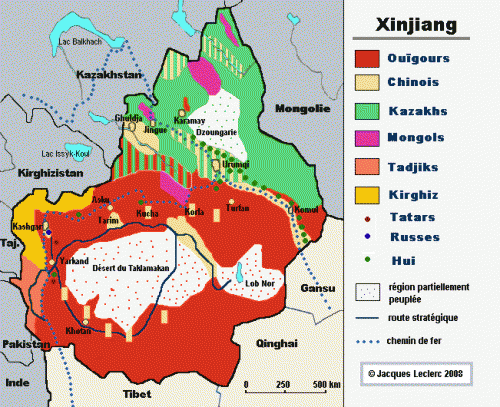
La Chine et les Ouïghours
Les médias occidentaux se taisent : dans l’Empire du Milieu, on combat fermement l’islamisme
Par Georg Immanuel Nagel
En Chine, l’immense majorité de la population est d’ethnie han mais il y a tout de même beaucoup de minorités. La seule qui, aux yeux du gouvernement chinois actuel, pose problème est une ethnie turque (turcophone), celle des Ouïghours, qui vit dans la région du Sin Kiang. Les neuf millions d’Ouïghours se sentent proches des autres peuples turcophones, ont adopté les mêmes symboles nationaux et, surtout, partagent avec eux la même foi islamique. Le mouvement islamiste global intervient également dans le Sin Kiang, si bien que cette province est, depuis un certain temps déjà, la proie du terrorisme et d’une violence au quotidien.
La situation est d’autant plus tendue que le Sin Kiang, sur son flanc occidental, a des frontières avec le Pakistan et l’Afghanistan, ce qui a pour conséquence que les réseaux terroristes ne manquent jamais de logistique et d’approvisionnements. L’objectif politique des Ouïghours est d’obtenir l’indépendance du « Turkestan oriental », comme ils appellent leur zone de peuplement, et d’en faire une théocratie islamique. Ils espèrent avoir gain de cause en utilisant des méthodes sanglantes. Outre les assassinats ciblés, les musulmans du Sin Kiang envisagent d’autres modes d’agression, comme les viols collectifs. A plusieurs reprises des désordres de grande ampleur et des émeutes ont eu lieu. Ensuite, les autorités chinoises reprochent aux Musulmans de ne participer que très modérément à la vie économique et d’avoir une tendance très généralisée à carotter, à éviter toute profession constructive.
En superficie, le Sin Kiang est la plus grande des régions de Chine mais elle est peu peuplée. Tout comme au Tibet, Beijing pratique une politique de « grand remplacement » de la population pour contraindre les petits peuples récalcitrants à s’étioler, à abandonner le terrain. Contrairement aux esprits confus des gauches européennes, les Chinois savent pertinemment bien que les immigrations massives et les mixages, qui en résultent, ne produisent pas un « paradis multiculturel » mais détruisent la population qui subit cette immigration. En 1955, les Ouïghours représentaient encore 73% de la population du Sin Kiang ; en 2010, ils n’étaient plus que 45%.
La première mesure prise contre les djihadistes a été d’interner de nombreux agitateurs et prédicateurs haineux. Par l’introduction de lois sévères, on a plus ou moins interdit l’islamisme. Les écoles coraniques au statut douteux et les mosquées qui prêchaient la terreur ont dû fermer leurs portes. Il est désormais illégal de donner aux enfants des prénoms à connotation religieuse. Les Ouïghours deviendront-ils dès lors le premier peuple musulman, où un homme sur deux ne se prénommera pas Mohammed ? En plus, le port de la barbe chez les hommes et du voile chez les femmes a été mis à l’index. L’oisiveté, l’absence de métier ou d’emploi, très répandue, va être combattue par les autorités chinoises, par la rééducation dans des centres de formation professionnelle. De très nombreux extrémistes sont désormais obligés de se rendre dans ces centres pour y apprendre à devenir de braves citoyens chinois, travailleurs et consciencieux. Des programmes obligatoires ont été établis, non seulement pour offrir aux islamistes oisifs des perspectives d’emploi, mais aussi pour les resocialiser et pour corriger leurs comportements, jugés aberrants par les autorités chinoises, au point de les soumettre, le cas échéant, à des traitements psychiatriques. L’objectif de ces programmes drastiques est d’éviter la constitution de sociétés parallèles animées par le radicalisme islamiste.
Tous ceux qui ont un comportement « séparatiste », selon les autorités chinoises, sont visés, par exemple, ceux qui n’envoient pas leurs enfants dans les écoles officielles, qui prêchent des doctrines extrêmes ou tentent de forcer d’autres à des pratiques religieuses, risquent bien, à court terme, de gagner un séjour gratuit dans une institution contrôlée par l’Etat.
Dans ce cadre, il est curieux de constater que les Ouïghours reçoivent le soutien de l’Occident (censé combattre le radicalisme islamiste). Les médias mainstream ne présentent l’affaire que dans une seule optique : ils déplorent les mesures prises par les Chinois contre les extrémistes ouïghours mais n’évoquent jamais le terrorisme qui les a provoquées. Les médias occidentaux présentent les Ouïghours comme de pauvres agneaux innocents, méchamment discriminés pour leur foi inoffensive. En Europe centrale, nous avons reçu, récemment, un enrichissement ouïghour car, à Munich, s’est établi le siège du « Congrès mondial des Ouïghours » ; auparavant, les animateurs de cette association pouvaient en toute légalité circuler en Turquie. Le mouvement ouïghour en exil a la réputation d’être soutenu par la CIA.
L’association, établie à Munich, est toutefois beaucoup plus influente aux Etats-Unis. L’Oncle Sam s’engage à chaque occasion en faveur des Ouïghours. Ainsi, la diplomate américaine Kelley Currie a prononcé un discours particulièrement agressif contre la Chine lors d’une assemblée de l’ONU, portant contre elle de nombreuses accusations. D’après Currie, les mesures que prennent les Chinois sont contraires aux droits de l’homme et les Ouïghours sont injustement placés sous le joug de Beijing et discriminés.
Ce discours tonitruant de Madame Currie laisse sous-entendre que ces islamistes ouïghours, comme d’autres groupes fondamentalistes auparavant, sont sciemment promus par Washington pour faire avancer les stratégies géopolitiques du Pentagone. Créer des conflits intérieurs en Chine puis stigmatiser les Chinois en les posant comme des oppresseurs brutaux constitue une stratégie qui entre bien dans l’ordre du jour des stratèges américains, qui, depuis longtemps déjà, cherchent à freiner l’expansion du dragon chinois dans le monde.
Georg Immanuel Nagel.
(article paru dans « Zur Zeit », Vienne, n°42/2018 – http://www.zurzeit.at ).
00:52 Publié dans Actualité | Lien permanent | Commentaires (2) | Tags : xinjiang, sinkiang, asie, asie centrale, affaires asiatiques, chine, ouïghours, turkestan chinois, fondamentalisme islamiste |  |
|  del.icio.us |
del.icio.us |  |
|  Digg |
Digg | ![]() Facebook
Facebook
jeudi, 08 novembre 2018
Le plan russo-sino-européen pour contourner les sanctions pétrolières contre l’Iran
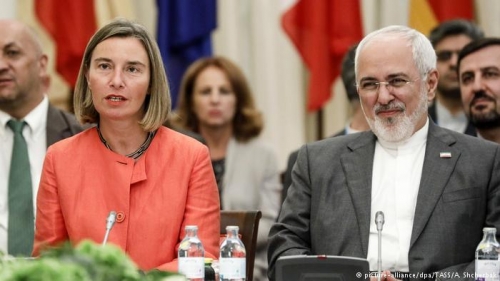
Le plan russo-sino-européen pour contourner les sanctions pétrolières contre l’Iran
par William Engdahl
Ex: http://www.zejournal.mobi
Il se peut fort bien que la politique unilatérale de la terre brulée menée par l’administration Trump donne un résultat tout à fait contraire à ce que l’on attend. La décision de Washington d’abandonner l’accord nucléaire iranien et d’imposer des sanctions sévères aux entreprises qui commercialisent du pétrole iranien, à partir du 4 novembre, crée de nouvelles voies de coopération entre l’UE, la Russie, la Chine et l’Iran et potentiellement d’autres pays. La récente déclaration de responsables bruxellois sur la création d’un Special Purpose Vehicle (SPV) non spécifié pour éviter légalement le commerce du pétrole en dollars américains et donc les sanctions américaines, pourrait potentiellement marquer le début de la fin de la domination du système dollar dans l’économie mondiale.
Selon les rapports des derniers pourparlers bilatéraux germano-iraniens à Téhéran, le 17 octobre, les mécanismes d’une structure spéciale qui permettrait à l’Iran de continuer à tirer profit de ses exportations de pétrole commenceront à être mis en œuvre dans les prochains jours. Fin septembre, Federica Mogherini, responsable de la politique étrangère de l’UE, a confirmé son intention de créer un tel canal commercial indépendant, notant qu’« aucun pays souverain ou organisation ne peut accepter que quelqu’un d’autre décide avec qui vous êtes autorisé à faire du commerce ».
Ce SPV serait calqué sur le système de troc soviétique utilisé pendant la guerre froide pour éviter les sanctions commerciales américaines, où le pétrole iranien serait en quelque sorte échangé contre des marchandises, sans échange d’argent. L’accord SPV impliquerait l’Union européenne, l’Iran, la Chine et la Russie.
Selon divers rapports de l’UE, le SPV implique un système de troc sophistiqué qui permet d’éviter les sanctions du Trésor américain. Par exemple, l’Iran pourrait expédier du pétrole brut à une entreprise française, accumuler des crédits par l’intermédiaire du SPV, un peu comme une banque. Un intermédiaire financier multinational soutenu par l’Union européenne serait mis en place pour traiter les transactions avec les entreprises intéressées par des transactions avec l’Iran et avec les parties iraniennes. Ces transactions ne seraient pas visibles par les États-Unis et impliqueraient des euros et des livres sterling plutôt que des dollars.
C’est une réponse extraordinaire à ce que Washington appelle une politique de guerre financière totale contre l’Iran, qui inclut des menaces de sanctions contre les banques centrales européennes et le réseau de paiements interbancaires SWIFT basé à Bruxelles si ils maintiennent des liens avec l’Iran après le 4 novembre. Dans les relations qui existent entre l’Europe de l’Ouest et Washington depuis 1945, de telles mesures agressives n’ont jamais été prises auparavant, ce qui oblige les principaux cercles politiques de l’UE à repenser les choses en profondeur.
Une nouvelle architecture bancaire
Le contexte de cette mystérieuse initiative a été présenté en juin dans un rapport intitulé « L’Europe, l’Iran et la souveraineté économique : nouvelle architecture bancaire en réponse aux sanctions américaines ». Le rapport a été rédigé par l’économiste iranien Esfandyar Batmanghelidj et Axel Hellman, membre de l’European Leadership Network (ELN), un groupe de réflexion politique basé à Londres.
Le rapport propose que la nouvelle architecture comporte deux éléments clés. Tout d’abord, elle s’appuiera sur des « banques passerelles » désignées pour servir d’intermédiaires entre les banques commerciales iraniennes et celles de l’UE liées à l’entité ad hoc. Le deuxième élément est qu’elle serait supervisée par un bureau de contrôle des actifs étrangers de l’UE ou EU-OFAC, sur le modèle du Trésor américain, mais utilisé pour faciliter le commerce légal UE-Iran, et non pour le bloquer. Ce système UE-OFAC, entre autres fonctions, consisterait à créer des mécanismes de certification pour garantir les entreprises faisant de tels échanges commerciaux et à « renforcer les protections juridiques européennes pour les entités engagées dans le commerce et l’investissement en Iran ».
Le SPV utiliserait des Gateway Banks spécifiques, des banques de l’UE non affectées par les « sanctions secondaires » de Washington car elles ne font pas d’affaires aux États-Unis et se concentrent sur les affaires avec l’Iran. Il peut s’agir de banques régionales allemandes appartenant à l’État, de certaines banques privées suisses telles que la Europäisch-Iranische Handelsbank (EIH), une banque européenne créée spécifiquement pour le financement du commerce avec l’Iran. En outre, certaines banques iraniennes ayant des bureaux dans l’UE pourraient être utilisées.
Quel que soit le résultat final, il est clair que les actions belliqueuses de l’administration Trump contre le commerce avec l’Iran forcent les grands pays à coopérer, ce qui pourrait entraîner la fin de l’hégémonie du dollar qui a permis à un gouvernement américain endetté de financer une tyrannie mondiale au détriment des autres.
UE-Russie-Chine….
Lors de la récente Assemblée générale des Nations unies à New York, Federica Mogherini a déclaré que le SPV a été conçu pour faciliter les paiements liés aux exportations de l’Iran – y compris le pétrole – tant que les entreprises impliquées exerçaient des activités légitimes en vertu du droit communautaire. La Chine et la Russie sont également impliquées dans le SPV. La Turquie, l’Inde et d’autres pays pourraient y adhérer par la suite.
Immédiatement, comme prévu, Washington a réagi. Lors d’une réunion avec l’opposition iranienne aux Nations unies, le secrétaire d’État américain Mike Pompeo, ancien chef de la CIA, a déclaré qu’il était « troublé et même profondément déçu » par le projet européen. Il a notamment déclaré : « C’est l’une des mesures les plus contre-productives que l’on puisse imaginer pour la paix et la sécurité régionales et mondiales. » Le plan de Washington pour une guerre économique contre l’Iran est-il vraiment conçu pour favoriser la paix et la sécurité régionales et mondiales ?
Un SWIFT non étasunien ?
L’une des armes les plus brutales de la batterie de guerre financière du Trésor américain est la capacité de forcer le système de compensation interbancaire privé SWIFT, basé à Bruxelles, d’empêcher l’Iran de l’utiliser. Cela a eu un effet dévastateur en 2012 lorsque Washington a fait pression sur l’UE pour que SWIFT se soumette, un grave précédent qui a déclenché l’alarme partout dans le monde.
Le fait que le dollar américain demeure la monnaie dominante pour le commerce international et les transactions financières donne à Washington un pouvoir extraordinaire sur les banques et les entreprises du reste du monde. C’est l’équivalent financier d’une bombe à neutrons. Cela pourrait être sur le point de changer, même si ce n’est pas encore chose faite.
En 2015, la Chine a dévoilé son système CIPS (China International Payments System). À l’origine, le CIPS était considéré comme une future alternative chinoise à SWIFT. Il offrirait des services de compensation et de règlement à ses participants pour des opérations et des paiements transfrontaliers en Renminbi. Malheureusement, une crise boursière chinoise a forcé Pékin à revoir ses plans à la baisse, bien qu’il y ait un squelette d’infrastructure.
Dans un autre domaine, depuis fin 2017, la Russie et la Chine ont discuté de la possibilité de relier leurs systèmes de paiements bilatéraux en contournant le dollar. Le système Unionpay de la Chine et le système de paiement intérieur de la Russie, connu sous le nom de Karta Mir, seraient directement reliés.
Plus récemment, les principaux cercles politiques de l’UE se sont fait l’écho de ces idées sans précédent dans l’ère post-1944. En août, se référant aux actions unilatérales des États-Unis pour bloquer le pétrole et d’autres échanges commerciaux avec l’Iran, le ministre allemand des Affaires étrangères, Heiko Maas, a déclaré à Handelsblatt, un grand quotidien économique allemand, que « l’Europe ne devrait pas permettre aux États-Unis d’agir au-dessus de nos têtes et à nos dépens. Pour cette raison, il est essentiel que nous renforcions l’autonomie européenne en établissant des canaux de paiement indépendants des États-Unis, en créant un Fonds monétaire européen et en mettant en place un système SWIFT indépendant ».
Une fissure dans l’édifice du dollar
Jusqu’où l’UE est disposée à défier Washington sur la question du commerce avec l’Iran n’est pas encore clair. Il est fort probable que Washington, par l’intermédiaire de la NSA et d’autres moyens, puisse avoir accès aux échanges entre l’UE, l’Iran, la Russie et la Chine dans le cadre du SPV.
Outre les récentes déclarations du ministre allemand des Affaires étrangères, la France envisage d’étendre le SPV iranien afin de créer un moyen de protéger les économies de l’UE contre les sanctions extraterritoriales illégales, comme les sanctions secondaires qui punissent les entreprises européennes faisant des affaires en Iran en les empêchant d’utiliser le dollar ou de faire affaire aux États-Unis. La porte-parole du ministère français des Affaires étrangères, Agnès Von der Mühll, a déclaré qu’en plus de permettre aux entreprises de continuer à commercer avec l’Iran, le SPV « créerait un outil de souveraineté économique pour l’Union Européenne au-delà de ce seul cas. Il s’agit donc d’un plan à long terme qui protégera, à l’avenir, les entreprises européennes des effets de sanctions extraterritoriales illégales ».
Si tel est le cas de la nouvelle structure ad hoc de l’UE, cela créera une fissure béante dans l’édifice du dollar. Se référant au SPV et à ses implications, Jarrett Blanc, ancien responsable du département d’État sous Obama et impliqué dans la négociation de l’accord nucléaire iranien, a noté que « le mécanisme de paiement ouvre la porte à une dégradation à long terme du pouvoir des sanctions américaines ».
L’UE a fait preuve d’une rhétorique effrénée et de vociférations véhémentes contre la guerre économique unilatérale des États-Unis et l’imposition extraterritoriale de sanctions telles que celles contre la Russie. Mais sa détermination à prendre des mesures énergiques pour créer une véritable solution de rechange a, jusqu’à présent, été absente. Il en va de même à d’autres égards pour la Chine et la Russie. La guerre des sanctions américaines incroyablement brutale contre l’Iran va-t-elle enfin marquer le début de la fin de la domination du dollar sur l’économie mondiale qu’elle exerce depuis Bretton Woods, en 1945 ?
J’ai l’impression qu’à moins que le SPV, sous quelque forme que ce soit, n’utilise les avantages technologiques remarquables de certaines des technologies du Blockchain ou d’autres comme celles du XRP ou de Ripple, basé aux États-Unis, qui permettraient d’acheminer les paiements transfrontaliers de façon sécuritaire et presque instantanée à l’échelle mondiale, il n’aura que peu d’effet. Ce n’est pas que les programmeurs informatiques européens n’ont pas l’expertise nécessaire pour développer de tels logiciels, et encore moins les Russes. Après tout, l’une des principales entreprises de Blockchain a été créée par un Canadien d’origine russe nommé Vitalik Buterin. La Douma russe travaille sur une nouvelle législation concernant les monnaies numériques, même si la Banque de Russie y semble toujours fermement opposée. La Banque populaire de Chine est en train de développer et de tester rapidement une cryptomonnaie nationale, le ChinaCoin. Les technologies de Blockchain sont encore largement méconnues, même dans les cercles gouvernementaux tels que la Banque centrale russe qui devrait voir en elle bien plus qu’une nouvelle « bulle des mers du Sud ». La capacité d’un système de paiement supervisé par l’État à échanger des monnaies au-delà des frontières, totalement crypté et sécurisé, est la seule réponse plausible à court terme aux sanctions unilatérales et aux guerres financières jusqu’à ce qu’un ordre plus civilisé entre les nations soit possible.
Traduit par Wayan, relu par Cat pour le Saker Francophone
- Source : New Eastern Ourlook (Russie)
00:29 Publié dans Actualité, Affaires européennes, Economie | Lien permanent | Commentaires (0) | Tags : politique internationale, géopolitique, finance, devises, économie, russie, europe, iran, chine, affaires européennes, asie, affaires asiatiques |  |
|  del.icio.us |
del.icio.us |  |
|  Digg |
Digg | ![]() Facebook
Facebook
vendredi, 26 octobre 2018
El problema del uigur en China - La parte no mencionada
Ex: http://www.elespiadigital.com
En los últimos meses, los medios de comunicación occidentales y la Administración de Washington han empezado a aumentar el tono y el llanto por los supuestos campos de internamiento en masa en el noroeste de China, donde supuestamente hasta un millón de chinos uigures chinos están siendo detenidos y sometidos a diversas formas de "reeducación" Varias cosas sobre estas acusaciones son notables, entre otras cosas, todas se originan en los medios de comunicación occidentales o en las ONG "demócratas", como Human Rights Watch, cuyo historial de veracidad deja mucho que desear.
En agosto, Reuters publicó un artículo titulado "La ONU dice que tiene informes creíbles de que China tiene millones de uigures en campamentos secretos ". Una mirada más cercana al artículo no revela una declaración oficial de la ONU, sino más bien una cita de un miembro estadounidense de un Comité “independiente” que no habla en nombre de la ONU: Resulta que la fuente de la acusación es una ONG asesora independiente de las Naciones Unidas llamada Comité para la Eliminación de la Discriminación Racial. La única persona que hizo la acusación es la miembro del comité estadounidense Gay McDougall, dijo que estaba "profundamente preocupada" por esos "informes creíbles", pero McDougall no citó ninguna fuente para sostener tan dramática acusación.
Reuters en su artículo refuerza su reclamo citando a una turbia ONG con sede en Washington DC, los Defensores de los Derechos Humanos de China (CHRD). En una excelente investigación de sus antecedentes, los investigadores del Proyecto Grayzone descubrieron que el CHRD obtiene cientos de miles de dólares de gobiernos anónimos. La notoria ONG del gobierno de los Estados Unidos, National Endowment for Democracy, está en la lista de los sospechosos habituales. Cabe destacar que el discurso oficial de CHRD es el de Human Rights Watch, que también recibe fondos de la fundación Soros .
El 'problema uigur'
El verdadero estado de los asuntos en la provincia china de Xinjiang con respecto a los uigures no es posible verificarlo de forma independiente, si existen tales campamentos y, de ser así, quién está allí y bajo qué condiciones. Sin embargo, lo que se sabe es el hecho de que las agencias de inteligencia de la OTAN, entre ellas Turquía y Estados Unidos, junto con Arabia Saudita, han estado involucradas en el reclutamiento y despliegue de miles de musulmanes uigures chinos para unirse a Al Qaeda y otros grupos terroristas en Siria en años recientes. Este lado de la ecuación merece una mirada más cercana, es el lado omitido por Reuters o la embajadora de la ONU Haley.
Según los medios sirios citados en Voltaire.net, en la actualidad hay aproximadamente 18,000 uigures étnicos en Siria concentrados en una aldea en la frontera turca con Siria. Desde 2013, dichos soldados uigures han abandonado el combate junto a Al Qaeda en Siria y han regresado a Xinjiang de China, donde han llevado a cabo varios actos terroristas . Esta es la punta de un desagradable proyecto vinculado a la OTAN para plantar las semillas del terror y el malestar en China. Xinjiang es un eje de la Iniciativa Belt Road de China, la encrucijada de los oleoductos y gasoductos estratégicos de Kazajstán, Rusia y un objetivo principal de la intriga de la CIA desde hace décadas.
Turquía, al menos desde 2011, al comienzo de la guerra de la OTAN contra la Siria de Bashar al Assad, desempeñó un papel clave en facilitar el flujo de personas uigures chinas para convertirse en jihadistas en Siria. Utilizo deliberadamente el "desempeñó" para dar beneficio de la duda si todavía es el caso hoy o si se ha convertido en una vergüenza para Erdogan y la inteligencia turca. En cualquier caso, parece que miles de uigures están escondidos en Siria, la mayoría alrededor de Idlib, el último puesto de avanzada de terroristas en contra del régimen.
Washington y el ETIM
En un excelente análisis de la historia de terror uigur de China, Steven Sahiounie, periodista sirio del 21st Century Wire, señala que una organización clave detrás de la radicalización de la juventud uigur china es el Movimiento Islámico del Turquestán Oriental (ETIM) y su frente político, el Partido Islámico del Turquestán (TIP), también conocido como "Katibat Turkistani". Cita un discurso pronunciado en Estambul en 1995 por el entonces alcalde de Turquía, Erdogan, quien declaró: "Turquestán Oriental no es sólo el hogar de los pueblos turcos, sino también la cuna de la historia, la civilización y la cultura turcas....". Turkestán oriental es Xinjiang.
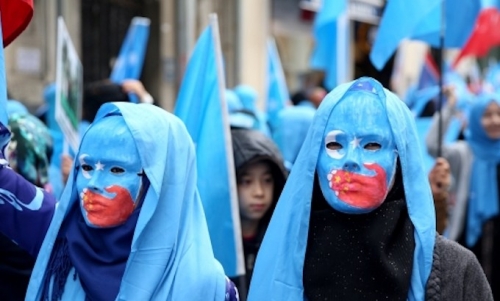
Hoy en día, el ETIM está encabezado por Anwar Yusuf Turani, autoproclamado Primer Ministro de un gobierno en el exilio que reside principalmente en Washington DC. ETIM se mudó curiosamente a Washington en un momento en que el Departamento de Estado de los Estados Unidos lo catalogó como una organización terrorista. De acuerdo con un informe publicado en una revista de investigación turca, “las actividades de la organización de Turani para el gobierno en el exilio se basa en un informe titulado El Proyecto de Xinjiang”. Eso fue escrito por el ex oficial superior de la CIA Graham E. Fuller en 1998 para Rand Corporation y revisado en 2003 bajo el título "El problema de Xinjiang"”
He escrito extensamente en mi libro, The Lost Hegemon, sobre el agente de la CIA Graham Fuller. El ex jefe de la estación de la CIA en Estambul, Fuller, fue uno de los arquitectos del asunto Irán-Contra de Reagan-Bush, y uno de los principales patrocinadores o gestores de la CIA que facilitó el exilio en los EE. UU. de Gülen. También, estaba según lo ha reconocido, en Estambul la noche del fallido golpe de Estado de 2016. En 1999, al final de la era Yelstin rusa, Fuller declaró: “La política de guiar la evolución del Islam y de ayudarlos contra nuestros adversarios funcionó maravillosamente bien en Afganistán contra los rusos. "Las mismas doctrinas todavía pueden usarse para desestabilizar lo que queda del poder ruso, y especialmente para contrarrestar la influencia china en Asia Central". Esto es a lo que se dirige la encubierta arma estadounidense del ETIM. Como la mayoría de los grupos yihadistas sunitas radicales, el ETIM de Turani obtuvo fondos de los grupos sunitas radicales de Arabia Saudita.
A fines de la década de 1990, Hasan Mahsum, también conocido como Abu-Muhammad al-Turkestani, fundador del Movimiento Islámico de Turkestán Oriental, trasladó la sede de ETIM a Kabul, refugiándose en el Afganistán controlado por los talibanes. En Afganistán, los líderes de ETIM se reunieron con Osama bin Laden y otros líderes de Al Qaeda, los talibanes y el Movimiento Islámico de Uzbekistán, entrenados por la CIA, para coordinar acciones en Asia Central. Cuando el ejército paquistaní asesinó a al-Turkestani en 2003, Turani se convirtió en jefe de ETIM y llevó su sede a Washington.
En su propio estudio de Xinjiang, Graham E. Fuller, observó que los grupos de Arabia Saudita habían diseminado la literatura religiosa extremista wahabí y posiblemente armas pequeñas a través de simpatizantes en Xinjiang, y que los jóvenes musulmanes turcos habían sido reclutados para estudiar en las madrasas en Pakistán, Afganistán y Arabia Saudita. Añade que los uigures de Xinjiang también lucharon junto a Al Qaeda de Osama bin Laden en Afganistán en la década de 1980.
Fuller señaló: "Los uigures están realmente en contacto con grupos musulmanes fuera de Xinjiang, algunos de ellos se han radicalizado en una política yihadista más amplia en el proceso, unos pocos estuvieron involucrados anteriormente en guerrilla o entrenamiento terrorista en Afganistán, y otros están en contacto con Mujahideen musulmanes internacionales luchando por las causas musulmanas de independencia en todo el mundo".
El documento político de la Estrategia de Defensa Nacional del Pentágono de enero de 2018 nombró explícitamente a China junto con Rusia como las principales "amenazas" estratégicas para la supremacía de los Estados Unidos. Afirma que "la competencia estratégica entre estados, no el terrorismo, es ahora la principal preocupación en la seguridad nacional de los Estados Unidos". De manera explícita, y esto es nuevo, el periódico del Pentágono no cita una amenaza militar sino económica. Afirma: "China y Rusia ahora están socavando el orden internacional desde el interior del sistema al explotar sus beneficios al mismo tiempo que socavan sus principios y 'reglas ” La escalada de la guerra comercial contra China, las amenazas de sanciones sobre las denuncias de los campos de detención uigur en Xinjiang, las amenazas de sanciones si China compra equipos de defensa rusos, todo está destinado a interrumpir la única amenaza emergente para un orden global de Washington, que no se basa sobre la libertad o la justicia, sino sobre el miedo y la tiranía. Cómo las autoridades de China están tratando de lidiar con este asalto completo es otro tema. El contexto de los acontecimientos en Xinjiang, sin embargo, debe quedar claro. Occidente, y especialmente Washington, participa en una guerra irregular a gran escala contra la estabilidad de China.
*consultor de riesgos estratégicos y profesor. Es licenciado en política por la Universidad de Princeton
00:31 Publié dans Actualité, Eurasisme, Géopolitique | Lien permanent | Commentaires (0) | Tags : actualité, politique internationale, chine, asie, affaires asiatiques, ouighours, turkestan chinois, sinkiang, asie centrale, eurasisme, géopolitique |  |
|  del.icio.us |
del.icio.us |  |
|  Digg |
Digg | ![]() Facebook
Facebook



